Paul van Yperen's Blog, page 108
October 21, 2022
Written by Selma Lagerlöf
Today, we start a new series of weekly posts on the silent Swedish cinema. Selma Lagerlöf (1858-1940) was a Swedish writer, who became best known for her children's book 'Nils Holgersson's Wondrous Journey'. Her other novels would form the basis for several masterpieces of the silent Swedish cinema, directed by Victor Sjöström and Mauritz Stiller. In 1909 she was the first woman to receive the Nobel Prize in Literature, and in 1914 she became a member of the Swedish Academy, the committee that awards the Nobel Prize in Literature. In 1917, A-B Svenska Biografteater signed a contract with Lagerlöf to bring one of her works to the screen each year. In the coming weeks, there will be posts on actor Lars Hanson, loved by some film historians as "Lars Handsome" and on films by Victor Sjöström and Mauritz Stiller.
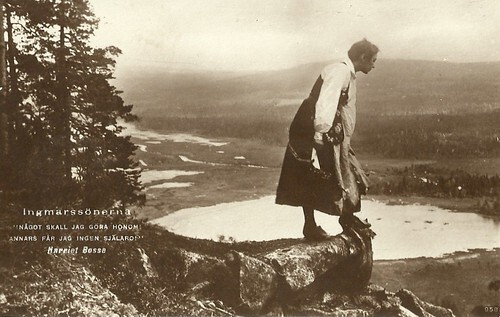
Swedish postcard by Nordisk Konst, Stockholm, no. 958/8. Harriet Bosse in Ingmarssönerna/Sons of Ingmar (Victor Sjöström, 1919). Caption: I have to do something or I won't find any rest in my soul.
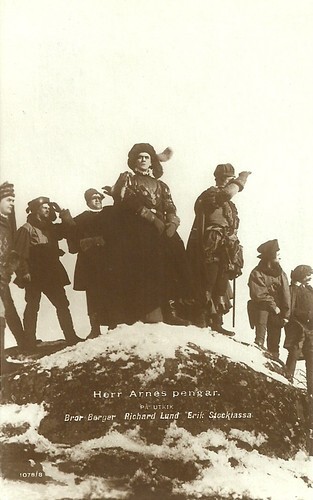
Swedish postcard by Nordisk Konst, Stockholm, no. 1078/8. Richard Lund , Bror Berger and Erik Stocklassa in Herr Arnes pengar/Sir Arne's Treasure (Mauritz Stiller, 1919). Caption: On the Lookout.
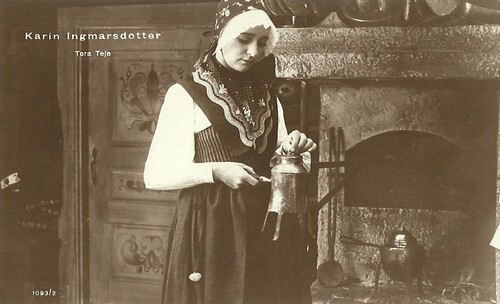
Swedish postcard by Nordisk Konst, Stockholm, no. 1093/2. Photo: Svenska Biografteatren. Tora Teje in Karin Ingmarsdotter/God's Way/Karin Daughter of Ingmar (Victor Sjöström, 1920).
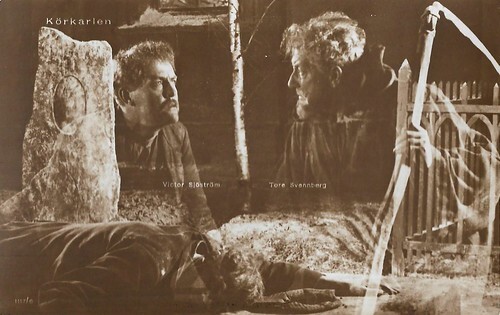
Swedish postcard by Förlag Nordisk Konst, Stockholm, no. 1117/6. Photo: Svensk Filmindustri. Victor Sjöström and Tore Svennberg in Körkarlen/The Phantom Carriage, (Victor Sjöström, 1920).
[image error]
German postcard by Trianon-Film, 1924. Photo: Svenska-Film. Mona Mårtenson in Gösta Berlings saga/The Atonement of Gosta Berling (Mauritz Stiller, 1924).
A wave of romantic nationalist literature in Sweden
Selma Ottilia Lovisa Lagerlöf was born at Mårbacka Manor in Östra Ämtervik in Värmland, Sweden, in 1858. She was the fifth of six children of Lieutenant Erik Gustaf Lagerlöf and Elisabet Lovisa Wallroth. She was born with a hip injury caused by a lack of proper attachment of the joint ball in her hip. When Lagerlöf was three and a half years old, in the summer of 1862, she became ill and completely paralysed in both legs. This disappeared as suddenly as it had come, but during her childhood, she did not find it as easy to play as other children. Like many other children in a bourgeois environment at the time, the Lagerlöf siblings received their education at home, as the new public school system was not fully developed. Their teachers came to Mårbacka to teach, and Lagerlöf was taught both English and French.
Selma Lagerlöf was a serious and gifted child and enjoyed reading. The first novel she read was an Indian book, 'Osceola' by Thomas Mayne Reid - and at the age of seven, she decided to become a writer. When one of her benefactors, Sophie Adlersparre, encouraged her to write in prose did she do so - and became a writer. She entered the Higher Teacher Training College in Stockholm, against her father's wishes, in the autumn of 1882. During Lagerlöf's education, the family became insolvent and Mårbacka had to be sold. Her father died in 1885, the same year Lagerlöf finished her teacher training.
When Lagerlöf studied literary history, she suddenly realised that the characters and fates she had heard about during her childhood in Värmland were as imaginative as Bellman's and Runeberg's cast of characters. But it took several years and many unsuccessful attempts at writing before she made her debut as a writer. After completing her education, Selma Lagerlöf taught at the Elementary School for Girls in Landskrona from 1885 to 1895. Lagerlöf enjoyed being a teacher and was appreciated by her students. Selma Lagerlöf had the ability to tell children in a captivating way about each new country they read about, or about Jesus and his disciples.
Selma Lagerlöf was 33 years old when her debut novel 'Gösta Berlings Saga' was published in 1891 after winning a prize competition in the magazine Idun. 'Gösta Berling's tale' is one of the greatest classics of Swedish literature - a rich and fantastic tale of the Cavaliers and life in Värmland in the 19th century. Her novel broke with the stylistic ideals of the time, which advocated realistic objectivity and she started a wave of romantic nationalist literature in Sweden in the 1890s. The book received a mixed reception from critics. In 1895 Lagerlöf left her teaching post. From then on she supported herself entirely by writing, and in 1897 she moved with her aunt to Falun to be closer to her sister Gerda.
Together with Sophie Elkan, Lagerlöf made several long trips in Europe and in 1899-1900 an extended trip to the Middle East. On her return, she wrote the novel 'Jerusalem' (1901-1902), which became her great international breakthrough. Lagerlöf's most internationally known book is 'Nils Holgerssons underbara resa genom Sverige' (Nils Holgersson's Wonderful Journey) (1906-1907), which was originally commissioned and published as a textbook for elementary schools. In it, we experience the geography of Sweden through the eyes of a fourteen-year-old boy, Nils Holgersson, who flies over the country on the back of a goose.
In 1909, Selma Lagerlöf was awarded the Nobel Prize for Literature in 1909. She was awarded the prize, according to the Academy, "because of the noble ideality, the richness of imagination and the soulfulness of representation that characterise her poetry". She lived in the town of Sunne, where two hotels are named after her. She passed away in 1940 in Mårbacka, near Sunne, where a museum is located today. Although Lagerlöf is associated with Mårbacka, she lived and worked in Falun for many years, and it was there that she wrote some of her greatest works. Even after she moved back to Mårbacka, she returned to Falun several times a year.
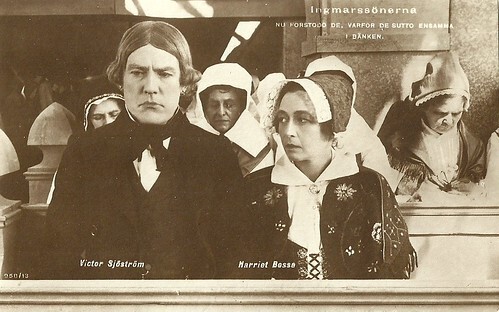
Swedish postcard by Nordisk Konst, Stockholm, no. 958/13. Harriet Bosse and Victor Sjösström in Ingmarssönerna/Sons of Ingmar (Victor Sjöström, 1919). Caption: Now they understood why they were sitting alone on the bench.
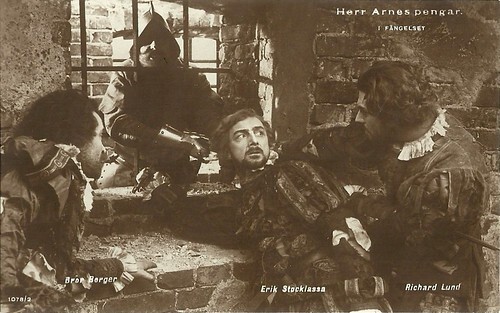
Swedish postcard by Nordisk Konst, Stockholm, no. 1078/2. Richard Lund , Bror Berger and Erik Stocklassa in Herr Arnes pengar/Sir Arne's Treasure (Mauritz Stiller, 1919). Caption: In Prison.
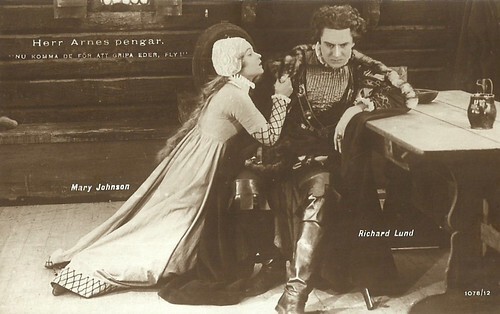
Swedish postcard by Nordisk Konst, Stockholm, no. 1078/12. Richard Lund and Mary Johnson in the Swedish silent film Herr Arnes pengar/Sir Arne's Treasure (Mauritz Stiller, 1919). Caption: They have come now to arrest you, escape!
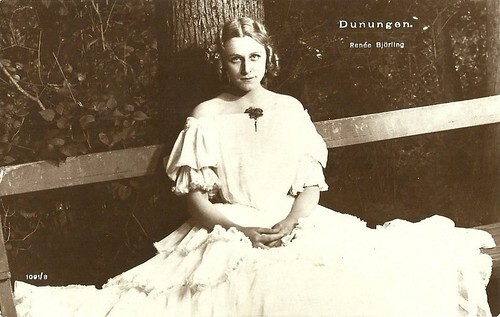
Swedish postcard by Nordisk Konst, Stockholm, no. 1091/8. Renée Björling in Dunungen/In Quest of Happiness (Ivan Hedqvist, 1919).
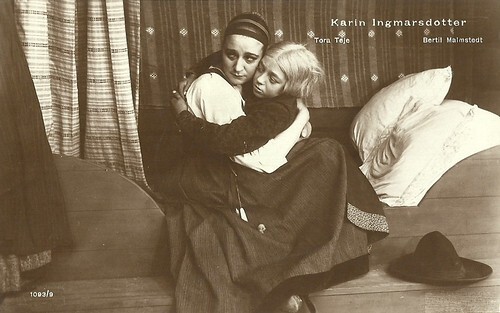
Swedish postcard by Nordisk Konst, Stockholm, no. 1093/9. Photo: Svenska Biografteatren AB. Tora Teje and Bertil Malmstedt, who plays her son in Karin Ingmarsdotter/God/s Way/ Karin Daughter of Ingmar (Victor Sjöström, 1920). It is the second part in Sjöström's large-scale adaption of Selma Lagerlöf's novel 'Jerusalem', following Sons of Ingmar from the year before, and depicting chapters three and four of the novel.
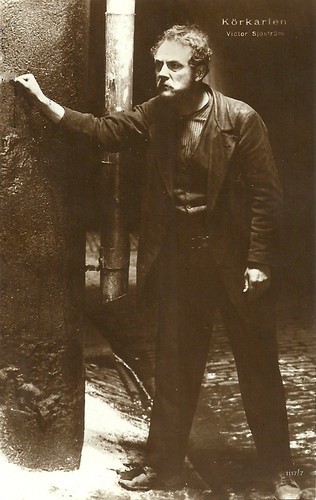
Swedish postcard by Ed. Nordisk Konst, Stockholm, no. 1117/7. Photo: vensk Filmindustri. Victor Sjöström in Körkarlen/The Phantom Carriage Victor Sjöström, 1920).
The first significant phase of Swedish cinema in film history
The first time that one of Selma Lagerlöf's books was made into a film was in 1917 with Tösen från Stormyrtorpet/The Girl from the Marsh Croft (Victor Sjöström, 1917), starring Greta Almroth, Lars Hanson and Karin Molander . The film, produced by Svenska Biografteatern AB, was the first of Sjöström's several film adaptations of Lagerlöf's literary works, heralding the first significant phase of Swedish cinema in film history. 'Tösen från Stormyrtorpet' was published in 1908 in the collection 'En saga om en saga och andra sagor'. Six other adaptions of the same novel have been made, a German and a Turkish in 1935, a Finnish in 1940, another Swedish in 1947, a Danish, Husmandstøsen (Alice O'Fredericks, 1952) and another German, Das Mädchen von Moorhof/The Girl of the Moors (Gustav Ucicky, 1958).
After the success of Tösen från Stormyrtorpet/The Girl from the Marsh Croft, Victor Sjöström adapted 'Jerusalem' (1901-1902) into a large-scale epic in two parts. Ingmarssönerna/Sons of Ingmar (1919) and Karin Ingmarsdotter/God's Way/Karin Daughter of Ingmar (1920). The latter two were both based on chapters of Lagerlöf's novel 'Jerusalem' (1901-1902), about religious emigrants from Sweden to Palestine. The two films depicted the first four chapters of the novel and featured respectively Sjöström himself as Ingmar and Tora Teje as his daughter Karin.
The critical reception for Karin Ingmarsdotter/God's Way (Victor Sjöström, 1920) was unenthusiastic. Victor Sjöström decided to not direct any more parts of Selma Lagerlöf's novel Jerusalem. Eventually, the film adaptation of the novel was finished by Gustaf Molander with Ingmarsarvet/The Ingmar Inheritance (1925) and Till österland/To the Orient (1926) with Lars Hanson , Jenny Hasselqvist and Mona Mårtenson .
Director Mauritz Stiller directed for Svenska Biografteatern the masterpiece Herr Arnes pengar/Sir Arne's Treasure (Mauritz Stiller, 1919), a crime drama based on Selma Lagerlöf’s novel The Treasure. Set on the Swedish coast in the 16th century, the film stars Richard Lund as Sir Archie, a Scottish mercenary who has escaped from a Scottish prison and fled to Sweden. The screenplay by Mauritz Stiller and Gustaf Molander differs from the novel in that it tells the story in more strictly chronological order, and incorporates some details which were introduced in the German play.
Another Swedish director, Ivan Hedqvist , made for Svenska Biografteatern the Lagerlöf adaptation Dunungen/In Quest of Happiness (Ivan Hedqvist, 1919). The film is based on a short story and play by Selma Lagerlöf, and stars Renée Björling as Dunungen. The film was Ivan Hedqvist 's directorial debut and Renée Björling 's film debut. Weyler Hildebrand made a remake of Dunungen in 1941 with cinematographer Julius Jaenzon who also filmed this version in 1919.
In 1920, Victor Sjöström had already filmed three novels since the contract was signed. His film adaptations had been consistently well received by critics, audiences and Lagerlöf herself. Since the first productions had all been set in rural surroundings, Sjöström chose the urban-themed novella 'Körkarlen' (Thy Soul Shall Bear Witness!) as his new project, Körkarlen/The Phantom Carriage (1921). Filming took place at Filmstaden Studios in Solna between May and July 1920. The studio buildings were inspired by the southern Swedish town of Landskrona. Lagerlöf originally wanted to have the film shot on location in Landskrona, but Sjöström decided on a studio production due to the technical possibilities. Körkarlen/The Phantom Carriage (Victor Sjöström, 1920) premiered on 1 January 1921, New Year's Eve. It was a success at the time and is now seen as one of the classics of Swedish silent cinema.
The film had a lasting influence on the work of Ingmar Bergman , who used the character of Death in Det sjunde inseglet/The Seventh Seal (1957) and created a direct reference to the carter of Körkarlen/The Phantom Carriage (1921) by titling him "disciplinarian." In addition, Bergman enlisted Sjöström to star in Smultronstället/Wild Strawberries (1957). It was his final role. Bergman once reported that he had first watched Körkarlen at the age of 15 and every year since. In 2000, Ingmar Bergman made the TV drama Bildmakarna/The Image Makers (2000), which fictionalised the story of the making of Körkarlen/The Phantom Carriage (1920) with Anita Björk as Selma Lagerlöf and Lennart Hjulström as Victor Sjöström .
Remakes were directed by Julien Duvivier, La charrette fantôme/The Phantom Carriage (1939) starring Pierre Fresnay and Marie Bell , and by Arne Mattsson Körkarlen/The Phantom Carriage (1958) with George Fant, Ulla Jacobsson and Anita Björk . In 2012, Körkarlen/The Phantom Carriage (1921) was named the best Swedish film of all time by 50 film critics and connoisseurs in a poll conducted by the Swedish film magazine FLM.
Finnish-born director Mauritz Stiller cast Einar Hanson as the title character of Gunnar Hedes saga/The Story of Gunnar Hede (Mauritz Stiller, 1923), based on the novel 'En herrgardssaegen' by Selma Lagerlöf. Stiller had the title role first offered to Lars Hanson - not related to Einar - but Stiller found him too virile for the role, a young man who prefers to play the violin and who suffers from memory loss after being injured in a blizzard. Einar Hanson with his soft, sensitive appearance fitted better. Gunnar Hedes saga was the big breakthrough for Hanson and he went on to play leading parts in Mälarpirater/Pirates on the Malonen (Gustaf Molander, 1923), and Johan Ulfstjerna/Human Destinies (John W. Brunius, 1923).
In early 1924, Stiller had a big success with a Lagerlöf adaptation, Gösta Berling Saga/The Saga of Gösta Berling (Mauritz Stiller, 1924). Lars Hanson plays a young, attractive priest and alcoholic who has been cast out by his community and struggles to atone and regain his honour and dignity. At the end of the film, Berling gets his redemption from the hand of Elisabeth, performed by the young Greta Garbo in her first major screen appearance. Shortly after, Stiller signed a contract with the largest German film company at the time, Trianon A.G. for two films.
Finally, 'Nils Holgerssons underbara resa genom Sverige' was filmed as Nils Holgerssons underbara resa/Wonderful Adventures of Nils (Kenne Fant, 1962). Sven Lundberg played the naughty Nils Holgersson and Max von Sydow played Nils' father. The film was shot primarily from helicopters, simplifying and downplaying the drama of the plot. In the following decades, three TV adaptations would follow. 'Nils Holgerssons underbara resa genom Sverige' is so well known in Swedish culture that a picture of Nils Holgersson, on the back of a goose flying over the plains of Scania, was printed on the reverse side of the Swedish 20 krona banknote until new bills came in use in 2015.
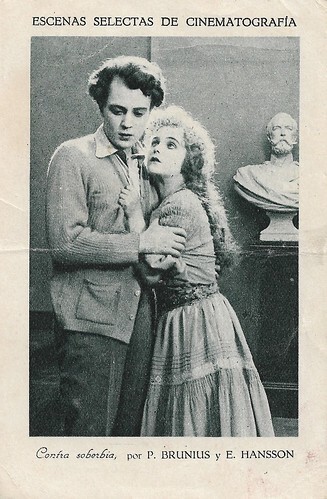
Spanish minicard in the Series Escenas Selectas de Cinematografia. Einar Hanson and Mary Johnson in Gunnar Hedes saga/ Snowbound (Mauritz Stiller, 1923).
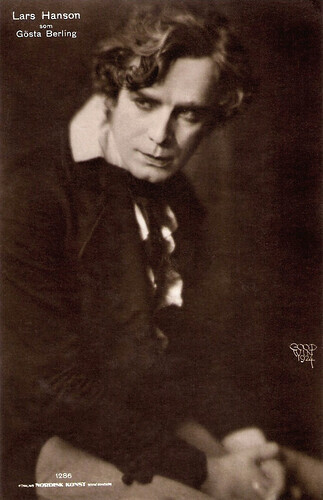
Swedish postcard by Förlag Nordisk Konst, Stockholm, no. 1286. Photo: Goodwin, 1924. Lars Hanson as Gösta Berling in Gösta Berlings saga/The Story of Gösta Berling (Mauritz Stiller, 1924).
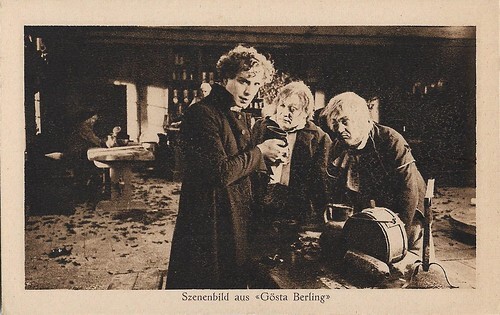
German postcard. Photo: Svenska Film of the Trianon-Film-Konzern, Berlin (also in Leipzig, Frankfurt a.M., Düsseldorf and Hamburg). Lars Hanson in Gösta Berlings saga/The Saga of Gösta Berling (Mauritz Stiller, 1924). This postcard was made by Trianon for the German premiere of the film on 20 August 1924, at the Berlin Theater am Nollendorfplatz.
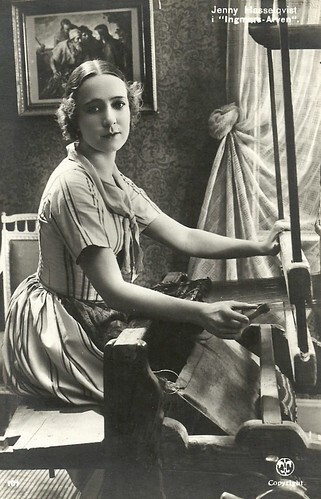
Danish postcard by Alex. Vincent's Kunstforlag, Copenhagen, no. 101. Jenny Hasselqvist in Ingmarsarvet (Gustav Molander, 1925), based on Selma Lagerlöf's book 'Jerusalem'.
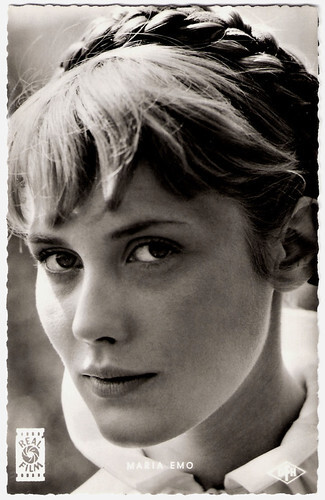
German postcard by Kunst und Bild, Berlin-Charlottenburg, no. A 1647. Photo: Real Film / DFH / Lilo. Maria Emo in Das Mädchen von Moorhof/The Girl of the Moors (Gustav Ucicky, 1958), based on Selma Lagerlöf's novel 'Tösen från Stormyrtorpet'.
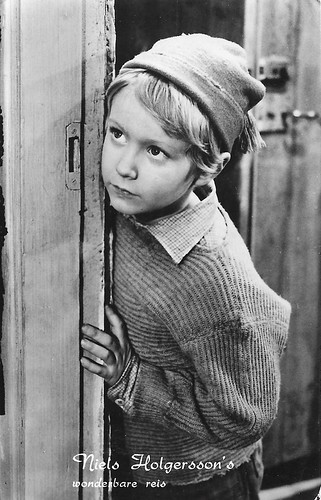
Dutch postcard by HAFBO. Sven Lundberg in Nils Holgersson underbara resa/The Adventures of Nils Holgersson/The Wonderful Adventures of Nils (Kenne Fant, 1962), released in the Netherlands as Niels Holgerssons wonderbaarlijke reis.
Sources: Wikipedia (Dutch, English and Swedish), and .

Swedish postcard by Nordisk Konst, Stockholm, no. 958/8. Harriet Bosse in Ingmarssönerna/Sons of Ingmar (Victor Sjöström, 1919). Caption: I have to do something or I won't find any rest in my soul.

Swedish postcard by Nordisk Konst, Stockholm, no. 1078/8. Richard Lund , Bror Berger and Erik Stocklassa in Herr Arnes pengar/Sir Arne's Treasure (Mauritz Stiller, 1919). Caption: On the Lookout.

Swedish postcard by Nordisk Konst, Stockholm, no. 1093/2. Photo: Svenska Biografteatren. Tora Teje in Karin Ingmarsdotter/God's Way/Karin Daughter of Ingmar (Victor Sjöström, 1920).

Swedish postcard by Förlag Nordisk Konst, Stockholm, no. 1117/6. Photo: Svensk Filmindustri. Victor Sjöström and Tore Svennberg in Körkarlen/The Phantom Carriage, (Victor Sjöström, 1920).
[image error]
German postcard by Trianon-Film, 1924. Photo: Svenska-Film. Mona Mårtenson in Gösta Berlings saga/The Atonement of Gosta Berling (Mauritz Stiller, 1924).
A wave of romantic nationalist literature in Sweden
Selma Ottilia Lovisa Lagerlöf was born at Mårbacka Manor in Östra Ämtervik in Värmland, Sweden, in 1858. She was the fifth of six children of Lieutenant Erik Gustaf Lagerlöf and Elisabet Lovisa Wallroth. She was born with a hip injury caused by a lack of proper attachment of the joint ball in her hip. When Lagerlöf was three and a half years old, in the summer of 1862, she became ill and completely paralysed in both legs. This disappeared as suddenly as it had come, but during her childhood, she did not find it as easy to play as other children. Like many other children in a bourgeois environment at the time, the Lagerlöf siblings received their education at home, as the new public school system was not fully developed. Their teachers came to Mårbacka to teach, and Lagerlöf was taught both English and French.
Selma Lagerlöf was a serious and gifted child and enjoyed reading. The first novel she read was an Indian book, 'Osceola' by Thomas Mayne Reid - and at the age of seven, she decided to become a writer. When one of her benefactors, Sophie Adlersparre, encouraged her to write in prose did she do so - and became a writer. She entered the Higher Teacher Training College in Stockholm, against her father's wishes, in the autumn of 1882. During Lagerlöf's education, the family became insolvent and Mårbacka had to be sold. Her father died in 1885, the same year Lagerlöf finished her teacher training.
When Lagerlöf studied literary history, she suddenly realised that the characters and fates she had heard about during her childhood in Värmland were as imaginative as Bellman's and Runeberg's cast of characters. But it took several years and many unsuccessful attempts at writing before she made her debut as a writer. After completing her education, Selma Lagerlöf taught at the Elementary School for Girls in Landskrona from 1885 to 1895. Lagerlöf enjoyed being a teacher and was appreciated by her students. Selma Lagerlöf had the ability to tell children in a captivating way about each new country they read about, or about Jesus and his disciples.
Selma Lagerlöf was 33 years old when her debut novel 'Gösta Berlings Saga' was published in 1891 after winning a prize competition in the magazine Idun. 'Gösta Berling's tale' is one of the greatest classics of Swedish literature - a rich and fantastic tale of the Cavaliers and life in Värmland in the 19th century. Her novel broke with the stylistic ideals of the time, which advocated realistic objectivity and she started a wave of romantic nationalist literature in Sweden in the 1890s. The book received a mixed reception from critics. In 1895 Lagerlöf left her teaching post. From then on she supported herself entirely by writing, and in 1897 she moved with her aunt to Falun to be closer to her sister Gerda.
Together with Sophie Elkan, Lagerlöf made several long trips in Europe and in 1899-1900 an extended trip to the Middle East. On her return, she wrote the novel 'Jerusalem' (1901-1902), which became her great international breakthrough. Lagerlöf's most internationally known book is 'Nils Holgerssons underbara resa genom Sverige' (Nils Holgersson's Wonderful Journey) (1906-1907), which was originally commissioned and published as a textbook for elementary schools. In it, we experience the geography of Sweden through the eyes of a fourteen-year-old boy, Nils Holgersson, who flies over the country on the back of a goose.
In 1909, Selma Lagerlöf was awarded the Nobel Prize for Literature in 1909. She was awarded the prize, according to the Academy, "because of the noble ideality, the richness of imagination and the soulfulness of representation that characterise her poetry". She lived in the town of Sunne, where two hotels are named after her. She passed away in 1940 in Mårbacka, near Sunne, where a museum is located today. Although Lagerlöf is associated with Mårbacka, she lived and worked in Falun for many years, and it was there that she wrote some of her greatest works. Even after she moved back to Mårbacka, she returned to Falun several times a year.

Swedish postcard by Nordisk Konst, Stockholm, no. 958/13. Harriet Bosse and Victor Sjösström in Ingmarssönerna/Sons of Ingmar (Victor Sjöström, 1919). Caption: Now they understood why they were sitting alone on the bench.

Swedish postcard by Nordisk Konst, Stockholm, no. 1078/2. Richard Lund , Bror Berger and Erik Stocklassa in Herr Arnes pengar/Sir Arne's Treasure (Mauritz Stiller, 1919). Caption: In Prison.

Swedish postcard by Nordisk Konst, Stockholm, no. 1078/12. Richard Lund and Mary Johnson in the Swedish silent film Herr Arnes pengar/Sir Arne's Treasure (Mauritz Stiller, 1919). Caption: They have come now to arrest you, escape!

Swedish postcard by Nordisk Konst, Stockholm, no. 1091/8. Renée Björling in Dunungen/In Quest of Happiness (Ivan Hedqvist, 1919).

Swedish postcard by Nordisk Konst, Stockholm, no. 1093/9. Photo: Svenska Biografteatren AB. Tora Teje and Bertil Malmstedt, who plays her son in Karin Ingmarsdotter/God/s Way/ Karin Daughter of Ingmar (Victor Sjöström, 1920). It is the second part in Sjöström's large-scale adaption of Selma Lagerlöf's novel 'Jerusalem', following Sons of Ingmar from the year before, and depicting chapters three and four of the novel.

Swedish postcard by Ed. Nordisk Konst, Stockholm, no. 1117/7. Photo: vensk Filmindustri. Victor Sjöström in Körkarlen/The Phantom Carriage Victor Sjöström, 1920).
The first significant phase of Swedish cinema in film history
The first time that one of Selma Lagerlöf's books was made into a film was in 1917 with Tösen från Stormyrtorpet/The Girl from the Marsh Croft (Victor Sjöström, 1917), starring Greta Almroth, Lars Hanson and Karin Molander . The film, produced by Svenska Biografteatern AB, was the first of Sjöström's several film adaptations of Lagerlöf's literary works, heralding the first significant phase of Swedish cinema in film history. 'Tösen från Stormyrtorpet' was published in 1908 in the collection 'En saga om en saga och andra sagor'. Six other adaptions of the same novel have been made, a German and a Turkish in 1935, a Finnish in 1940, another Swedish in 1947, a Danish, Husmandstøsen (Alice O'Fredericks, 1952) and another German, Das Mädchen von Moorhof/The Girl of the Moors (Gustav Ucicky, 1958).
After the success of Tösen från Stormyrtorpet/The Girl from the Marsh Croft, Victor Sjöström adapted 'Jerusalem' (1901-1902) into a large-scale epic in two parts. Ingmarssönerna/Sons of Ingmar (1919) and Karin Ingmarsdotter/God's Way/Karin Daughter of Ingmar (1920). The latter two were both based on chapters of Lagerlöf's novel 'Jerusalem' (1901-1902), about religious emigrants from Sweden to Palestine. The two films depicted the first four chapters of the novel and featured respectively Sjöström himself as Ingmar and Tora Teje as his daughter Karin.
The critical reception for Karin Ingmarsdotter/God's Way (Victor Sjöström, 1920) was unenthusiastic. Victor Sjöström decided to not direct any more parts of Selma Lagerlöf's novel Jerusalem. Eventually, the film adaptation of the novel was finished by Gustaf Molander with Ingmarsarvet/The Ingmar Inheritance (1925) and Till österland/To the Orient (1926) with Lars Hanson , Jenny Hasselqvist and Mona Mårtenson .
Director Mauritz Stiller directed for Svenska Biografteatern the masterpiece Herr Arnes pengar/Sir Arne's Treasure (Mauritz Stiller, 1919), a crime drama based on Selma Lagerlöf’s novel The Treasure. Set on the Swedish coast in the 16th century, the film stars Richard Lund as Sir Archie, a Scottish mercenary who has escaped from a Scottish prison and fled to Sweden. The screenplay by Mauritz Stiller and Gustaf Molander differs from the novel in that it tells the story in more strictly chronological order, and incorporates some details which were introduced in the German play.
Another Swedish director, Ivan Hedqvist , made for Svenska Biografteatern the Lagerlöf adaptation Dunungen/In Quest of Happiness (Ivan Hedqvist, 1919). The film is based on a short story and play by Selma Lagerlöf, and stars Renée Björling as Dunungen. The film was Ivan Hedqvist 's directorial debut and Renée Björling 's film debut. Weyler Hildebrand made a remake of Dunungen in 1941 with cinematographer Julius Jaenzon who also filmed this version in 1919.
In 1920, Victor Sjöström had already filmed three novels since the contract was signed. His film adaptations had been consistently well received by critics, audiences and Lagerlöf herself. Since the first productions had all been set in rural surroundings, Sjöström chose the urban-themed novella 'Körkarlen' (Thy Soul Shall Bear Witness!) as his new project, Körkarlen/The Phantom Carriage (1921). Filming took place at Filmstaden Studios in Solna between May and July 1920. The studio buildings were inspired by the southern Swedish town of Landskrona. Lagerlöf originally wanted to have the film shot on location in Landskrona, but Sjöström decided on a studio production due to the technical possibilities. Körkarlen/The Phantom Carriage (Victor Sjöström, 1920) premiered on 1 January 1921, New Year's Eve. It was a success at the time and is now seen as one of the classics of Swedish silent cinema.
The film had a lasting influence on the work of Ingmar Bergman , who used the character of Death in Det sjunde inseglet/The Seventh Seal (1957) and created a direct reference to the carter of Körkarlen/The Phantom Carriage (1921) by titling him "disciplinarian." In addition, Bergman enlisted Sjöström to star in Smultronstället/Wild Strawberries (1957). It was his final role. Bergman once reported that he had first watched Körkarlen at the age of 15 and every year since. In 2000, Ingmar Bergman made the TV drama Bildmakarna/The Image Makers (2000), which fictionalised the story of the making of Körkarlen/The Phantom Carriage (1920) with Anita Björk as Selma Lagerlöf and Lennart Hjulström as Victor Sjöström .
Remakes were directed by Julien Duvivier, La charrette fantôme/The Phantom Carriage (1939) starring Pierre Fresnay and Marie Bell , and by Arne Mattsson Körkarlen/The Phantom Carriage (1958) with George Fant, Ulla Jacobsson and Anita Björk . In 2012, Körkarlen/The Phantom Carriage (1921) was named the best Swedish film of all time by 50 film critics and connoisseurs in a poll conducted by the Swedish film magazine FLM.
Finnish-born director Mauritz Stiller cast Einar Hanson as the title character of Gunnar Hedes saga/The Story of Gunnar Hede (Mauritz Stiller, 1923), based on the novel 'En herrgardssaegen' by Selma Lagerlöf. Stiller had the title role first offered to Lars Hanson - not related to Einar - but Stiller found him too virile for the role, a young man who prefers to play the violin and who suffers from memory loss after being injured in a blizzard. Einar Hanson with his soft, sensitive appearance fitted better. Gunnar Hedes saga was the big breakthrough for Hanson and he went on to play leading parts in Mälarpirater/Pirates on the Malonen (Gustaf Molander, 1923), and Johan Ulfstjerna/Human Destinies (John W. Brunius, 1923).
In early 1924, Stiller had a big success with a Lagerlöf adaptation, Gösta Berling Saga/The Saga of Gösta Berling (Mauritz Stiller, 1924). Lars Hanson plays a young, attractive priest and alcoholic who has been cast out by his community and struggles to atone and regain his honour and dignity. At the end of the film, Berling gets his redemption from the hand of Elisabeth, performed by the young Greta Garbo in her first major screen appearance. Shortly after, Stiller signed a contract with the largest German film company at the time, Trianon A.G. for two films.
Finally, 'Nils Holgerssons underbara resa genom Sverige' was filmed as Nils Holgerssons underbara resa/Wonderful Adventures of Nils (Kenne Fant, 1962). Sven Lundberg played the naughty Nils Holgersson and Max von Sydow played Nils' father. The film was shot primarily from helicopters, simplifying and downplaying the drama of the plot. In the following decades, three TV adaptations would follow. 'Nils Holgerssons underbara resa genom Sverige' is so well known in Swedish culture that a picture of Nils Holgersson, on the back of a goose flying over the plains of Scania, was printed on the reverse side of the Swedish 20 krona banknote until new bills came in use in 2015.

Spanish minicard in the Series Escenas Selectas de Cinematografia. Einar Hanson and Mary Johnson in Gunnar Hedes saga/ Snowbound (Mauritz Stiller, 1923).

Swedish postcard by Förlag Nordisk Konst, Stockholm, no. 1286. Photo: Goodwin, 1924. Lars Hanson as Gösta Berling in Gösta Berlings saga/The Story of Gösta Berling (Mauritz Stiller, 1924).

German postcard. Photo: Svenska Film of the Trianon-Film-Konzern, Berlin (also in Leipzig, Frankfurt a.M., Düsseldorf and Hamburg). Lars Hanson in Gösta Berlings saga/The Saga of Gösta Berling (Mauritz Stiller, 1924). This postcard was made by Trianon for the German premiere of the film on 20 August 1924, at the Berlin Theater am Nollendorfplatz.

Danish postcard by Alex. Vincent's Kunstforlag, Copenhagen, no. 101. Jenny Hasselqvist in Ingmarsarvet (Gustav Molander, 1925), based on Selma Lagerlöf's book 'Jerusalem'.

German postcard by Kunst und Bild, Berlin-Charlottenburg, no. A 1647. Photo: Real Film / DFH / Lilo. Maria Emo in Das Mädchen von Moorhof/The Girl of the Moors (Gustav Ucicky, 1958), based on Selma Lagerlöf's novel 'Tösen från Stormyrtorpet'.

Dutch postcard by HAFBO. Sven Lundberg in Nils Holgersson underbara resa/The Adventures of Nils Holgersson/The Wonderful Adventures of Nils (Kenne Fant, 1962), released in the Netherlands as Niels Holgerssons wonderbaarlijke reis.
Sources: Wikipedia (Dutch, English and Swedish), and .
Published on October 21, 2022 22:00
October 20, 2022
Ronald Reagan
Ronald Reagan (1911-2004) had quite a prolific career. He began in the 1930s as a successful film actor for Warner Bros., later became a television star, served as president of the Screen Actors Guild, became the governor of California (1967-1975), and lastly, served two terms as President of the United States (1981-1989).
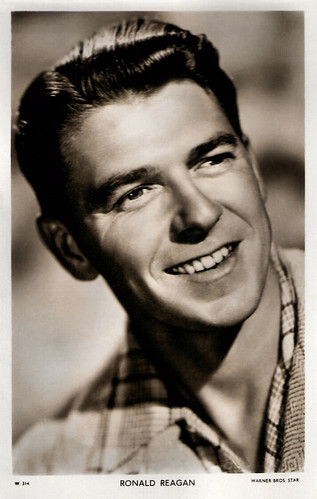
British postcard in the Picturegoer Series, London, no. W. 314. Photo: Warner Bros.
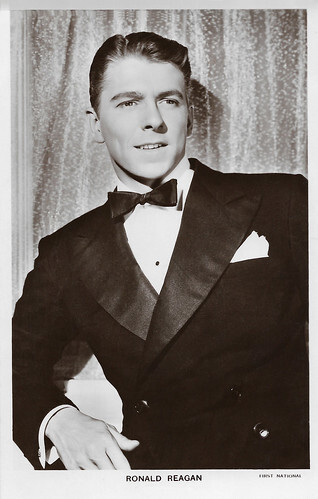
British postcard in the Picturegoer Series, London, no. 1295. Photo: First National.
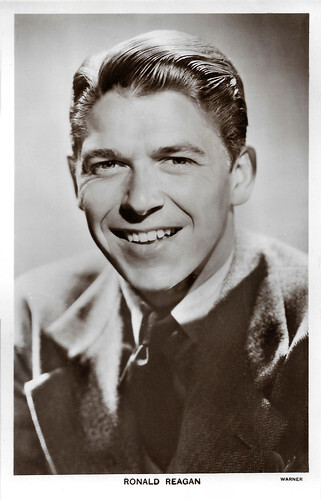
British postcard in the Picturegoer Series, London, no. 1295a. Photo: Warner.

American postcard by Capsco, Inc, Washington, D.C., no. P321509. Photo: Courtesy of the President-Elect Office. Caption: Ronald Reagan, 40th President of the United States.
Where's the rest of me?
Ronald Wilson Reagan was the son of the shoe salesman and storyteller Jack Reagan and Nelle Clyde Wilson Reagan. He was born in 1911 in Tampico, Illinois, but grew up in Dixon. His first job was as a lifeguard at the Rock River in Lowell Park, near Dixon, in 1927. He rescued 77 people in this position. He was then educated at Eureka College, where he earned a degree in economics and sociology. He excelled in politics, sports and theatre, and was a member of the football team and captain of the swimming team. During his studies, Reagan led a student revolt against the president of the college.
After college, Reagan began his career at a regional radio station as a sportscaster. When he accompanied the Chicago Cubs on a trip to California as a reporter, he came to Hollywood for an audition. The film company Warner Bros offered him a seven-year acting contract in 1937. Reagan spent the next few years in Hollywood as an actor in B-movies.
Although his roles were often overshadowed by those of others, he received good reviews for his acting. Reagan's first major role was the lead in the film Love is on the Air (Nick Grinde, 1937). In 1938, Reagan acted alongside actress Jane Wyman in the film Brother Rat (William Keighley, 1938). They married in 1940. By then, he had appeared in 19 films, including Dark Victory (Edmund Goulding, 1939) starring Bette Davis .
Reagan often embodied elegant and respectable personalities with firm morals and principles such as the role of George "The Gipper" Gipp in Knute Rockne, All American (Lloyd Bacon, 1940) with Pat O'Brien. This film later earned him the nickname "The Gipper". In 1941, he was voted the fifth most popular actor of the new generation in Hollywood.
Reagan's favourite role was in Kings Row (Sam Wood, 1942) with Ann Sheridan . He played a man who had been doubly amputated and who uttered the words 'Where's the rest of me?' He later used these words as the title of his autobiography, which came out in 1965. Although the film was scratched by Bosley Crowther, the New York Times critic at the time, many critics today consider Kings Row to be one of Reagan's best films. The film was nominated for three Oscars.
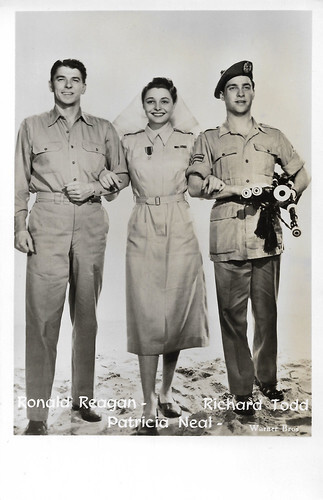
Belgian postcard by Nieuwe Merksemsche Chocolaterie S.P.R.L., Merksem (Anvers), No. D 13. Photo: Warner Bros. Ronald Reagan, Patricia Neal and Richard Todd in The Hasty Heart (Vincent Sherman, 1949).
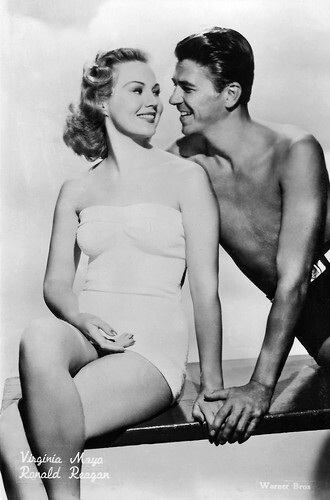
Vintage postcard. Photo: Warner Bros. Virginia Mayo and Ronald Reagan in The Girl From Jones Beach (Peter Godfrey, 1949).
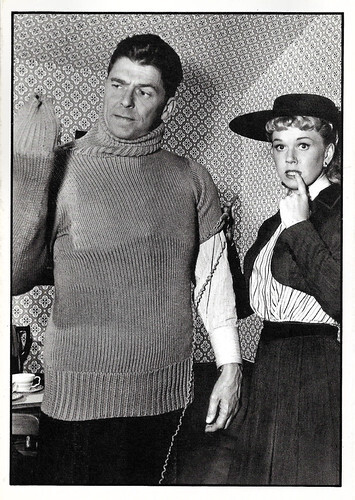
French postcard in the Entr'acte series by Éditions Asphodèle, Mâcon, no. 001/26. Ronald Reagan and Doris Day on the set of The Winning Team (Lewis Seiler, 1952). Caption: Ronald Reagan and Doris Day relax in their own way.
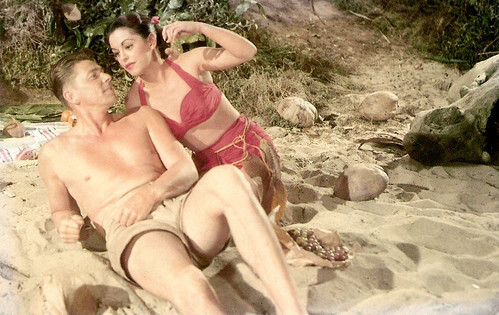
Belgian postcard. Ronald Reagan and Estelita Rodriguez in Tropic Zone (Lewis R. Foster, 1953). Collection: Geoffrey Donaldson Institute.
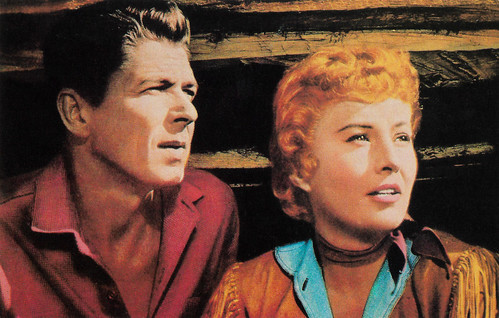
American postcard by Coral-Lee, Rancho Cordova, CA, no. SC17489. Photo: Tony Koroda / 1981 Sygma. Ronald Reagan and Barbara Stanwyck in Cattle Queen of Montana (Allan Dwan, 1954).
A poor man's James Stewart
Although Ronald Reagan called Kings Row the film that made him a star, he was unable to capitalise on its success. He was called into active service with the US Army in San Francisco two months after the film's release and would never regain star status in films in the future. He served nearly four years with the World War II stateside service in the first Motion Picture Unit.
In the post-war period, he resumed his film career with The Voice of the Turtle (Irving Rapper, 1947), John loves Mary (David Butler, 1949), and The Hasty Heart (Vincent Sherman, 1949) with Patricia Neal. He earned a reputation as a "poor man's James Stewart " in the early 1950s with starring roles in several small Westerns such as The Last Outpost (Lewis R. Foster, 1951), Law and Order (Nathan Juran, 1953), and Cattle Queen of Montana (Allan Dwan, 1954) with Barbara Stanwyck .
He also worked regularly as a voice actor and narrator for films, such as the Oscar-winning short Beyond the Line of Duty. From the 1950s, Reagan was also a regular on increasingly popular television. He appeared from 1954 to 1962 as a host in 260 episodes of the weekly anthology Western series General Electric Theater, named after the electrical corporation General Electric. His last film was the remake of The Killers (Don Siegel, 1964).
From 1947 to 1952 and from 1959 to 1960 he was president of the Screen Actors Guild (SAG), which is seen as the beginning of his political involvement. In the late 1940s, he was an informant for the FBI and named fellow actors whom he assigned to a group with communist ideas. After his career as an actor, Reagan went into politics. As a member of the Republican Party, he was the 33rd Governor of California from 1967 to 1975, before becoming the 40th President of the United States, succeeding Democrat Jimmy Carter, and ruling the country for two terms in office from 1981 to 1989.
Reagan's first term as president was mainly characterised by a supply-side economic policy, later called Reaganomics, with an emphasis on tax cuts to stimulate economic growth, restrictions on the supply of money to reduce inflation, deregulation of the economy, a reduction in government spending and a limitation of the power of trade unions. He was re-elected president in 1984. His second term was dominated by foreign events, such as the end of the Cold War, his bombing of Libya in 1986 and the exposure of the Iran-Contra affair, which damaged his government's image: it turned out that arms had been secretly supplied to Iran, the proceeds of which had financed rebels in Nicaragua.
Reagan publicly described the Soviet Union as "the empire of evil" and supported anti-communist movements worldwide. At the same time, however, Reagan sought a diplomatic way out of the arms race between the US and the Soviet Union, resulting in the conclusion of the INF Treaty in which both countries agreed to destroy a large number of (nuclear) missiles.
After Reagan stepped down as president in 1989, he and his wife moved into a house in Bel Air, Los Angeles; in addition, the couple owned the Reagan Ranch in Santa Barbara. Reagan died of pneumonia, partly caused by his poor condition due to Alzheimer's disease, at his home in Bel Air, Los Angeles, in 2004. He was 93. Ronald Reagan was the first and, until the election of Donald Trump in 2016, the only US president to be divorced.
After a dispute over Reagan's political aspirations, his first wife, Jane Wyman filed for divorce in 1948, citing Reagan's activities for the Screen Actors Guild as the reason for the irreconcilable distance. The couple had two children, Maureen (1941-2001) and Christine (1947, died after one day) and adopted a third child, Michael (1945). In 1949, Reagan met actress Nancy Davis, after she approached him in his capacity as president of the Screen Actors Guild to help her with matters concerning her appearance on the Hollywood blacklist (on the list she had been mistaken for another Nancy Davis). They married in 1952 and had two children, Patti (1952) and Ron Jr. (1958).
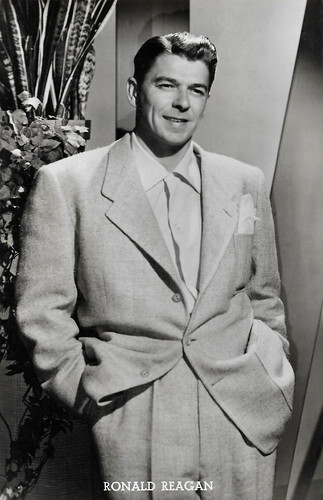
Belgian postcard, no. 551. Photo: Warner Bros.
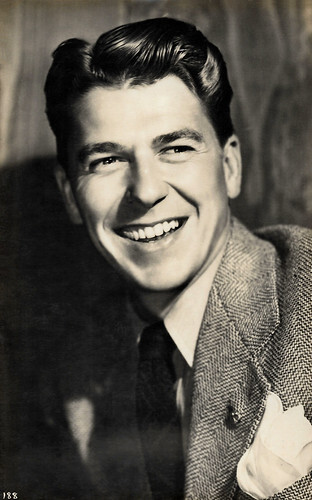
Spanish postcard by SOBE, Barcelona, no. 220.
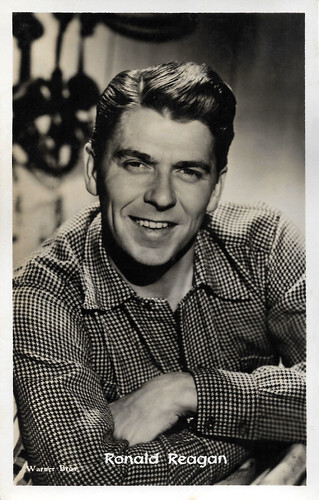
Vintage postcard. Photo: Warner Bros.
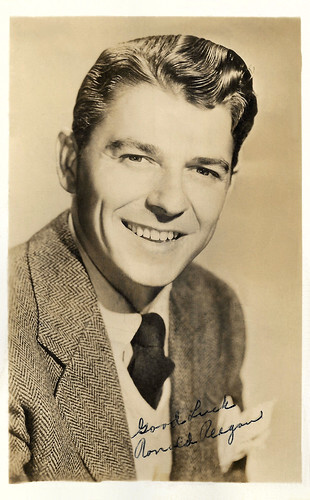
American autograph card.
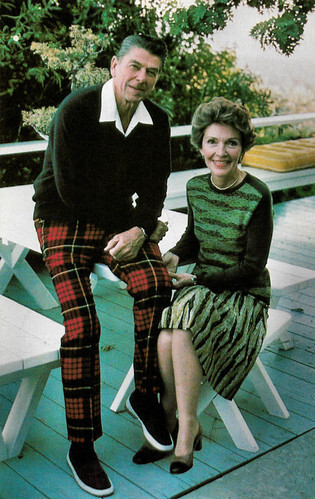
American postcard by Coral-Lee, Rancho Cordova, CA, no. SC17421. Photo: Michael Evans / 1980 Contact. Caption: Presidential candidate Ronald Reagan and wife Nancy on the deck of their home in Pacific Palisades, California.
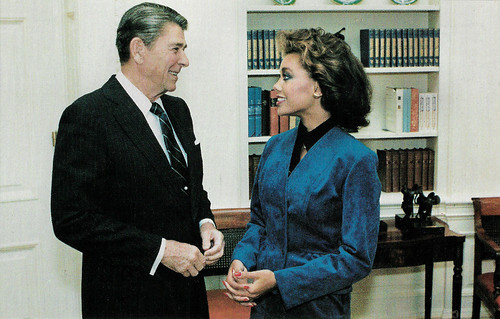
American postcard by Coral-Lee, Rancho Cordova, CA, no. CL-R.R. # 129 / SC18581. Photo: Bill Fitz-Patrick. Caption: The New Miss America, Vanessa Williams, had a brief meeting with President Reagan at the White House and they spent their time discussing how one keeps in shape on a busy, busy schedule. Williams said her meeting with the President was the most memorable moment of her reign so far. The White House state dinner she attended shortly after winning her crown was her second most memorable event. October 17, 1983.
Sources: Wikipedia (Dutch and German), and .

British postcard in the Picturegoer Series, London, no. W. 314. Photo: Warner Bros.

British postcard in the Picturegoer Series, London, no. 1295. Photo: First National.

British postcard in the Picturegoer Series, London, no. 1295a. Photo: Warner.

American postcard by Capsco, Inc, Washington, D.C., no. P321509. Photo: Courtesy of the President-Elect Office. Caption: Ronald Reagan, 40th President of the United States.
Where's the rest of me?
Ronald Wilson Reagan was the son of the shoe salesman and storyteller Jack Reagan and Nelle Clyde Wilson Reagan. He was born in 1911 in Tampico, Illinois, but grew up in Dixon. His first job was as a lifeguard at the Rock River in Lowell Park, near Dixon, in 1927. He rescued 77 people in this position. He was then educated at Eureka College, where he earned a degree in economics and sociology. He excelled in politics, sports and theatre, and was a member of the football team and captain of the swimming team. During his studies, Reagan led a student revolt against the president of the college.
After college, Reagan began his career at a regional radio station as a sportscaster. When he accompanied the Chicago Cubs on a trip to California as a reporter, he came to Hollywood for an audition. The film company Warner Bros offered him a seven-year acting contract in 1937. Reagan spent the next few years in Hollywood as an actor in B-movies.
Although his roles were often overshadowed by those of others, he received good reviews for his acting. Reagan's first major role was the lead in the film Love is on the Air (Nick Grinde, 1937). In 1938, Reagan acted alongside actress Jane Wyman in the film Brother Rat (William Keighley, 1938). They married in 1940. By then, he had appeared in 19 films, including Dark Victory (Edmund Goulding, 1939) starring Bette Davis .
Reagan often embodied elegant and respectable personalities with firm morals and principles such as the role of George "The Gipper" Gipp in Knute Rockne, All American (Lloyd Bacon, 1940) with Pat O'Brien. This film later earned him the nickname "The Gipper". In 1941, he was voted the fifth most popular actor of the new generation in Hollywood.
Reagan's favourite role was in Kings Row (Sam Wood, 1942) with Ann Sheridan . He played a man who had been doubly amputated and who uttered the words 'Where's the rest of me?' He later used these words as the title of his autobiography, which came out in 1965. Although the film was scratched by Bosley Crowther, the New York Times critic at the time, many critics today consider Kings Row to be one of Reagan's best films. The film was nominated for three Oscars.

Belgian postcard by Nieuwe Merksemsche Chocolaterie S.P.R.L., Merksem (Anvers), No. D 13. Photo: Warner Bros. Ronald Reagan, Patricia Neal and Richard Todd in The Hasty Heart (Vincent Sherman, 1949).

Vintage postcard. Photo: Warner Bros. Virginia Mayo and Ronald Reagan in The Girl From Jones Beach (Peter Godfrey, 1949).

French postcard in the Entr'acte series by Éditions Asphodèle, Mâcon, no. 001/26. Ronald Reagan and Doris Day on the set of The Winning Team (Lewis Seiler, 1952). Caption: Ronald Reagan and Doris Day relax in their own way.

Belgian postcard. Ronald Reagan and Estelita Rodriguez in Tropic Zone (Lewis R. Foster, 1953). Collection: Geoffrey Donaldson Institute.

American postcard by Coral-Lee, Rancho Cordova, CA, no. SC17489. Photo: Tony Koroda / 1981 Sygma. Ronald Reagan and Barbara Stanwyck in Cattle Queen of Montana (Allan Dwan, 1954).
A poor man's James Stewart
Although Ronald Reagan called Kings Row the film that made him a star, he was unable to capitalise on its success. He was called into active service with the US Army in San Francisco two months after the film's release and would never regain star status in films in the future. He served nearly four years with the World War II stateside service in the first Motion Picture Unit.
In the post-war period, he resumed his film career with The Voice of the Turtle (Irving Rapper, 1947), John loves Mary (David Butler, 1949), and The Hasty Heart (Vincent Sherman, 1949) with Patricia Neal. He earned a reputation as a "poor man's James Stewart " in the early 1950s with starring roles in several small Westerns such as The Last Outpost (Lewis R. Foster, 1951), Law and Order (Nathan Juran, 1953), and Cattle Queen of Montana (Allan Dwan, 1954) with Barbara Stanwyck .
He also worked regularly as a voice actor and narrator for films, such as the Oscar-winning short Beyond the Line of Duty. From the 1950s, Reagan was also a regular on increasingly popular television. He appeared from 1954 to 1962 as a host in 260 episodes of the weekly anthology Western series General Electric Theater, named after the electrical corporation General Electric. His last film was the remake of The Killers (Don Siegel, 1964).
From 1947 to 1952 and from 1959 to 1960 he was president of the Screen Actors Guild (SAG), which is seen as the beginning of his political involvement. In the late 1940s, he was an informant for the FBI and named fellow actors whom he assigned to a group with communist ideas. After his career as an actor, Reagan went into politics. As a member of the Republican Party, he was the 33rd Governor of California from 1967 to 1975, before becoming the 40th President of the United States, succeeding Democrat Jimmy Carter, and ruling the country for two terms in office from 1981 to 1989.
Reagan's first term as president was mainly characterised by a supply-side economic policy, later called Reaganomics, with an emphasis on tax cuts to stimulate economic growth, restrictions on the supply of money to reduce inflation, deregulation of the economy, a reduction in government spending and a limitation of the power of trade unions. He was re-elected president in 1984. His second term was dominated by foreign events, such as the end of the Cold War, his bombing of Libya in 1986 and the exposure of the Iran-Contra affair, which damaged his government's image: it turned out that arms had been secretly supplied to Iran, the proceeds of which had financed rebels in Nicaragua.
Reagan publicly described the Soviet Union as "the empire of evil" and supported anti-communist movements worldwide. At the same time, however, Reagan sought a diplomatic way out of the arms race between the US and the Soviet Union, resulting in the conclusion of the INF Treaty in which both countries agreed to destroy a large number of (nuclear) missiles.
After Reagan stepped down as president in 1989, he and his wife moved into a house in Bel Air, Los Angeles; in addition, the couple owned the Reagan Ranch in Santa Barbara. Reagan died of pneumonia, partly caused by his poor condition due to Alzheimer's disease, at his home in Bel Air, Los Angeles, in 2004. He was 93. Ronald Reagan was the first and, until the election of Donald Trump in 2016, the only US president to be divorced.
After a dispute over Reagan's political aspirations, his first wife, Jane Wyman filed for divorce in 1948, citing Reagan's activities for the Screen Actors Guild as the reason for the irreconcilable distance. The couple had two children, Maureen (1941-2001) and Christine (1947, died after one day) and adopted a third child, Michael (1945). In 1949, Reagan met actress Nancy Davis, after she approached him in his capacity as president of the Screen Actors Guild to help her with matters concerning her appearance on the Hollywood blacklist (on the list she had been mistaken for another Nancy Davis). They married in 1952 and had two children, Patti (1952) and Ron Jr. (1958).

Belgian postcard, no. 551. Photo: Warner Bros.

Spanish postcard by SOBE, Barcelona, no. 220.

Vintage postcard. Photo: Warner Bros.

American autograph card.

American postcard by Coral-Lee, Rancho Cordova, CA, no. SC17421. Photo: Michael Evans / 1980 Contact. Caption: Presidential candidate Ronald Reagan and wife Nancy on the deck of their home in Pacific Palisades, California.

American postcard by Coral-Lee, Rancho Cordova, CA, no. CL-R.R. # 129 / SC18581. Photo: Bill Fitz-Patrick. Caption: The New Miss America, Vanessa Williams, had a brief meeting with President Reagan at the White House and they spent their time discussing how one keeps in shape on a busy, busy schedule. Williams said her meeting with the President was the most memorable moment of her reign so far. The White House state dinner she attended shortly after winning her crown was her second most memorable event. October 17, 1983.
Sources: Wikipedia (Dutch and German), and .
Published on October 20, 2022 22:00
October 19, 2022
Anna May Wong on American coin
Anna May Wong (1905-1961) will become the first Asian American to be on U.S. currency. Wong was the first Chinese American movie star, and the first Asian American actress to gain international recognition. Frustrated by the stereotypical supporting roles she reluctantly played in Hollywood. Wong left for Europe, where she starred in such classics as Piccadilly (1929). The U.S. Mint will begin shipping coins featuring Anna May Wong on Monday 23 October 2022.

German postcard by Ross Verlag, no. 5028/2, 1930-1931. Photo: Atelier Manassé, Wien (Vienna).
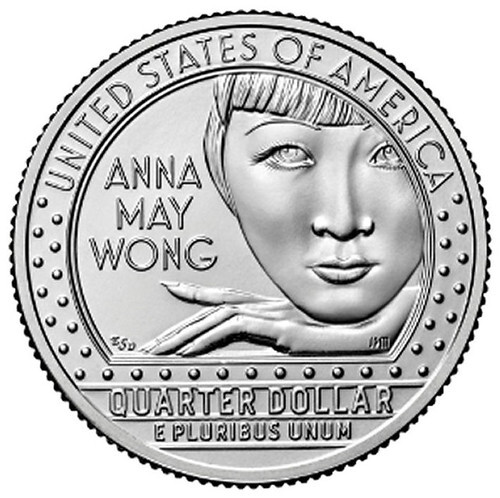
The coin.
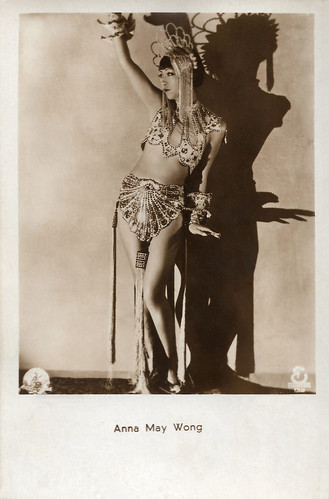
Austrian postcard by Iris-Verlag, no. 5853. Photo: British International Pictures (BIP). Anna May Wong in Piccadilly (Ewald André Dupont, 1929).

German postcard by Ross Verlag, no. 6679/1, 1931-1932. Photo: Paramount. Anna May Wong and Clive Brook in Shanghai Express (Josef von Sternberg, 1932).
Vibrant, Erotic Star Quality
Anna May Wong (Chinese: 黃柳霜; pinyin: Huáng Liǔshuāng) was born Wong Liu Tsong (Frosted Yellow Willows) near the Chinatown neighbourhood of Los Angeles in 1905. She was the second of seven children born to Wong Sam Sing, owner of the Sam Kee Laundry in Los Angeles, and his second wife Lee Gon Toy. Wong had a passion for movies. By the age of 11, she had come up with her stage name Anna May Wong, formed by joining both her English and family names.
Wong was working at Hollywood's Ville de Paris department store when Metro Pictures needed 300 girl extras to appear in The Red Lantern (Albert Capellani, 1919) starring Nazimova as a Eurasian woman who falls in love with an American missionary. The film included scenes shot in Chinatown. Without her father's knowledge, a friend of his with movie connections helped Anna May land an uncredited role as an extra carrying a lantern. In 1921 she dropped out of Los Angeles High School to pursue a full-time acting career. Wong received her first screen credit for Bits of Life (Marshall Neilan, 1921), the first anthology film, in which she played the abused wife of Lon Chaney , playing a Chinaman.
At 17, she played her first leading part, Lotus Flower, in The Toll of the Sea (Chester M. Franklin, 1922), the first Technicolor production. The story by Hollywood's most famous scenarist at the time, Frances Marion, was loosely based on the opera Madame Butterfly but moved the action from Japan to China. Wong also played a concubine in Drifting (Tod Browning, 1923) and a scheming but eye-catching Mongol slave girl running around with Douglas Fairbanks Jr in the super-production The Thief of Bagdad (Raoul Walsh, 1924).
Richard Corliss in Time : “Wong is a luminous presence, fanning her arms in right-angle gestures that seem both Oriental and flapperish. Her best scenes are with Fairbanks, as they connive against each other and radiate contrasting and combined sexiness — a vibrant, erotic star quality.” Wong began cultivating a flapper image and became a fashion icon. In Peter Pan (Herbert Brenon, 1924), shot by her cousin cinematographer James Wong Howe, she played Princess Tiger Lily who shares a long kiss with Betty Bronson as Peter. Peter Pan was the hit of the Christmas season. She appeared again with Lon Chaney in Mr. Wu (William Nigh, 1927) at MGM and with Warner Oland and Dolores Costello in Old San Francisco (Alan Crosland, 1927) at Warner Brothers.
Wong starred in The Silk Bouquet/The Dragon Horse (Harry Revier, 1927), one of the first US films to be produced with Chinese backing, provided by San Francisco's Chinese Six Companies. The story was set in China during the Ming Dynasty and featured Asian actors playing Asian roles. Hollywood studios didn't know what to do with Wong. Her ethnicity prevented US filmmakers from seeing her as a leading lady. Frustrated by the stereotypical supporting roles as the naïve and self-sacrificing ‘Butterfly’ and the evil ‘Dragon Lady’, Anna May Wong left for Europe in 1928.
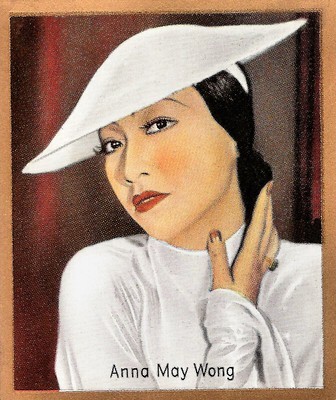
German cigarette card in the series Unsere Bunten Filmbilder by Ross Verlag for Cigarettenfabrik Josetti, Berlin, no. 187. Photo: Paramount.
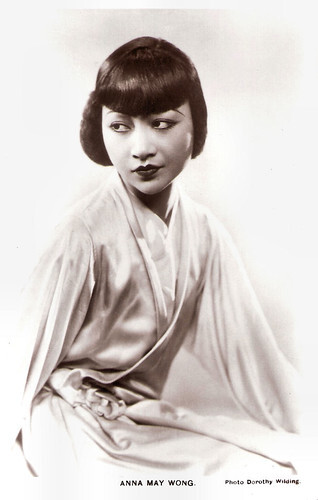
British postcard in the Picturegoer series. Photo: Dorothy Wilding.
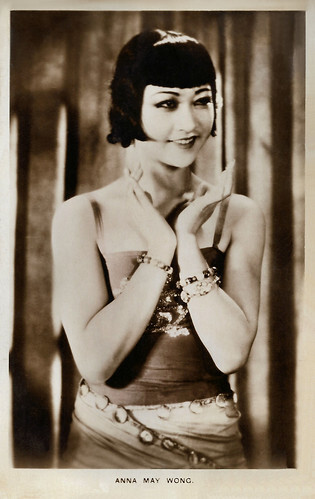
British postcard in the Colourgraph Series, London, no. C 7.
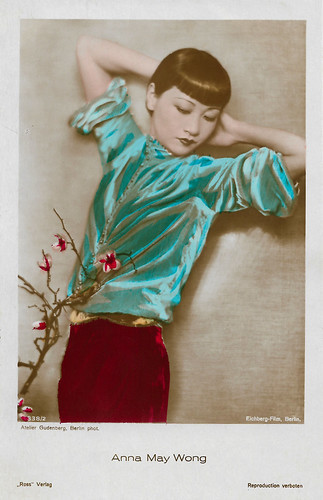
German postcard by Ross Verlag, no. 4338/2, 1929-1930. Photo: Atelier Gudenberg, Berlin / Eichberg-Film, Berlin. Collection: Geoffrey Donaldson Institute.
A Sensation In Europe
In Germany, Anna May Wong became a sensation in Schmutziges Geld/Show Life (Richard Eichberg, 1928) with Heinrich George . The New York Times reported that Wong was "acclaimed not only as an actress of transcendent talent but as a great beauty (...) Berlin critics, who were unanimous in praise of both the star and the production, neglect to mention that Anna May is of American birth. They mention only her Chinese origins."
Other film parts were a circus artist on the run from a murder charge in Großstadtschmetterling/City Butterfly (Richard Eichberg, 1929), and a dancer in pre-Revolutionary Russia in Hai-Tang (Richard Eichberg, Jean Kemm, 1930). In Vienna, she played the title role in the stage operetta 'Tschun Tschi' in fluent German. Wong became an inseparable friend of director Leni Riefenstahl . According to Wikipedia , her close friendships with several women throughout her life, including Marlene Dietrich , led to rumours of lesbianism which damaged her public reputation.
London producer Basil Dean bought the play 'A Circle of Chalk' for Wong to appear in with the young Laurence Olivier , her first stage performance in the UK. Her final silent film, Piccadilly (Ewald André Dupont, 1929), caused a sensation in the UK. Gilda Gray was the top-billed actress, but Variety commented that Wong "outshines the star", and that "from the moment Miss Wong dances in the kitchen's rear, she steals Piccadilly from Miss Gray."
It would be the first of five English films in which she had a starring role, including her first sound film The Flame of Love (Richard Eichberg, Walter Summers, 1930). American studios were looking for fresh European talent. Ironically, Wong caught their eye and she was offered a contract with Paramount Studios in 1930.
She was featured in Daughter of the Dragon (Lloyd Corrigan, 1931) as the vengeful daughter of Fu Manchu (Warner Oland), and with Marlene Dietrich in Shanghai Express (Josef von Sternberg, 1932). Wong spent the first half of the 1930s travelling between the United States and Europe for film and stage work. She repeatedly turned to the stage and cabaret for a creative outlet. On Broadway, she starred in the drama 'On the Spot', which ran for 167 performances and which she would later film as Dangerous to Know (Robert Florey, 1938).
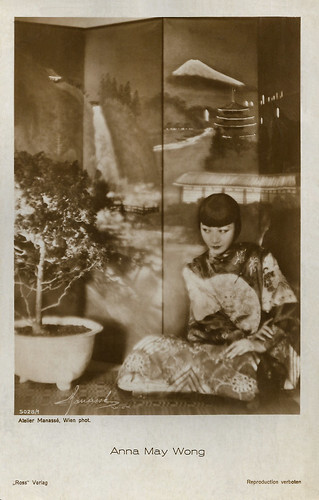
German postcard by Ross Verlag, no. 5028/1, 1930-1931. Photo: Manassé, Wien.
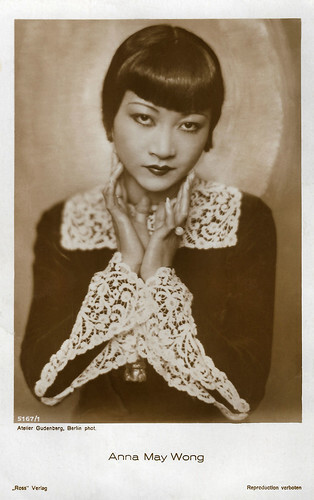
German postcard by Ross Verlag, no. 5167/1, 1930-1931. Photo: Atelier Gudenberg, Berlin.

German postcard by Ross Verlag, no. 5477/1, 1930-1931. Photo: Atelier Manassé, Wien (Vienna).
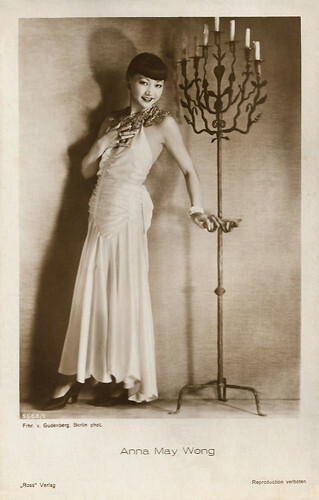
German postcard by Ross Verlag, no. 5568/1, 1930-1931. Photo: Frhr. v. Gudenberg, Berlin.
Too Chinese To Play A Chinese
Anna May Wong became more outspoken in her advocacy for Chinese American causes and for better film roles. Because of the Hays Code's anti-miscegenation rules, she was passed over for the leading female role in The Son-Daughter (Clarence Brown, 1932) in favour of Helen Hayes. Metro-Goldwyn-Mayer deemed her ‘too Chinese to play a Chinese’ in the film, and the Hays Office would not have allowed her to perform romantic scenes since the film's male lead, Ramón Novarro , was not Asian.
Wong was scheduled to play the role of a mistress to a corrupt Chinese general in The Bitter Tea of General Yen (Frank Capra, 1933), but the role went instead to Toshia Mori. Her British film Java Head (Thorold Dickinson, J. Walter Ruben, 1934) was the only film in which Wong kissed the lead male character, her white husband in the film.
In 1935 she was dealt the most severe disappointment of her career when Metro-Goldwyn-Mayer refused to consider her for the leading role of the Chinese character O-Lan in the film version of Pearl S. Buck's The Good Earth (Sidney Franklin, 1937). Paul Muni , an actor of European descent, was to play O-lan's husband, Wang Lung, and MGM chose German actress Luise Rainer for the leading role. Rainer won the Best Actress Oscar for her performance.
Wong spent the next year touring China, visiting her father and her younger brothers and sister in her family's ancestral village Taishan and studying Chinese culture. To complete her contract with Paramount Pictures, she starred in several B movies, including Daughter of Shanghai (Robert Florey, 1937), Dangerous to Know (Robert Florey, 1938), and King of Chinatown (Nick Grinde, 1939) with Akim Tamiroff. These smaller-budgeted films could be bolder than the higher-profile releases, and Wong used this to her advantage to portray successful, professional, Chinese-American characters.
Wong's cabaret act, which included songs in Cantonese, French, English, German, Danish, Swedish, and other languages, took her from the US to Europe and Australia through the 1930s and 1940s. She paid less attention to her film career during World War II but devoted her time and money to helping the Chinese cause against Japan. Wong starred in Lady from Chungking (William Nigh, 1942) and Bombs over Burma (Joseph H. Lewis, 1943), both anti-Japanese propaganda made by the poverty row studio Producers Releasing Corporation. She donated her salary for both films to United China Relief. She invested in real estate and owned a number of properties in Hollywood.
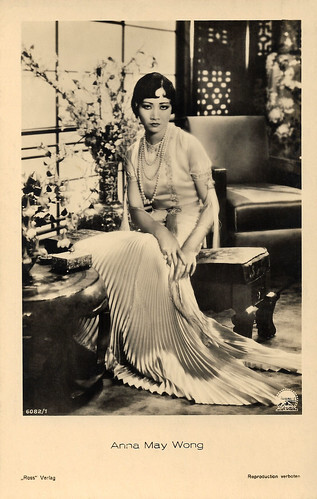
German postcard by Ross Verlag, no. 6082/1, 1931-1932. Photo: Paramount. Anna May Wong in Daughter of the Dragon (Lloyd Corrigan, 1931).
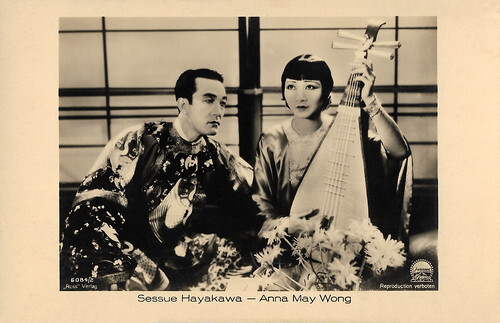
German postcard by Ross Verlag, no. 6084/2, 1931-1932. Photo: Paramount. Sessue Hayakawa and Anna May Wong in Daughter of the Dragon (Lloyd Corrigan, 1931).
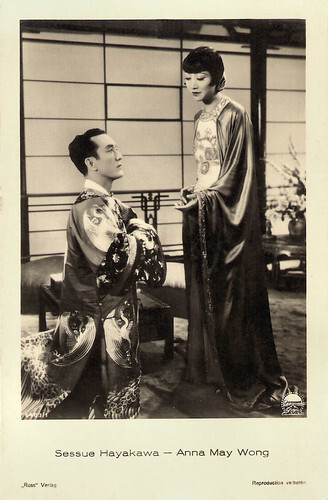
German postcard by Ross Verlag, no. 6403/1, 1931-1932. Photo: Paramount. Sessue Hayakawa and Anna May Wong in Daughter of the Dragon (Lloyd Corrigan, 1931).

German postcard by Ross Verlag, no. 6887/1, 1931-1932. Photo: Paramount.
Rumoured Mistress Of Several Prominent Film Men
Anna May Wong returned to the public eye in the 1950s in several television appearances as well as her own detective series The Gallery of Madame Liu-Tsong (1951-1952), the first US television show starring an Asian-American series lead. After the completion of the series, Wong's health began to deteriorate. In late 1953 she suffered an internal haemorrhage, which her brother attributed to the onset of menopause, her continued heavy drinking, and financial worries.
In the following years, she did guest spots on television series. In 1960, she returned to film playing housekeeper to Lana Turner in the thriller Portrait in Black (Michael Gordon, 1960). She was scheduled to play the role of Madame Liang in the film production of Rodgers and Hammerstein's Flower Drum Song (Henry Koster, 1961) when she died of a heart attack at home in Santa Monica in 1961.
Anna May Wong was 56. For decades after her death, Wong was remembered principally for the stereotypical sly ‘Dragon Lady’ and demure ‘Butterfly’ roles that she was often given. Anna May Wong never married, but over the years, she was the rumoured mistress of several prominent film men: Marshall Neilan (14 years older, supposedly Wong's lover when she was 15), director Tod Browning (23 years older, when she was 16) and Charles Rosher ( Mary Pickford 's favourite cinematographer, who was nearly 20 years older, when Wong was 20). But no biographer can say for sure that any of these affairs occurred.
Matthew Sweet in The Guardian : “And this is the trouble with Anna May Wong. We disapprove of the stereotypes she fleshed out - the treacherous, tragic daughters of the dragon - but her performances still seduce, for the same reason they did in the 1920s and 30s.” Her life and career were re-evaluated by three new biographies, a meticulous filmography, and a British documentary about her life, called Frosted Yellow Willows.
Wikipedia : “Through her films, public appearances and prominent magazine features, she helped to ‘humanize’ Asian Americans to white audiences during a period of overt racism and discrimination. Asian Americans, especially the Chinese, had been viewed as perpetually foreign in U.S. society but Wong's films and public image established her as an Asian-American citizen at a time when laws discriminated against Asian immigration and citizenship.”
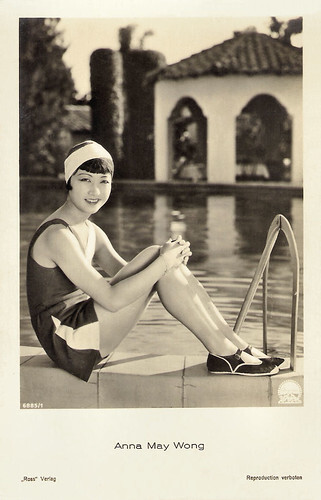
German postcard by Ross Verlag, no. 6885/1, 1931-1932. Photo: Paramount.
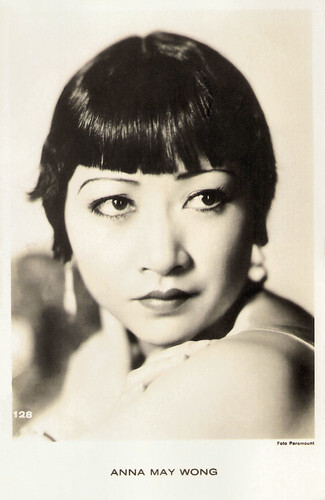
Dutch postcard, no. 128. Photo: Paramount. Sent by mail in 1932.
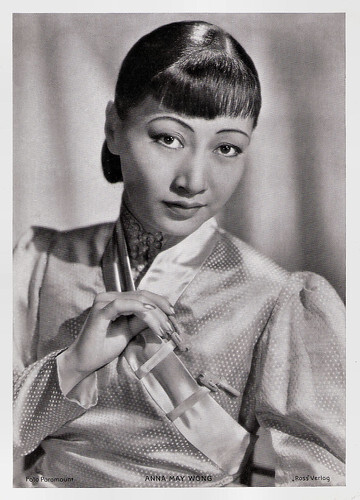
German postcard by Ross Verlag. Photo: Paramount.
Anna May Wong in a clip of Piccadilly (1929). Source: BFI (YouTube).
Marlene Dietrich and Anna May Wong in a cheeky scene from Shanghai Express (1932). Source: JD Stirling (YouTube).
Sources: Richard Corliss (Time), Matthew Sweet (The Guardian), (IMDb), Wikipedia and .

German postcard by Ross Verlag, no. 5028/2, 1930-1931. Photo: Atelier Manassé, Wien (Vienna).

The coin.

Austrian postcard by Iris-Verlag, no. 5853. Photo: British International Pictures (BIP). Anna May Wong in Piccadilly (Ewald André Dupont, 1929).

German postcard by Ross Verlag, no. 6679/1, 1931-1932. Photo: Paramount. Anna May Wong and Clive Brook in Shanghai Express (Josef von Sternberg, 1932).
Vibrant, Erotic Star Quality
Anna May Wong (Chinese: 黃柳霜; pinyin: Huáng Liǔshuāng) was born Wong Liu Tsong (Frosted Yellow Willows) near the Chinatown neighbourhood of Los Angeles in 1905. She was the second of seven children born to Wong Sam Sing, owner of the Sam Kee Laundry in Los Angeles, and his second wife Lee Gon Toy. Wong had a passion for movies. By the age of 11, she had come up with her stage name Anna May Wong, formed by joining both her English and family names.
Wong was working at Hollywood's Ville de Paris department store when Metro Pictures needed 300 girl extras to appear in The Red Lantern (Albert Capellani, 1919) starring Nazimova as a Eurasian woman who falls in love with an American missionary. The film included scenes shot in Chinatown. Without her father's knowledge, a friend of his with movie connections helped Anna May land an uncredited role as an extra carrying a lantern. In 1921 she dropped out of Los Angeles High School to pursue a full-time acting career. Wong received her first screen credit for Bits of Life (Marshall Neilan, 1921), the first anthology film, in which she played the abused wife of Lon Chaney , playing a Chinaman.
At 17, she played her first leading part, Lotus Flower, in The Toll of the Sea (Chester M. Franklin, 1922), the first Technicolor production. The story by Hollywood's most famous scenarist at the time, Frances Marion, was loosely based on the opera Madame Butterfly but moved the action from Japan to China. Wong also played a concubine in Drifting (Tod Browning, 1923) and a scheming but eye-catching Mongol slave girl running around with Douglas Fairbanks Jr in the super-production The Thief of Bagdad (Raoul Walsh, 1924).
Richard Corliss in Time : “Wong is a luminous presence, fanning her arms in right-angle gestures that seem both Oriental and flapperish. Her best scenes are with Fairbanks, as they connive against each other and radiate contrasting and combined sexiness — a vibrant, erotic star quality.” Wong began cultivating a flapper image and became a fashion icon. In Peter Pan (Herbert Brenon, 1924), shot by her cousin cinematographer James Wong Howe, she played Princess Tiger Lily who shares a long kiss with Betty Bronson as Peter. Peter Pan was the hit of the Christmas season. She appeared again with Lon Chaney in Mr. Wu (William Nigh, 1927) at MGM and with Warner Oland and Dolores Costello in Old San Francisco (Alan Crosland, 1927) at Warner Brothers.
Wong starred in The Silk Bouquet/The Dragon Horse (Harry Revier, 1927), one of the first US films to be produced with Chinese backing, provided by San Francisco's Chinese Six Companies. The story was set in China during the Ming Dynasty and featured Asian actors playing Asian roles. Hollywood studios didn't know what to do with Wong. Her ethnicity prevented US filmmakers from seeing her as a leading lady. Frustrated by the stereotypical supporting roles as the naïve and self-sacrificing ‘Butterfly’ and the evil ‘Dragon Lady’, Anna May Wong left for Europe in 1928.

German cigarette card in the series Unsere Bunten Filmbilder by Ross Verlag for Cigarettenfabrik Josetti, Berlin, no. 187. Photo: Paramount.

British postcard in the Picturegoer series. Photo: Dorothy Wilding.

British postcard in the Colourgraph Series, London, no. C 7.

German postcard by Ross Verlag, no. 4338/2, 1929-1930. Photo: Atelier Gudenberg, Berlin / Eichberg-Film, Berlin. Collection: Geoffrey Donaldson Institute.
A Sensation In Europe
In Germany, Anna May Wong became a sensation in Schmutziges Geld/Show Life (Richard Eichberg, 1928) with Heinrich George . The New York Times reported that Wong was "acclaimed not only as an actress of transcendent talent but as a great beauty (...) Berlin critics, who were unanimous in praise of both the star and the production, neglect to mention that Anna May is of American birth. They mention only her Chinese origins."
Other film parts were a circus artist on the run from a murder charge in Großstadtschmetterling/City Butterfly (Richard Eichberg, 1929), and a dancer in pre-Revolutionary Russia in Hai-Tang (Richard Eichberg, Jean Kemm, 1930). In Vienna, she played the title role in the stage operetta 'Tschun Tschi' in fluent German. Wong became an inseparable friend of director Leni Riefenstahl . According to Wikipedia , her close friendships with several women throughout her life, including Marlene Dietrich , led to rumours of lesbianism which damaged her public reputation.
London producer Basil Dean bought the play 'A Circle of Chalk' for Wong to appear in with the young Laurence Olivier , her first stage performance in the UK. Her final silent film, Piccadilly (Ewald André Dupont, 1929), caused a sensation in the UK. Gilda Gray was the top-billed actress, but Variety commented that Wong "outshines the star", and that "from the moment Miss Wong dances in the kitchen's rear, she steals Piccadilly from Miss Gray."
It would be the first of five English films in which she had a starring role, including her first sound film The Flame of Love (Richard Eichberg, Walter Summers, 1930). American studios were looking for fresh European talent. Ironically, Wong caught their eye and she was offered a contract with Paramount Studios in 1930.
She was featured in Daughter of the Dragon (Lloyd Corrigan, 1931) as the vengeful daughter of Fu Manchu (Warner Oland), and with Marlene Dietrich in Shanghai Express (Josef von Sternberg, 1932). Wong spent the first half of the 1930s travelling between the United States and Europe for film and stage work. She repeatedly turned to the stage and cabaret for a creative outlet. On Broadway, she starred in the drama 'On the Spot', which ran for 167 performances and which she would later film as Dangerous to Know (Robert Florey, 1938).

German postcard by Ross Verlag, no. 5028/1, 1930-1931. Photo: Manassé, Wien.

German postcard by Ross Verlag, no. 5167/1, 1930-1931. Photo: Atelier Gudenberg, Berlin.

German postcard by Ross Verlag, no. 5477/1, 1930-1931. Photo: Atelier Manassé, Wien (Vienna).

German postcard by Ross Verlag, no. 5568/1, 1930-1931. Photo: Frhr. v. Gudenberg, Berlin.
Too Chinese To Play A Chinese
Anna May Wong became more outspoken in her advocacy for Chinese American causes and for better film roles. Because of the Hays Code's anti-miscegenation rules, she was passed over for the leading female role in The Son-Daughter (Clarence Brown, 1932) in favour of Helen Hayes. Metro-Goldwyn-Mayer deemed her ‘too Chinese to play a Chinese’ in the film, and the Hays Office would not have allowed her to perform romantic scenes since the film's male lead, Ramón Novarro , was not Asian.
Wong was scheduled to play the role of a mistress to a corrupt Chinese general in The Bitter Tea of General Yen (Frank Capra, 1933), but the role went instead to Toshia Mori. Her British film Java Head (Thorold Dickinson, J. Walter Ruben, 1934) was the only film in which Wong kissed the lead male character, her white husband in the film.
In 1935 she was dealt the most severe disappointment of her career when Metro-Goldwyn-Mayer refused to consider her for the leading role of the Chinese character O-Lan in the film version of Pearl S. Buck's The Good Earth (Sidney Franklin, 1937). Paul Muni , an actor of European descent, was to play O-lan's husband, Wang Lung, and MGM chose German actress Luise Rainer for the leading role. Rainer won the Best Actress Oscar for her performance.
Wong spent the next year touring China, visiting her father and her younger brothers and sister in her family's ancestral village Taishan and studying Chinese culture. To complete her contract with Paramount Pictures, she starred in several B movies, including Daughter of Shanghai (Robert Florey, 1937), Dangerous to Know (Robert Florey, 1938), and King of Chinatown (Nick Grinde, 1939) with Akim Tamiroff. These smaller-budgeted films could be bolder than the higher-profile releases, and Wong used this to her advantage to portray successful, professional, Chinese-American characters.
Wong's cabaret act, which included songs in Cantonese, French, English, German, Danish, Swedish, and other languages, took her from the US to Europe and Australia through the 1930s and 1940s. She paid less attention to her film career during World War II but devoted her time and money to helping the Chinese cause against Japan. Wong starred in Lady from Chungking (William Nigh, 1942) and Bombs over Burma (Joseph H. Lewis, 1943), both anti-Japanese propaganda made by the poverty row studio Producers Releasing Corporation. She donated her salary for both films to United China Relief. She invested in real estate and owned a number of properties in Hollywood.

German postcard by Ross Verlag, no. 6082/1, 1931-1932. Photo: Paramount. Anna May Wong in Daughter of the Dragon (Lloyd Corrigan, 1931).

German postcard by Ross Verlag, no. 6084/2, 1931-1932. Photo: Paramount. Sessue Hayakawa and Anna May Wong in Daughter of the Dragon (Lloyd Corrigan, 1931).

German postcard by Ross Verlag, no. 6403/1, 1931-1932. Photo: Paramount. Sessue Hayakawa and Anna May Wong in Daughter of the Dragon (Lloyd Corrigan, 1931).

German postcard by Ross Verlag, no. 6887/1, 1931-1932. Photo: Paramount.
Rumoured Mistress Of Several Prominent Film Men
Anna May Wong returned to the public eye in the 1950s in several television appearances as well as her own detective series The Gallery of Madame Liu-Tsong (1951-1952), the first US television show starring an Asian-American series lead. After the completion of the series, Wong's health began to deteriorate. In late 1953 she suffered an internal haemorrhage, which her brother attributed to the onset of menopause, her continued heavy drinking, and financial worries.
In the following years, she did guest spots on television series. In 1960, she returned to film playing housekeeper to Lana Turner in the thriller Portrait in Black (Michael Gordon, 1960). She was scheduled to play the role of Madame Liang in the film production of Rodgers and Hammerstein's Flower Drum Song (Henry Koster, 1961) when she died of a heart attack at home in Santa Monica in 1961.
Anna May Wong was 56. For decades after her death, Wong was remembered principally for the stereotypical sly ‘Dragon Lady’ and demure ‘Butterfly’ roles that she was often given. Anna May Wong never married, but over the years, she was the rumoured mistress of several prominent film men: Marshall Neilan (14 years older, supposedly Wong's lover when she was 15), director Tod Browning (23 years older, when she was 16) and Charles Rosher ( Mary Pickford 's favourite cinematographer, who was nearly 20 years older, when Wong was 20). But no biographer can say for sure that any of these affairs occurred.
Matthew Sweet in The Guardian : “And this is the trouble with Anna May Wong. We disapprove of the stereotypes she fleshed out - the treacherous, tragic daughters of the dragon - but her performances still seduce, for the same reason they did in the 1920s and 30s.” Her life and career were re-evaluated by three new biographies, a meticulous filmography, and a British documentary about her life, called Frosted Yellow Willows.
Wikipedia : “Through her films, public appearances and prominent magazine features, she helped to ‘humanize’ Asian Americans to white audiences during a period of overt racism and discrimination. Asian Americans, especially the Chinese, had been viewed as perpetually foreign in U.S. society but Wong's films and public image established her as an Asian-American citizen at a time when laws discriminated against Asian immigration and citizenship.”

German postcard by Ross Verlag, no. 6885/1, 1931-1932. Photo: Paramount.

Dutch postcard, no. 128. Photo: Paramount. Sent by mail in 1932.

German postcard by Ross Verlag. Photo: Paramount.
Anna May Wong in a clip of Piccadilly (1929). Source: BFI (YouTube).
Marlene Dietrich and Anna May Wong in a cheeky scene from Shanghai Express (1932). Source: JD Stirling (YouTube).
Sources: Richard Corliss (Time), Matthew Sweet (The Guardian), (IMDb), Wikipedia and .
Published on October 19, 2022 22:00
October 18, 2022
Lu L'Arronge
Little is known about Lu L'Arronge, who was for a few years a star of the German silent cinema, just after the First World War. The actress, who specialised in playing high-spirited teenagers, had her own production company with which she produced several films.
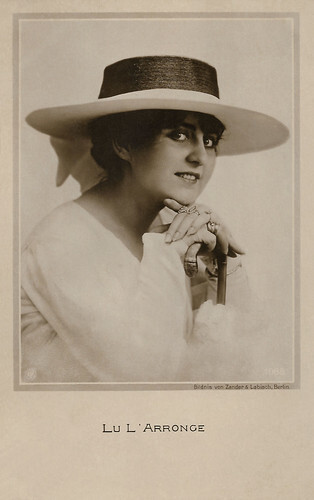 German postcard by NPG, no. 1068. Photo: Zander & Labisch, Berlin.
German postcard by NPG, no. 1068. Photo: Zander & Labisch, Berlin.
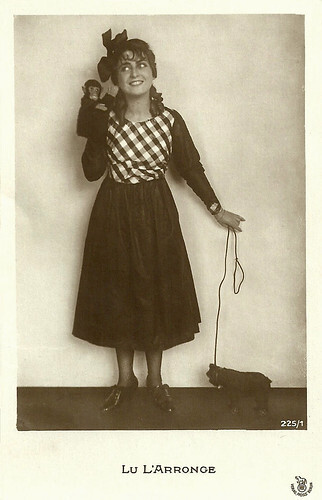
German postcard by Rotophot in the Film-Sterne series, no. 225/1, 1919-1924.
Half a woman, half a girl
Five years ago, when I wrote the first version of this post, there were some star postcards to prove that Lu L'Arronge must have been a well-known actress at the time, but that surprisingly little was known about her. This has changed since then. Thanks to the sources mentioned below, we can now tell a bit more about Lu's life and work. But a lot still stays unclear.
Lu L'Arronge was born in a Jewish family of actors, directors and playwrights. She was a distant relative to the playwright, critic and theatre manager Adolf L'Arronge (1838-1908), although the exact family ties are unclear. Adolf L'Arronge's father, the actor and theatre director Theodor Eberhard changed his name from Aaronsohn to L'Arronge. Though IMDb gives the life dates of 1901-1991 for Lu L'Arronge, Stephanie D'Heil at Steffi-Line remarks that this is an error and that the dates are linked to another actress, Lia L'Arronge, originally Lia Fricke, and married to Gerhart L'Arronge.
According to IMDb 's trivia section: "The actress Lu L'Arronge cherished early the wish to become a stage actress. Not least because her grandfather belonged to the founders of the Bühnengenossenschaft and her father's cousin was the well-known stage writer Adolf L'Arronge." This is based on L'Arronge's own words in the volume Die Frau im Film 1919 (The Woman in Film 1919), a series of short interviews with German actresses of that time. At an early age, Lu cherished the wish to become a stage actress, but her mother didn't accept that her daughter would become an actress. When the German film industry became 'modern' during World War I and conquered a huge public, Lu's wish to become an actress returned and she knew to convince her mother.
Thomas Schaedeli writes at his site Cyranos that Lu conquered the big screen from 1917 on. She played in films like Die Schlange der Kleopatra/The Serpent of Cleopatra (1917), Lu's Backfischzeit/Lu's Backfisch Times (1917), Lu'chens Verlobung am Gartentor/Little Lu's engagement at the garden gate (1917), s'Liserl vom Loischtal (1917) and Kain (1918). These films were mainly produced by Franz Schmelter, who also was her regular director, starting with Die Schlange der Kleopatra (1917) and Lu'chens Verlobung am Gartentor (1917)
Schaedeli adds that she finally founded her own company in 1919, to star in films including Wenn's Landlüferl weht/When the country breeze blows (1918), Anna Karenina (1919), Die weisse Maus/The White Mouse (1919), and Die Geisterbraut/The Ghost Bride (1919).
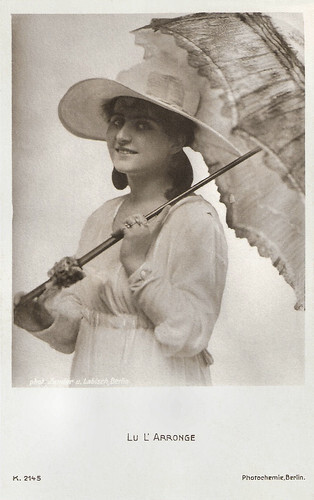
German postcard by Photochemie, Berlin, no. K.2145. Photo by Zander u. Labisch, Berlin.
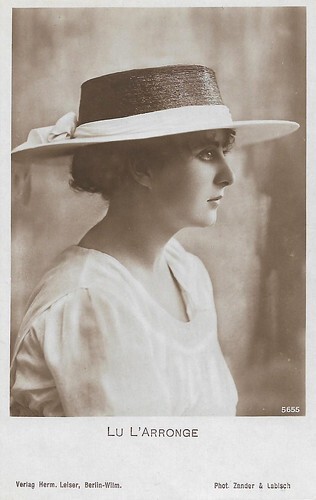
German postcard by Verlag Hermann Leiser, Berlin, no. 5655. Photo: Zander & Labisch.

German postcard by Photochemie, Berlin, no. K.2895. Photo: Atelier Vielbrandt, Berlin.
The Ghost Bride
IMDb shows that Lu's production company L'Arronge Film GmbH was already founded in 1917 for the comedy Lu's Backfischzeit/Lu's Backfisch times (Franz Schmelter, 1917). L'Arronge Film GmbH produced 9 films including Wenn's Landlüferl weht/When the country breeze blows (Karl Moos, 1918), and Die weisse Maus/The White Mouse (Leonhard Haskel, 1919), but then the film company halted. In her 'Backfisch' (teenager) comedies, Anna Müller-Lincke was a regular performer.
She appeared also in Die Geisterbraut/The Ghost Bride (Herbert Gerdes, 1920), produced by Georg Alexander 's company Neue Berliner Film. But L'Arronge's screen career quickly went downhill.
In the Leo Tolstoy adaptation Anna Karenina (Friedrich Zelnik/Frederic Zelnik, 1920), Lu only had a minor part. The Star of the film was Lya Mara and the film was produced by her and her husband-director's company Zelnik-Mara-Film. It must have been Lu's final film.
A few years before, Lu was interviewed for the publication Die Frau im Film 1919 (The Woman in Film 1919), in which several female stars of the silent German cinema (including Erna Morena , Pola Negri , Lya Mara ) answered questions about their work. Lu said that she had "the big luck to be engaged at a new-created firm, for one year, for which I gave my name. Here I prefer to play the high-spirited teenager things, half a woman, half a girl."
IMDd lists that Lu L'Arronge acted during her career in 15 films between 1917 and 1920 and that she produced 9 films. What happened with Lu after her film dream was over?
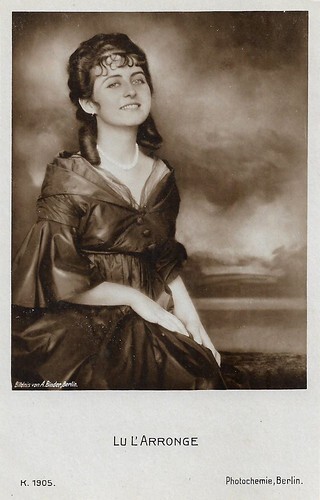
German postcard by Photochemie, Berlin, no. K.1905. Photo: Alex Binder, Berlin.
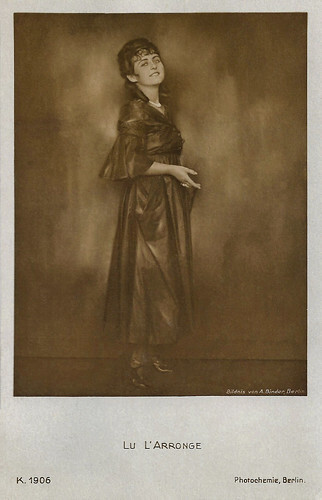
German postcard by Photochemie, Berlin, no. K.1906. Photo: Alex Binder, Berlin.
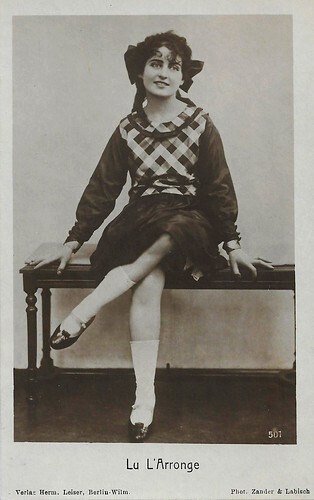
German postcard by Verlag Hermann Leiser, Berlin, no. 501. Photo: Zander & Labisch.
Sources: Stephanie D'heil (Steffi-Line - German), Thomas Staedeli (Cyranos), Die Frau im Film 1919, Filmportal.de, and .
 German postcard by NPG, no. 1068. Photo: Zander & Labisch, Berlin.
German postcard by NPG, no. 1068. Photo: Zander & Labisch, Berlin.
German postcard by Rotophot in the Film-Sterne series, no. 225/1, 1919-1924.
Half a woman, half a girl
Five years ago, when I wrote the first version of this post, there were some star postcards to prove that Lu L'Arronge must have been a well-known actress at the time, but that surprisingly little was known about her. This has changed since then. Thanks to the sources mentioned below, we can now tell a bit more about Lu's life and work. But a lot still stays unclear.
Lu L'Arronge was born in a Jewish family of actors, directors and playwrights. She was a distant relative to the playwright, critic and theatre manager Adolf L'Arronge (1838-1908), although the exact family ties are unclear. Adolf L'Arronge's father, the actor and theatre director Theodor Eberhard changed his name from Aaronsohn to L'Arronge. Though IMDb gives the life dates of 1901-1991 for Lu L'Arronge, Stephanie D'Heil at Steffi-Line remarks that this is an error and that the dates are linked to another actress, Lia L'Arronge, originally Lia Fricke, and married to Gerhart L'Arronge.
According to IMDb 's trivia section: "The actress Lu L'Arronge cherished early the wish to become a stage actress. Not least because her grandfather belonged to the founders of the Bühnengenossenschaft and her father's cousin was the well-known stage writer Adolf L'Arronge." This is based on L'Arronge's own words in the volume Die Frau im Film 1919 (The Woman in Film 1919), a series of short interviews with German actresses of that time. At an early age, Lu cherished the wish to become a stage actress, but her mother didn't accept that her daughter would become an actress. When the German film industry became 'modern' during World War I and conquered a huge public, Lu's wish to become an actress returned and she knew to convince her mother.
Thomas Schaedeli writes at his site Cyranos that Lu conquered the big screen from 1917 on. She played in films like Die Schlange der Kleopatra/The Serpent of Cleopatra (1917), Lu's Backfischzeit/Lu's Backfisch Times (1917), Lu'chens Verlobung am Gartentor/Little Lu's engagement at the garden gate (1917), s'Liserl vom Loischtal (1917) and Kain (1918). These films were mainly produced by Franz Schmelter, who also was her regular director, starting with Die Schlange der Kleopatra (1917) and Lu'chens Verlobung am Gartentor (1917)
Schaedeli adds that she finally founded her own company in 1919, to star in films including Wenn's Landlüferl weht/When the country breeze blows (1918), Anna Karenina (1919), Die weisse Maus/The White Mouse (1919), and Die Geisterbraut/The Ghost Bride (1919).

German postcard by Photochemie, Berlin, no. K.2145. Photo by Zander u. Labisch, Berlin.

German postcard by Verlag Hermann Leiser, Berlin, no. 5655. Photo: Zander & Labisch.

German postcard by Photochemie, Berlin, no. K.2895. Photo: Atelier Vielbrandt, Berlin.
The Ghost Bride
IMDb shows that Lu's production company L'Arronge Film GmbH was already founded in 1917 for the comedy Lu's Backfischzeit/Lu's Backfisch times (Franz Schmelter, 1917). L'Arronge Film GmbH produced 9 films including Wenn's Landlüferl weht/When the country breeze blows (Karl Moos, 1918), and Die weisse Maus/The White Mouse (Leonhard Haskel, 1919), but then the film company halted. In her 'Backfisch' (teenager) comedies, Anna Müller-Lincke was a regular performer.
She appeared also in Die Geisterbraut/The Ghost Bride (Herbert Gerdes, 1920), produced by Georg Alexander 's company Neue Berliner Film. But L'Arronge's screen career quickly went downhill.
In the Leo Tolstoy adaptation Anna Karenina (Friedrich Zelnik/Frederic Zelnik, 1920), Lu only had a minor part. The Star of the film was Lya Mara and the film was produced by her and her husband-director's company Zelnik-Mara-Film. It must have been Lu's final film.
A few years before, Lu was interviewed for the publication Die Frau im Film 1919 (The Woman in Film 1919), in which several female stars of the silent German cinema (including Erna Morena , Pola Negri , Lya Mara ) answered questions about their work. Lu said that she had "the big luck to be engaged at a new-created firm, for one year, for which I gave my name. Here I prefer to play the high-spirited teenager things, half a woman, half a girl."
IMDd lists that Lu L'Arronge acted during her career in 15 films between 1917 and 1920 and that she produced 9 films. What happened with Lu after her film dream was over?

German postcard by Photochemie, Berlin, no. K.1905. Photo: Alex Binder, Berlin.

German postcard by Photochemie, Berlin, no. K.1906. Photo: Alex Binder, Berlin.

German postcard by Verlag Hermann Leiser, Berlin, no. 501. Photo: Zander & Labisch.
Sources: Stephanie D'heil (Steffi-Line - German), Thomas Staedeli (Cyranos), Die Frau im Film 1919, Filmportal.de, and .
Published on October 18, 2022 22:00
October 17, 2022
Demi Moore
Demi Moore (1962) is an American actress and film producer who had her breakthrough with the Bratpack film St. Elmo's Fire (1985). By 1995 Moore was the highest-paid actress in Hollywood thanks to such blockbusters as Ghost (1990), A Few Good Men (1992) and Indecent Proposal (1993).
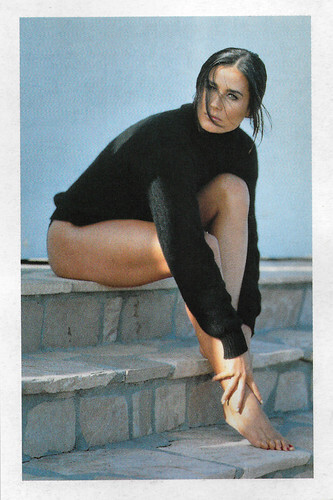
Belgian postcard in the 'De 50 mooiste vrouwen van de eeuw' (The 50 most beautiful women of the century) series by P-Magazine, no. 7. Photo: Lance Steadler / Outline.
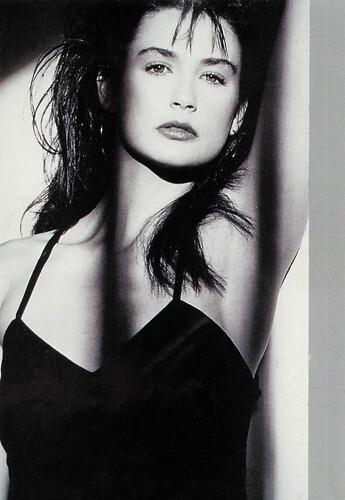
British postcard by Heroes Publishing Ltd, London, no. SPC 2572.
The girl of the Brat Pack
Demi Moore was born Demi Gene Guynes in Roswell, New Mexico in 1962. Her father, Air Force airman Charles Harmon, left her then 18-year-old mother Victoria (née King) after a two-month marriage and before Demi was born. When Demi Moore was three months old, her mother married Dan Guynes, a newspaper salesman, who she later saw as her real father.
The family moved frequently because of her stepfather's work, more than thirty times. Her stepfather committed suicide when Demi was fifteen, two years after divorcing her mother. A year later she dropped out of school. Her mother, Virginia Guynes, was arrested many times, including for arson and drunk driving. Moore broke off contact with her in 1990 but later reconciled with her shortly before she died of cancer in 1998 at the age of 54.
In 1979, three months before her 17th birthday, Demi met the rock musician Freddy Moore and they married in 1980. The marriage lasted four years. Moore signed with the Elite Modeling Agency and then enrolled in drama classes after being inspired by her next-door neighbour, 17-year-old German actress Nastassja Kinski . She appeared on the cover of the January 1981 issue of the French adult magazine Oui, taken from a photo session in which she had posed nude, and made her film debut with a brief role in the teen drama Choices (Silvio Narizzano, 1981).
In 1982, she played an investigative reporter in the hospital soap General Hospital (1982-1983). She celebrated her first cinema success in the romantic comedy Blame it on Rio (Stanley Donen, 1983) opposite Michael Caine . Around the same time, she became addicted to cocaine. Her big break came with the film St. Elmo's Fire (Joel Schumacher, 1985) with Rob Lowe and Emilio Estevez, to whom she was engaged for three years. Reportedly, she was fired by Schumacher during filming because of her drug abuse, after which she went to rehab and returned a week later. Interestingly, her character in the film, Jules, was also addicted to cocaine.
The film was a huge success, and Moore and her film counterparts were counted among the 'Brat Pack', a group of young actors with a promising future. Moore progressed to more serious material with the romantic comedy About Last Night... (Edward Zwick, 1986), co-starring Rob Lowe, which marked a positive turning point in her career. In 1987, she became even more famous when she married actor Bruce Willis.
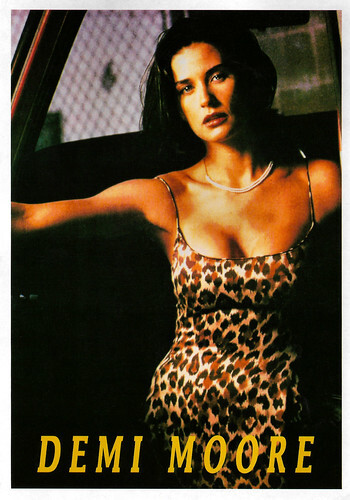
Turkish postcard by Laden, no. 98/191.
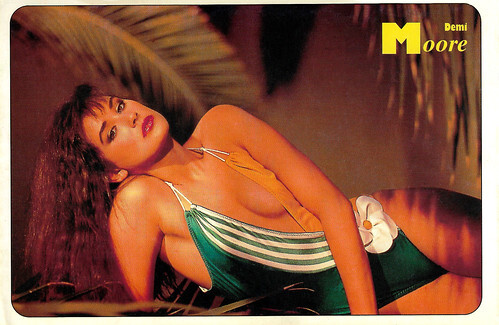
Italian postcard in the collection 'Le più belle del mondo' by Teletutto, no. 9.
A spot on the A-list
In 1990, Demi Moore co-starred with Patrick Swayze and Whoopi Goldberg in the highly successful fantasy Ghost (Jerry Zucker, 1990), for which she received a Golden Globe nomination. The love scene between Moore and Patrick Swayze that starts in front of a potter's wheel to the sound of 'Unchained Melody' became an iconic moment in film history and the film grossed over US$505 million at the box office.
'The highest-grossing film of that year' earned her a spot on the A-list and offered her many leading roles in films. The following year, she received a great deal of media attention when she appeared naked on the front page of Vanity Fair magazine while seven months pregnant. The front page was frequently imitated and parodied in the years that followed.
The next year, she starred in the blockbuster A Few Good Men (Rob Reiner, 1992), opposite Tom Cruise and Jack Nicholson . The following year, she scored another big film hit with the controversial Indecent Proposal (Adrian Lyne, 1993). In this film, a rich businessman ( Robert Redford ) presents a couple with financial problems (Moore and Woody Harrelson) with a dilemma: he gives the couple a million dollars if he can sleep with the woman.
Another blockbuster was the thriller Disclosure (Barry Levinson, 1994) with Michael Douglas . Moore produced and starred in a controversial miniseries for HBO called If These Walls Could Talk (1996), a three-part anthology about abortion alongside Sissy Spacek and Cher . Its screenwriter, Nancy Savoca, directed two segments, including one in which Moore played a widowed nurse in the early 1950s seeking a back-alley abortion.
For that role, Demi Moore received a second Golden Globe nomination as Best Actress. At the time, Moore was one of the highest-paid film actresses of all time, and she was the first actress to receive more than $10 million for a film role - $12.5 million for Striptease (Andrew Bergman, 1996).
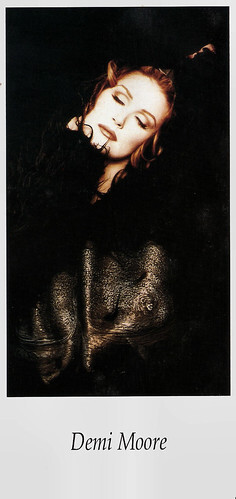
Belgian postcard by MultiChoice Kaleidoscope. Photo: Isopress / Outline / Steven Klein.
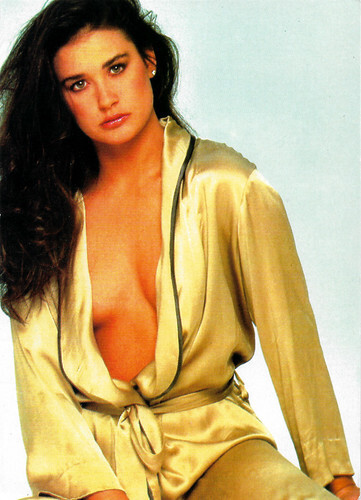
British postcard.
A Golden Raspberry
Demi Moore did not manage to keep up the success. Striptease (Andrew Bergman, 1996) opened to overwhelmingly negative reviews with Moore's performance being criticised and 'won' six Golden Raspberry Awards, including for worst film, worst actress and worst director. However, it was a moderate financial success, grossing US$113 million worldwide.
Moore also starred in the thriller The Juror (Brian Gibson, 1996). It was a box office bomb and was heavily panned by critics. Her two successes at the time were as the voice of the gipsy woman Esmeralda in Disney's animated film The Hunchback of Notre Dame (Kirk Wise, Gary Trousdale, 1996) and the voice of Dallas Grimes in the animated comedy Beavis and Butt-head Do America (Mike Judge, 1996), alongside her then-husband Bruce Willis.
When her long-cherished project G.I. Jane (Ridley Scott, 1997), for which the actress even shaved her head, turned out to be another flop, Demi Moore took a break in her acting career. As a producer, she did have a few successes with the three Austin Powers films, including Austin Powers: International Man of Mystery (Jay Roach, 1997).
Moore and Bruce Willis separated in 1998 and divorced in 2000. Together they have three children: Rumer Glen Willis (born 1988), Scout LaRue Willis (1991) and Tallulah Belle Willis (1994). In 2003, she had a much-discussed relationship with the sixteen-year-younger actor Ashton Kutcher, whom she married in 2005. That same year, she returned to the big screen by playing the villain in the sequel Charlie's Angels: Full Throttle (McG, 2005), starring Cameron Diaz , Drew Barrymore and Lucy Liu.
Since 2006, Demi has been the face and muse of cosmetics brand Helena Rubinstein. On-screen she could be seen in the ensemble cast of the acclaimed dramas Bobby (Emilio Estevez, 2006) and Margin Call (J. C. Chandor, 2011) with Kevin Spacey. Moore and Kutcher split in 2011 and their divorce was finalised in 2013. Incidentally, she appeared in films such as the black comedy Rough Night/Girls' Night Out (Lucia Aniello, 2017) starring Scarlett Johansson. In 2019, Moore released her book 'Inside Out' about her life, which reached the top spot on the New York Times Bestseller list. Since early 2022, Demi Moore has been in a relationship with Swiss celebrity chef Daniel Humm.

Canadian postcard by Canadian Postcard, no. A-284.
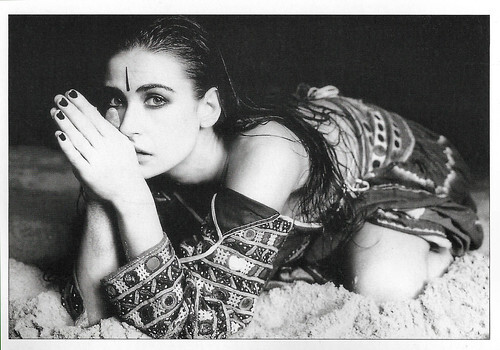
Italian postcard by CIAK. Photo: Dave Stewart / Colorific / G. Neri.
Sources: Wikipedia (Dutch, English and German), and .

Belgian postcard in the 'De 50 mooiste vrouwen van de eeuw' (The 50 most beautiful women of the century) series by P-Magazine, no. 7. Photo: Lance Steadler / Outline.

British postcard by Heroes Publishing Ltd, London, no. SPC 2572.
The girl of the Brat Pack
Demi Moore was born Demi Gene Guynes in Roswell, New Mexico in 1962. Her father, Air Force airman Charles Harmon, left her then 18-year-old mother Victoria (née King) after a two-month marriage and before Demi was born. When Demi Moore was three months old, her mother married Dan Guynes, a newspaper salesman, who she later saw as her real father.
The family moved frequently because of her stepfather's work, more than thirty times. Her stepfather committed suicide when Demi was fifteen, two years after divorcing her mother. A year later she dropped out of school. Her mother, Virginia Guynes, was arrested many times, including for arson and drunk driving. Moore broke off contact with her in 1990 but later reconciled with her shortly before she died of cancer in 1998 at the age of 54.
In 1979, three months before her 17th birthday, Demi met the rock musician Freddy Moore and they married in 1980. The marriage lasted four years. Moore signed with the Elite Modeling Agency and then enrolled in drama classes after being inspired by her next-door neighbour, 17-year-old German actress Nastassja Kinski . She appeared on the cover of the January 1981 issue of the French adult magazine Oui, taken from a photo session in which she had posed nude, and made her film debut with a brief role in the teen drama Choices (Silvio Narizzano, 1981).
In 1982, she played an investigative reporter in the hospital soap General Hospital (1982-1983). She celebrated her first cinema success in the romantic comedy Blame it on Rio (Stanley Donen, 1983) opposite Michael Caine . Around the same time, she became addicted to cocaine. Her big break came with the film St. Elmo's Fire (Joel Schumacher, 1985) with Rob Lowe and Emilio Estevez, to whom she was engaged for three years. Reportedly, she was fired by Schumacher during filming because of her drug abuse, after which she went to rehab and returned a week later. Interestingly, her character in the film, Jules, was also addicted to cocaine.
The film was a huge success, and Moore and her film counterparts were counted among the 'Brat Pack', a group of young actors with a promising future. Moore progressed to more serious material with the romantic comedy About Last Night... (Edward Zwick, 1986), co-starring Rob Lowe, which marked a positive turning point in her career. In 1987, she became even more famous when she married actor Bruce Willis.

Turkish postcard by Laden, no. 98/191.

Italian postcard in the collection 'Le più belle del mondo' by Teletutto, no. 9.
A spot on the A-list
In 1990, Demi Moore co-starred with Patrick Swayze and Whoopi Goldberg in the highly successful fantasy Ghost (Jerry Zucker, 1990), for which she received a Golden Globe nomination. The love scene between Moore and Patrick Swayze that starts in front of a potter's wheel to the sound of 'Unchained Melody' became an iconic moment in film history and the film grossed over US$505 million at the box office.
'The highest-grossing film of that year' earned her a spot on the A-list and offered her many leading roles in films. The following year, she received a great deal of media attention when she appeared naked on the front page of Vanity Fair magazine while seven months pregnant. The front page was frequently imitated and parodied in the years that followed.
The next year, she starred in the blockbuster A Few Good Men (Rob Reiner, 1992), opposite Tom Cruise and Jack Nicholson . The following year, she scored another big film hit with the controversial Indecent Proposal (Adrian Lyne, 1993). In this film, a rich businessman ( Robert Redford ) presents a couple with financial problems (Moore and Woody Harrelson) with a dilemma: he gives the couple a million dollars if he can sleep with the woman.
Another blockbuster was the thriller Disclosure (Barry Levinson, 1994) with Michael Douglas . Moore produced and starred in a controversial miniseries for HBO called If These Walls Could Talk (1996), a three-part anthology about abortion alongside Sissy Spacek and Cher . Its screenwriter, Nancy Savoca, directed two segments, including one in which Moore played a widowed nurse in the early 1950s seeking a back-alley abortion.
For that role, Demi Moore received a second Golden Globe nomination as Best Actress. At the time, Moore was one of the highest-paid film actresses of all time, and she was the first actress to receive more than $10 million for a film role - $12.5 million for Striptease (Andrew Bergman, 1996).

Belgian postcard by MultiChoice Kaleidoscope. Photo: Isopress / Outline / Steven Klein.

British postcard.
A Golden Raspberry
Demi Moore did not manage to keep up the success. Striptease (Andrew Bergman, 1996) opened to overwhelmingly negative reviews with Moore's performance being criticised and 'won' six Golden Raspberry Awards, including for worst film, worst actress and worst director. However, it was a moderate financial success, grossing US$113 million worldwide.
Moore also starred in the thriller The Juror (Brian Gibson, 1996). It was a box office bomb and was heavily panned by critics. Her two successes at the time were as the voice of the gipsy woman Esmeralda in Disney's animated film The Hunchback of Notre Dame (Kirk Wise, Gary Trousdale, 1996) and the voice of Dallas Grimes in the animated comedy Beavis and Butt-head Do America (Mike Judge, 1996), alongside her then-husband Bruce Willis.
When her long-cherished project G.I. Jane (Ridley Scott, 1997), for which the actress even shaved her head, turned out to be another flop, Demi Moore took a break in her acting career. As a producer, she did have a few successes with the three Austin Powers films, including Austin Powers: International Man of Mystery (Jay Roach, 1997).
Moore and Bruce Willis separated in 1998 and divorced in 2000. Together they have three children: Rumer Glen Willis (born 1988), Scout LaRue Willis (1991) and Tallulah Belle Willis (1994). In 2003, she had a much-discussed relationship with the sixteen-year-younger actor Ashton Kutcher, whom she married in 2005. That same year, she returned to the big screen by playing the villain in the sequel Charlie's Angels: Full Throttle (McG, 2005), starring Cameron Diaz , Drew Barrymore and Lucy Liu.
Since 2006, Demi has been the face and muse of cosmetics brand Helena Rubinstein. On-screen she could be seen in the ensemble cast of the acclaimed dramas Bobby (Emilio Estevez, 2006) and Margin Call (J. C. Chandor, 2011) with Kevin Spacey. Moore and Kutcher split in 2011 and their divorce was finalised in 2013. Incidentally, she appeared in films such as the black comedy Rough Night/Girls' Night Out (Lucia Aniello, 2017) starring Scarlett Johansson. In 2019, Moore released her book 'Inside Out' about her life, which reached the top spot on the New York Times Bestseller list. Since early 2022, Demi Moore has been in a relationship with Swiss celebrity chef Daniel Humm.

Canadian postcard by Canadian Postcard, no. A-284.

Italian postcard by CIAK. Photo: Dave Stewart / Colorific / G. Neri.
Sources: Wikipedia (Dutch, English and German), and .
Published on October 17, 2022 22:00
October 16, 2022
Sonnenstrahl (1933)
German actor Gustav Fröhlich and French actress Annabella were the two stars of Hungarian-born director Pal Féjös's Austrian social drama Sonnnenstrahl/Ray of Sunlight (1933). The alternate-language version was Gardez le sourire (1933).
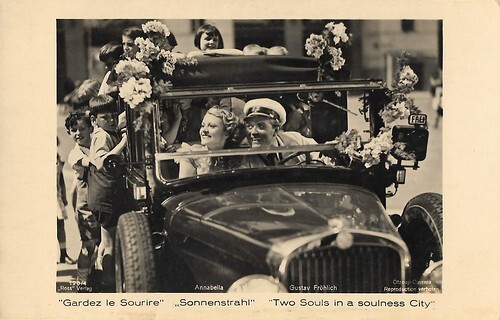
German postcard by Ross Verlag, no. 190/4. Photo: Otzoup Cinema. Annabella and Gustav Fröhlich in the Austrian film Sonnenstrahl/Gardez le sourire/Two Souls in a Soulless City (Pål Fejös, 1933).
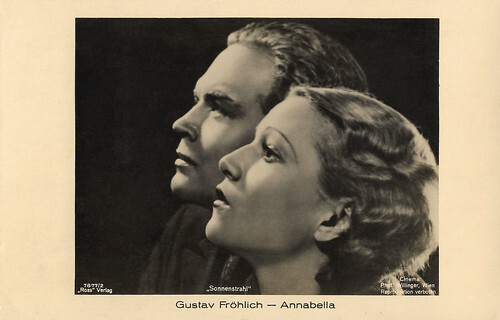
German postcard by Ross Verlag, no. 7877/2, 1932-1933. Photo: Cinema / Willinger, Wien. Gustav Fröhlich and Annabella in Sonnenstrahl/Two Souls in a Soulless City (Paul Fejos, 1933).
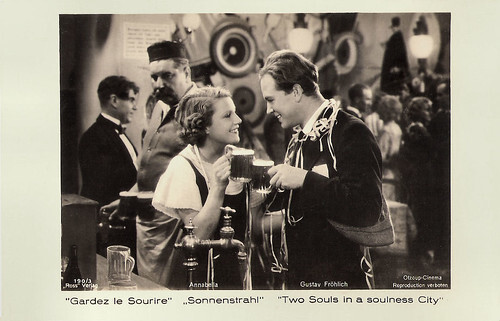
German postcard by Ross Verlag, no. 190/3. Photo: Otzoup Cinema. Annabella and Gustav Fröhlich in the Austrian film Sonnenstrahl/Gardez le sourire/Two Souls in a Soulless City (Pål Fejös, 1933).
Rescued from the Danube
Vienna, at the height of the Great Depression. Like so many others, Hans Schmidt ( Gustav Fröhlich ) has no work, no money, and nowhere to live. Having lost his job as a taxi driver, he decides that the only solution is to kill himself. But just as he is about to drown himself in the Donau (Danube), he sees a young woman dive into the river, obviously with the same intention. Without a thought, Hans pulls the woman out of the water and does his best to comfort her.
Her name is Anna ( Annabella ) and she is only 18, but like Hans, she no longer has the strength to go on living. A little later, Hans and Anna think that together they can better cope with the misery and decide to master everyday life with all its shortcomings and worries. Hans receives money from the police for his rescue, which is immediately invested in the purchase of soap, which is sold on the street in small pieces for a profit.
Other small odd jobs - he makes himself available as a living target in a Prater booth and serves as an advertising sandwich man, she sells balloons and regularly has her head lathered to advertise a shampoo in the shop window - provide the couple with a modest financial cushion and thus the first ray of sunshine in both of their lives, which are marked by deprivation.
But there are also setbacks; for example, when a deposit of 200 shillings is paid for a prospective caretaker's job and the person taking the deposit turns out to be a crook. But Hans is no longer prepared to give up. He gets himself and Anna back on their feet and works as a bank messenger. Finally, the couple takes out a loan to buy a car, which will enable Hans to earn money as a taxi driver again in the future.
But a serious accident, which condemns Hans to inability to work for weeks, seems to set both their economic fortunes back again. Anna alone cannot pay off the loan instalments on the taxi, but in this emergency situation, the flatmates in the tenement prove to be in solidarity and help the couple with their nest eggs so that the vehicle can be paid off. Released from the hospital, Hans can finally earn money with his own taxi.
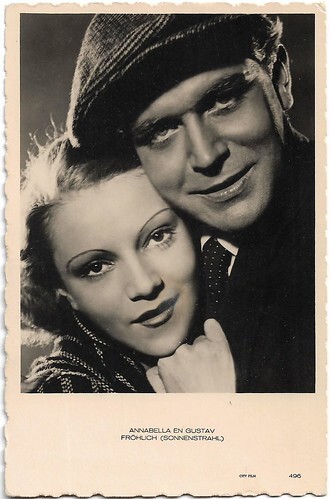
Dutch postcard by City Film, no. 496. Annabella and Gustav Fröhlich in Sonnenstrahl/Two Souls in a Soulless City (Pál Fejös, 1933). In the Netherlands, the film probably premiered in December 1933 at the Rotterdam-based art house Studio '32, part of the Tuschinski cinema chain.
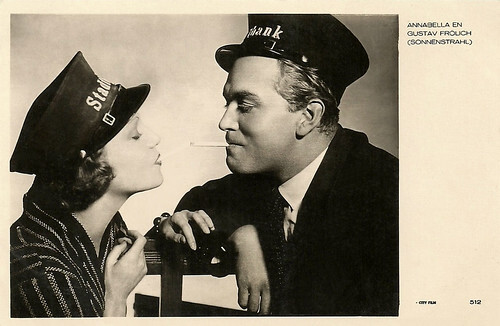
Dutch postcard by City Film, no. 512. Annabella and Gustav Fröhlich in the Austrian film Sonnenstrahl/Ray of Sunlight (Pål Fejös, 1933).
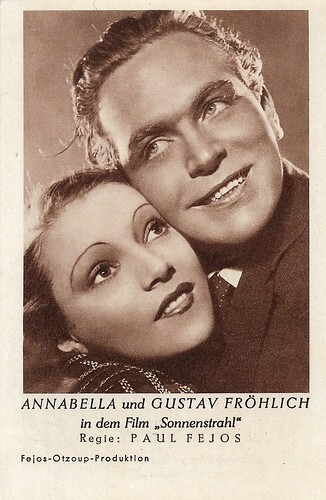
German postcard. Publicity card for the film Sonnenstrahl at the Ufa-Theater, Turmstrasse, where the was shown from Friday 22 September (1933). Photo: Serge Otzoup-Filmproduktion / Tobis / Sascha. Annabella and Gustav Fröhlich in the German-Austrian film Sonnenstrahl/Two Souls in a Soulless City (Paul Fejos / Pál Fejös, 1933).
Characters that are as fragile as they are tough and resourceful
The Austrian-French film Sonnenstrahl/Gardez le sourire/Ray of Sunlight a.k.a. Two Souls in a Soulness City (1933) is a typical example of the work of the Hungarian-born filmmaker Pál Fejös (1897-1963). During the 1920s and 1930s, he was well-regarded internationally for his distinctive, humanist films. After World War I, he started to direct films for Mobil Studios in Hungary until he escaped in 1923 to flee the White Terror and the Horthy regime.
He moved to Hollywood where he made such films as The Last Moment (1928) with Georgia Hale, Lonesome (1928), The Last Performance (1929) with Conrad Veidt , and Broadway (1929) with Evelyn Brent . Fejös returned to Europe in 1931. In France, he directed the remak Fantômas/Fantomas (1932) starring Jean Galland. From the mid-1930s on he started to make documentaries. In 1941 he stopped making films altogether and became the Director of Research and the acting head of the Viking Fund.
Sonnenstrahl was made in Austria in two alternate language versions with the same leads. The French version, Gardez le sourire (1933), was co-directed with René Sti. With the exception of the two main actors, all the actors were different (= French) than in the Austrian original. The film was made in the Sascha film studio in Vienna-Sievering. Previously, Annabella had played a lead role in Fejös's film Prima dragoste/Marie, légende hongroise/First Love (Pál Fejös, Jean Mihail, 1933).
James Travers at French Films : " Annabella and Fröhlich both have a rare aptitude for playing characters that are as fragile as they are tough and resourceful, and so they are suitably paired in a film that plays on these qualities." Sonnnenstrahl/Ray of Sunlight (1933) premiered in Berlin's Gloria-Palast on 23 August 1933. In Vienna, the film was released on 15 December 1933.
"Writer-Director Paul Fejos (Pál Fejös) offers us a charming view of Vienna from the underside, with leads Annabella and Gustav Fröhlich most charming", writes Bob Lipton at IMDb : "The ups and downs go on a little too often. I would have cut it one iteration short, but he directs it as a silent with enough sound sequences to let you know this is the sound era. The leads mime their performances very nicely. Annabella is almost mute (perhaps her German was not so good) in her shy, mousy role and Fröhlich's performance suggests Bill Haines in one of his more down-to-earth roles. Anyone who has seen Fejos' Lonesome will recognize this as another film in the same vein, a corrective to King Vidor's The Crowd (1928). Between the players and the city of Vienna, this is a good one to see."

German postcard by Ross Verlag, no. 190/2. Photo: Otzoup Cinema. Annabella and Gustav Fröhlich in Sonnenstrahl/Two Souls in a Soulness City (Pål Fejös, 1933).
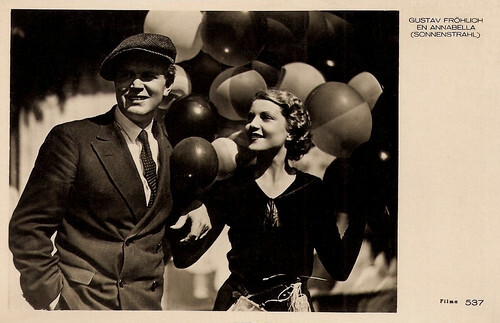
Dutch postcard by Filma, no. 537. Gustav Fröhlich and Annabella in Sonnenstrahl (Paul Fejos, 1933).
Sources: Bob Lipton (IMDb), James Travers (French Films), Wikipedia (German and English), and IMDb.

German postcard by Ross Verlag, no. 190/4. Photo: Otzoup Cinema. Annabella and Gustav Fröhlich in the Austrian film Sonnenstrahl/Gardez le sourire/Two Souls in a Soulless City (Pål Fejös, 1933).

German postcard by Ross Verlag, no. 7877/2, 1932-1933. Photo: Cinema / Willinger, Wien. Gustav Fröhlich and Annabella in Sonnenstrahl/Two Souls in a Soulless City (Paul Fejos, 1933).

German postcard by Ross Verlag, no. 190/3. Photo: Otzoup Cinema. Annabella and Gustav Fröhlich in the Austrian film Sonnenstrahl/Gardez le sourire/Two Souls in a Soulless City (Pål Fejös, 1933).
Rescued from the Danube
Vienna, at the height of the Great Depression. Like so many others, Hans Schmidt ( Gustav Fröhlich ) has no work, no money, and nowhere to live. Having lost his job as a taxi driver, he decides that the only solution is to kill himself. But just as he is about to drown himself in the Donau (Danube), he sees a young woman dive into the river, obviously with the same intention. Without a thought, Hans pulls the woman out of the water and does his best to comfort her.
Her name is Anna ( Annabella ) and she is only 18, but like Hans, she no longer has the strength to go on living. A little later, Hans and Anna think that together they can better cope with the misery and decide to master everyday life with all its shortcomings and worries. Hans receives money from the police for his rescue, which is immediately invested in the purchase of soap, which is sold on the street in small pieces for a profit.
Other small odd jobs - he makes himself available as a living target in a Prater booth and serves as an advertising sandwich man, she sells balloons and regularly has her head lathered to advertise a shampoo in the shop window - provide the couple with a modest financial cushion and thus the first ray of sunshine in both of their lives, which are marked by deprivation.
But there are also setbacks; for example, when a deposit of 200 shillings is paid for a prospective caretaker's job and the person taking the deposit turns out to be a crook. But Hans is no longer prepared to give up. He gets himself and Anna back on their feet and works as a bank messenger. Finally, the couple takes out a loan to buy a car, which will enable Hans to earn money as a taxi driver again in the future.
But a serious accident, which condemns Hans to inability to work for weeks, seems to set both their economic fortunes back again. Anna alone cannot pay off the loan instalments on the taxi, but in this emergency situation, the flatmates in the tenement prove to be in solidarity and help the couple with their nest eggs so that the vehicle can be paid off. Released from the hospital, Hans can finally earn money with his own taxi.

Dutch postcard by City Film, no. 496. Annabella and Gustav Fröhlich in Sonnenstrahl/Two Souls in a Soulless City (Pál Fejös, 1933). In the Netherlands, the film probably premiered in December 1933 at the Rotterdam-based art house Studio '32, part of the Tuschinski cinema chain.

Dutch postcard by City Film, no. 512. Annabella and Gustav Fröhlich in the Austrian film Sonnenstrahl/Ray of Sunlight (Pål Fejös, 1933).

German postcard. Publicity card for the film Sonnenstrahl at the Ufa-Theater, Turmstrasse, where the was shown from Friday 22 September (1933). Photo: Serge Otzoup-Filmproduktion / Tobis / Sascha. Annabella and Gustav Fröhlich in the German-Austrian film Sonnenstrahl/Two Souls in a Soulless City (Paul Fejos / Pál Fejös, 1933).
Characters that are as fragile as they are tough and resourceful
The Austrian-French film Sonnenstrahl/Gardez le sourire/Ray of Sunlight a.k.a. Two Souls in a Soulness City (1933) is a typical example of the work of the Hungarian-born filmmaker Pál Fejös (1897-1963). During the 1920s and 1930s, he was well-regarded internationally for his distinctive, humanist films. After World War I, he started to direct films for Mobil Studios in Hungary until he escaped in 1923 to flee the White Terror and the Horthy regime.
He moved to Hollywood where he made such films as The Last Moment (1928) with Georgia Hale, Lonesome (1928), The Last Performance (1929) with Conrad Veidt , and Broadway (1929) with Evelyn Brent . Fejös returned to Europe in 1931. In France, he directed the remak Fantômas/Fantomas (1932) starring Jean Galland. From the mid-1930s on he started to make documentaries. In 1941 he stopped making films altogether and became the Director of Research and the acting head of the Viking Fund.
Sonnenstrahl was made in Austria in two alternate language versions with the same leads. The French version, Gardez le sourire (1933), was co-directed with René Sti. With the exception of the two main actors, all the actors were different (= French) than in the Austrian original. The film was made in the Sascha film studio in Vienna-Sievering. Previously, Annabella had played a lead role in Fejös's film Prima dragoste/Marie, légende hongroise/First Love (Pál Fejös, Jean Mihail, 1933).
James Travers at French Films : " Annabella and Fröhlich both have a rare aptitude for playing characters that are as fragile as they are tough and resourceful, and so they are suitably paired in a film that plays on these qualities." Sonnnenstrahl/Ray of Sunlight (1933) premiered in Berlin's Gloria-Palast on 23 August 1933. In Vienna, the film was released on 15 December 1933.
"Writer-Director Paul Fejos (Pál Fejös) offers us a charming view of Vienna from the underside, with leads Annabella and Gustav Fröhlich most charming", writes Bob Lipton at IMDb : "The ups and downs go on a little too often. I would have cut it one iteration short, but he directs it as a silent with enough sound sequences to let you know this is the sound era. The leads mime their performances very nicely. Annabella is almost mute (perhaps her German was not so good) in her shy, mousy role and Fröhlich's performance suggests Bill Haines in one of his more down-to-earth roles. Anyone who has seen Fejos' Lonesome will recognize this as another film in the same vein, a corrective to King Vidor's The Crowd (1928). Between the players and the city of Vienna, this is a good one to see."

German postcard by Ross Verlag, no. 190/2. Photo: Otzoup Cinema. Annabella and Gustav Fröhlich in Sonnenstrahl/Two Souls in a Soulness City (Pål Fejös, 1933).

Dutch postcard by Filma, no. 537. Gustav Fröhlich and Annabella in Sonnenstrahl (Paul Fejos, 1933).
Sources: Bob Lipton (IMDb), James Travers (French Films), Wikipedia (German and English), and IMDb.
Published on October 16, 2022 22:00
October 15, 2022
Richard Widmark
Slight, blonde Richard Widmark (1914-2008) suddenly established himself as an icon of American cinema with his debut as a giggling psychopath in Kiss of Death (1947). He was one of the most sought-after actors in Hollywood for a good three decades and appeared in 75 films.
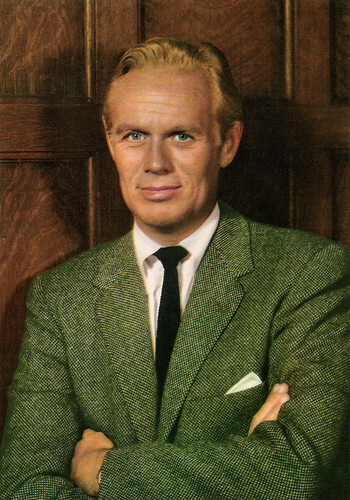
Italian postcard by Rotalcolor, Rotalfoto, no. 140.
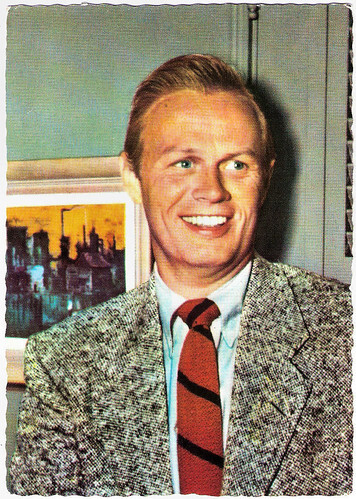
French postcard by Huit, Paris, no. B 3. Photo: ISV / 20th Century Fox. The card refers to Richard Widmark's role in The Last Wagon (Delmer Daves, 1956). Huit was probably the French licence holder of ISV.
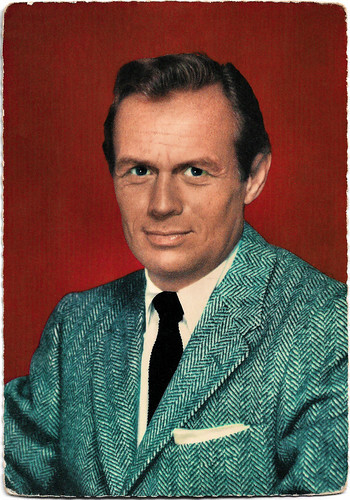
West-German postcard by ISV, no. B 25. Photo: M.G.M. Publicity still for The Tunnel of Love (Gene Kelly, 1958).
Cold-heartedly pushing an old woman in her wheelchair down the stairs
Richard Weedt Widmark was born in Sunrise County, Minnesota, in 1914. His parents were Carl Henry Widmark, a Swedish immigrant and travelling salesman, and his wife Ethel Mae Barr.
Widmark could already read before he went to school and studied law after graduation to become a lawyer. He also became enthusiastic about acting at an early age. In 1938 Widmark moved to New York with his future wife Jean Hazlewood, a screenwriter he had met as a colleague in Lake Forrest, and married her in 1942. Their only child, Anne Heath Widmark, was born in 1945.
In 1943 Widmark made his Broadway debut in George Abbott's theatrical production of 'Kiss and Tell'. Widmark worked as a radio announcer for ten years before making his film acting debut.
Widmark made his breakthrough with his debut role as Tommy Udo in the Film Noir Kiss of Death (Henry Hathaway, 1947) starring Victor Mature . Udo is a criminal who cold-heartedly pushes a paraplegic old woman in her wheelchair down a flight of stairs in the film's most famous scene. For this role, he was nominated for an Academy Award for Best Male Supporting Actor.
Widmark received a seven-year contract with 20th Century Fox. After his successful debut, Widmark was initially confined to the role of the villain for years. He brought a new kind of deeply troubled or corrupt character to the screen: a hard-boiled type who does not actively court the audience's sympathy.
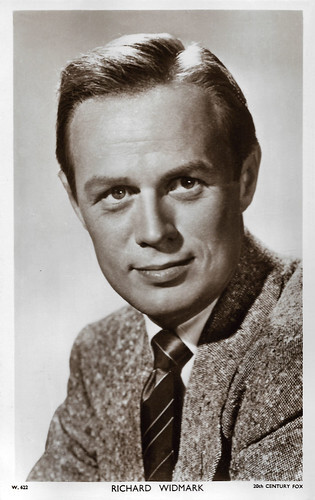
British postcard in the Picturegoer Series, London, no. W 622. Photo: 20th Century Fox.
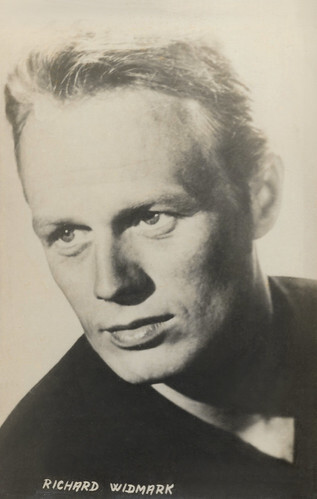
Vintage postcard.
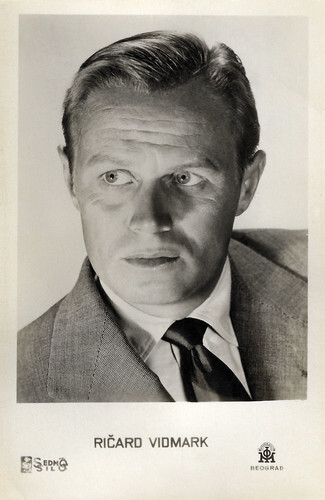
Yugoslavian postcard by Sedma Sila. Photo: IOM, Beograd.
A versatile leading man in all genres
In the 1950s, Richard Widmark managed to get away from this troubled villain type and establish himself as a versatile leading man in all genres.
Elia Kazan cast Widmark in his thriller Panic in the Streets (1950), not as the heavy but as the physician who tracks down Jack Palance , who has the plague, in tandem with detective Paul Douglas.
He went on to play notable roles as the penny-ante hustler Harry Fabian in the Film Noir Night and the City (Jules Dassin, 1950) with Gene Tierney , and an airline pilot who pursues a babysitter in his hotel ( Marilyn Monroe ) and gradually realises she's dangerous in Don't Bother to Knock (Roy Ward Baker, 1952).
Widmark appeared in two films for director Samuel Fuller: the Film Noir Pickup on South Street (1953) with Jean Peters and the Cold War drama Hell and High Water (1954) with Bella Darvi .
He later played in the Western The Alamo (John Wayne, 1960), the courtroom drama Judgment at Nuremberg (Stanley Kramer, 1961) starring Spencer Tracy, and the epic Western How the West Was Won (John Ford, Henry Hathaway, George Marshall, 1962).
Widmark produced and starred in the films Time Limit (Karl Malden, 1957) with Richard Basehart , The Secret Ways (1961) — based on a novel by Alistair MacLean, which Widmark also directed (uncredited) due to clashes with original director Phil Karlson's proposed tongue-in-cheek direction of the screenplay — and the Cold War thriller The Bedford Incident (James B. Harris, 1965), his third film with Sidney Poitier and loosely based on the Herman Melville novel 'Moby Dick'.
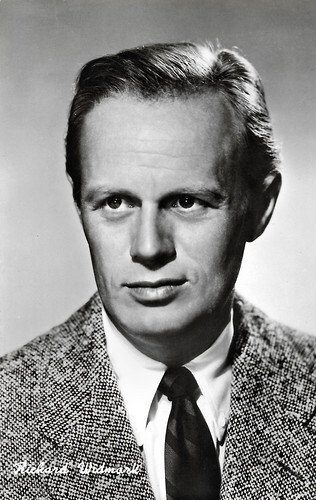
Belgian postcard by Bromophoto, Bruxelles.
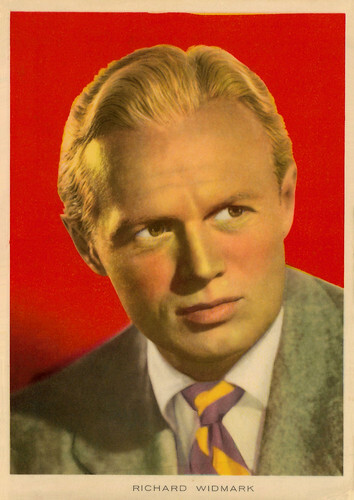
Italian postcard by Nannina, Milano.
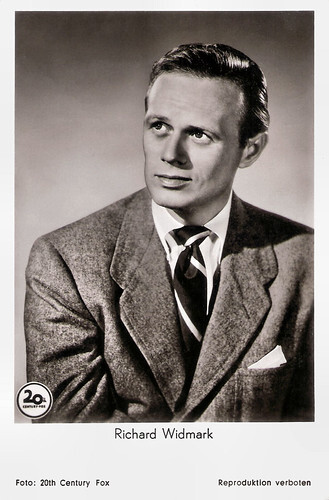
West-German postcard by Rüdel-Verlag, Hamburg-Bergedorf, no. 228. Photo: 20th Century Fox.
A sought-after character actor
During the 1970s and 1980s, Richard Widmark advanced over the years to become a sought-after character actor. However, he still played the occasional lead, for instance in the British-West German film To the Devil a Daughter (Peter Sykes, 1976) with Christopher Lee and Nastassja Kinski .
He starred in such well-known films as the Agatha Christie adaptation Murder on the Orient Express (Sidney Lumet, 1974), the disaster thriller Rollercoaster (James Goldstone, 1977), the thriller Coma (Michael Crichton, 1978) starring Genevieve Bujold and Michael Douglas , and the Neo Noir Against All Odds (Taylor Hackford, 1984) with Jeff Bridges.
Widmark continued to appear in a number of films during the 1980s, again with Sidney Poitier who directed him in the comedy Hanky Panky (1982), with Gene Wilder. In 1987 he appeared with Louis Gossett jr. in Volker Schlöndorff's film A Gathering of Old Men, based on the novel 'A Gathering of Old Men' by Ernest J. Gaines.
In 1991 Richard Widmark appeared in front of the film camera for the last time in the political thriller True Colors (Herbert Ross, 1991) starring John Cusack. His last work was a voice-over for the television film Lincoln (Peter W. Kunhardt, James A. Edgar, 1992). Widmark spent his retirement in seclusion on his farm in Connecticut.
Widmark was first married for 55 years to Jean Hazlewood from 1952 until her death in 1997. In 1999, he married Susan Blanchard, who had previously been married to Henry Fonda , and remained with her until his death. In 2008, Richard Widmark died at home in Roxbury, Connecticut, at the age of 93. His death followed a fall in 2007, which he did not recover from. He was buried at Roxbury Center Cemetery.
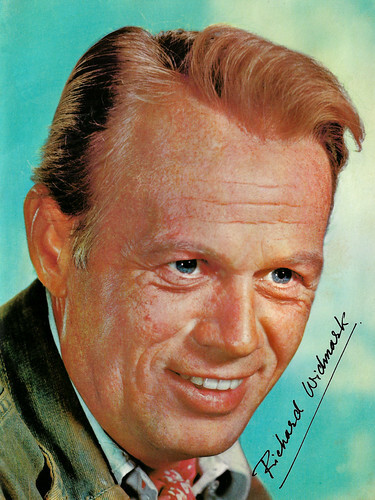
Big Dutch collectors card.
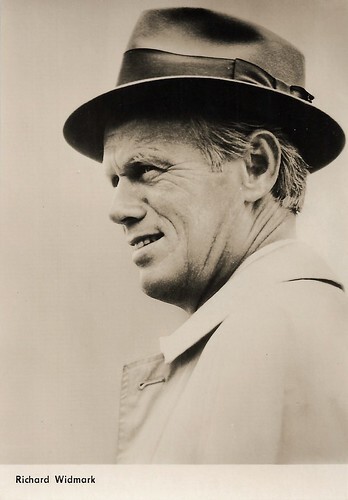
East-German postcard by VEB Progress Filmvertrieb, Berlin. no. 3097. Photo: Steffen. Richard Widmark, the postcard refers to his historical film Cheyenne Autumn (John Ford, 1964), even if here he appears in a modern outfit.
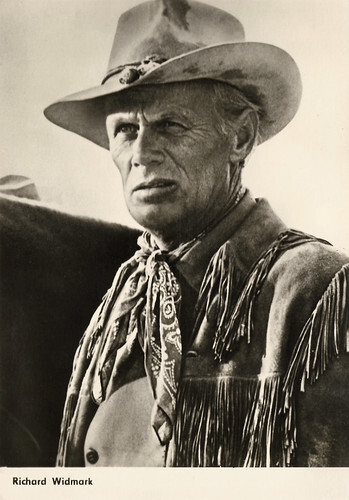
East-German postcard by VEB Progress Film-Vertrieb, Berlin, no. 3149, 1968. Richard Widmark in Cheyenne Autumn (John Ford, 1964).
Sources: (IMDb), Wikipedia (Dutch, English and German) and .

Italian postcard by Rotalcolor, Rotalfoto, no. 140.

French postcard by Huit, Paris, no. B 3. Photo: ISV / 20th Century Fox. The card refers to Richard Widmark's role in The Last Wagon (Delmer Daves, 1956). Huit was probably the French licence holder of ISV.

West-German postcard by ISV, no. B 25. Photo: M.G.M. Publicity still for The Tunnel of Love (Gene Kelly, 1958).
Cold-heartedly pushing an old woman in her wheelchair down the stairs
Richard Weedt Widmark was born in Sunrise County, Minnesota, in 1914. His parents were Carl Henry Widmark, a Swedish immigrant and travelling salesman, and his wife Ethel Mae Barr.
Widmark could already read before he went to school and studied law after graduation to become a lawyer. He also became enthusiastic about acting at an early age. In 1938 Widmark moved to New York with his future wife Jean Hazlewood, a screenwriter he had met as a colleague in Lake Forrest, and married her in 1942. Their only child, Anne Heath Widmark, was born in 1945.
In 1943 Widmark made his Broadway debut in George Abbott's theatrical production of 'Kiss and Tell'. Widmark worked as a radio announcer for ten years before making his film acting debut.
Widmark made his breakthrough with his debut role as Tommy Udo in the Film Noir Kiss of Death (Henry Hathaway, 1947) starring Victor Mature . Udo is a criminal who cold-heartedly pushes a paraplegic old woman in her wheelchair down a flight of stairs in the film's most famous scene. For this role, he was nominated for an Academy Award for Best Male Supporting Actor.
Widmark received a seven-year contract with 20th Century Fox. After his successful debut, Widmark was initially confined to the role of the villain for years. He brought a new kind of deeply troubled or corrupt character to the screen: a hard-boiled type who does not actively court the audience's sympathy.

British postcard in the Picturegoer Series, London, no. W 622. Photo: 20th Century Fox.

Vintage postcard.

Yugoslavian postcard by Sedma Sila. Photo: IOM, Beograd.
A versatile leading man in all genres
In the 1950s, Richard Widmark managed to get away from this troubled villain type and establish himself as a versatile leading man in all genres.
Elia Kazan cast Widmark in his thriller Panic in the Streets (1950), not as the heavy but as the physician who tracks down Jack Palance , who has the plague, in tandem with detective Paul Douglas.
He went on to play notable roles as the penny-ante hustler Harry Fabian in the Film Noir Night and the City (Jules Dassin, 1950) with Gene Tierney , and an airline pilot who pursues a babysitter in his hotel ( Marilyn Monroe ) and gradually realises she's dangerous in Don't Bother to Knock (Roy Ward Baker, 1952).
Widmark appeared in two films for director Samuel Fuller: the Film Noir Pickup on South Street (1953) with Jean Peters and the Cold War drama Hell and High Water (1954) with Bella Darvi .
He later played in the Western The Alamo (John Wayne, 1960), the courtroom drama Judgment at Nuremberg (Stanley Kramer, 1961) starring Spencer Tracy, and the epic Western How the West Was Won (John Ford, Henry Hathaway, George Marshall, 1962).
Widmark produced and starred in the films Time Limit (Karl Malden, 1957) with Richard Basehart , The Secret Ways (1961) — based on a novel by Alistair MacLean, which Widmark also directed (uncredited) due to clashes with original director Phil Karlson's proposed tongue-in-cheek direction of the screenplay — and the Cold War thriller The Bedford Incident (James B. Harris, 1965), his third film with Sidney Poitier and loosely based on the Herman Melville novel 'Moby Dick'.

Belgian postcard by Bromophoto, Bruxelles.

Italian postcard by Nannina, Milano.

West-German postcard by Rüdel-Verlag, Hamburg-Bergedorf, no. 228. Photo: 20th Century Fox.
A sought-after character actor
During the 1970s and 1980s, Richard Widmark advanced over the years to become a sought-after character actor. However, he still played the occasional lead, for instance in the British-West German film To the Devil a Daughter (Peter Sykes, 1976) with Christopher Lee and Nastassja Kinski .
He starred in such well-known films as the Agatha Christie adaptation Murder on the Orient Express (Sidney Lumet, 1974), the disaster thriller Rollercoaster (James Goldstone, 1977), the thriller Coma (Michael Crichton, 1978) starring Genevieve Bujold and Michael Douglas , and the Neo Noir Against All Odds (Taylor Hackford, 1984) with Jeff Bridges.
Widmark continued to appear in a number of films during the 1980s, again with Sidney Poitier who directed him in the comedy Hanky Panky (1982), with Gene Wilder. In 1987 he appeared with Louis Gossett jr. in Volker Schlöndorff's film A Gathering of Old Men, based on the novel 'A Gathering of Old Men' by Ernest J. Gaines.
In 1991 Richard Widmark appeared in front of the film camera for the last time in the political thriller True Colors (Herbert Ross, 1991) starring John Cusack. His last work was a voice-over for the television film Lincoln (Peter W. Kunhardt, James A. Edgar, 1992). Widmark spent his retirement in seclusion on his farm in Connecticut.
Widmark was first married for 55 years to Jean Hazlewood from 1952 until her death in 1997. In 1999, he married Susan Blanchard, who had previously been married to Henry Fonda , and remained with her until his death. In 2008, Richard Widmark died at home in Roxbury, Connecticut, at the age of 93. His death followed a fall in 2007, which he did not recover from. He was buried at Roxbury Center Cemetery.

Big Dutch collectors card.

East-German postcard by VEB Progress Filmvertrieb, Berlin. no. 3097. Photo: Steffen. Richard Widmark, the postcard refers to his historical film Cheyenne Autumn (John Ford, 1964), even if here he appears in a modern outfit.

East-German postcard by VEB Progress Film-Vertrieb, Berlin, no. 3149, 1968. Richard Widmark in Cheyenne Autumn (John Ford, 1964).
Sources: (IMDb), Wikipedia (Dutch, English and German) and .
Published on October 15, 2022 22:00
October 14, 2022
Ralf Wolter (1926-2022)
Yesterday, 14 October 2022, Ralf Wolter (1926) passed away. He was the 'King of the Supporting Parts' in countless German comedies, musicals, and Euro-Westerns. Unforgettable is his performance as Sam Hawkens, the loyal companion of Winnetou and Old Shatterhand in the classic Karl May Westerns of the 1960s. Wolter died in Munich, Germany at the age of 95.

German postcard by Rüdel-Verlag, Hamburg. Photo: Constantin. Publicity still for Heintje - Ein Herz geht auf Reisen/Heintje: A Heart Goes on a Journey (Werner Jacobs, 1969).
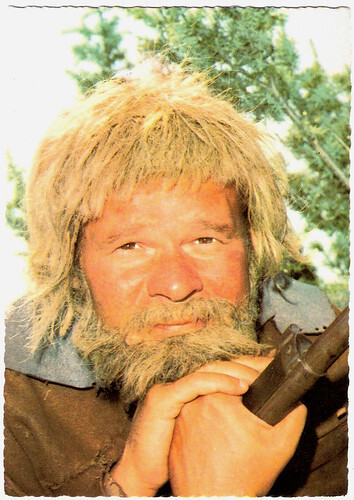
German postcard, no. 20. Photo: Rialto / Constantin. Still for Winnetou - 3. Teil/Desperado Trail (Harald Reinl, 1965).
Goofy Butler
Ralf Wolter was born in 1926 in Berlin as the son of a comedian, acrobat, and singer. He studied acting at Der Kreis (Fritz-Kirchhoff-Schule) in his hometown, where he also started his career in several Berlin theatres such as the cabaret Schall und Rauch.
Between 1954 and 1958 he was a member of the cabaret Auchfang. He made his first film appearance in 1951 in the satirical comedy Die Frauen des Herrn S./The Women of Mr. S. (Paul Martin, 1951) with Sonja Ziemann and Paul Hörbiger .
Soon he got more film offers to show his comical talent in countless comedies and musicals. With his inimitable style, he became a darling of the public as the goofy butler, odd fellow, or likeable bandit, such as in Das Wirtshaus im Spessart/The Spessart Inn (Kurt Hoffmann, 1958) with Liselotte Pulver .
He appeared in the complete range of funny and indispensable supporting parts, including the policeman, the jockey or the civil servant in light entertainment films like Die Beine von Dolores/The Legs of Dolores (Géza von Cziffra, 1957), Wenn die Conny mit dem Peter/When Conny and Peter Do It Together (Fritz Umgelter, 1958), and Freddy, die Gitarre und das Meer/Freddy, the Guitar and the Sea (Wolfgang Schleif, 1959).
His funniest part was a bathroom waiter in Wir Wunderkinder/Aren't We Wonderful? (Kurt Hoffmann, 1958) starring Hansjörg Felmy . In 1961 he appeared as a bald soviet agent in the Hollywood comedy One, Two, Three (Billy Wilder, 1961) starring James Cagney and Horst Buchholz .

German postcard, no. E 4. Photo: Constantin. Lex Barker as Old Shatterhand and Ralf Wolter as Sam Hawkens in Winnetou - 1. Teil/Apache Gold (Harald Reinl, 1963). Caption: Old Shatterhand comes from the east as the companion of a trek and brings supplies of weapons and food to the Great Western Railroad.
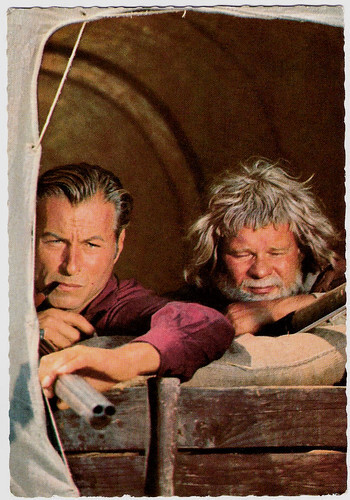
German postcard, no. E 5. Photo: Constantin. Still from Winnetou I (Harald Reinl, 1963) with Ralf Wolter and Lex Barker as Old Shatterhand.
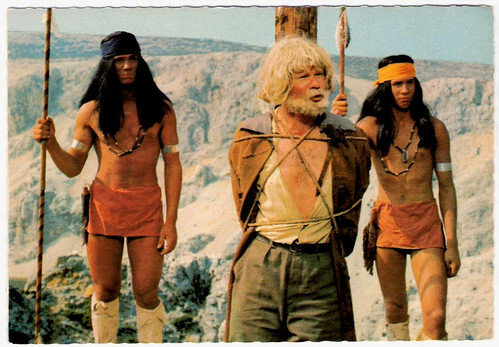
German postcard, E 22. Photo: Constantin. Still from Winnetou I (Harald Reinl, 1963) with Ralf Wolter. Caption: The conquering Apaches decide in the powwow to kill the white prisoners. The cranky Sam Hawkens just can't understand, why this is the way he has to go to the happy hunting ground.
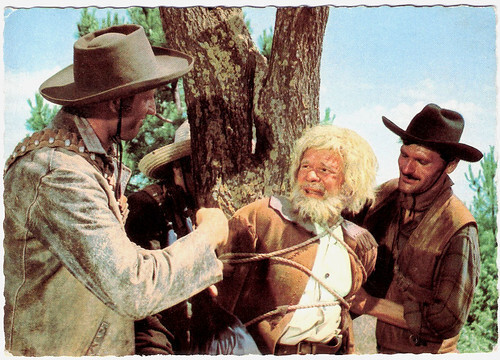
German postcard, no. 8. Photo: Rialto / Constantin. Still for Winnetou - 3. Teil/Desperado Trail (Harald Reinl, 1965) with Ralf Wolter.
Trapper Sam Hawkens
Unforgettable is his role as trapper Sam Hawkens, the loyal and sympathetic companion of the heroes in the Karl May films of the 1960s. The first time Ralf Wolter appeared as this tattered type was in Der Schatz im Silbersee/Treasure of Silver Lake (Harald Reinl, 1962). It would be his breakthrough.
Soon followed Winnetou I/Apache Gold (Harald Reinl, 1963), Old Shatterhand/Shatterhand (Hugo Fregonese, 1963), Winnetou - 3. Teil/The Desperado Trail (Harald Reinl, 1965), Winnetou und das Halbblut Apanatschi/Half-Breed (Harald Philipp, 1966), and Winnetou und Shatterhand im Tal der Toten/Winnetou and Shatterhand in the Valley of Death (Harald Reinl, 1968).
When producer Artur Brauner needed a Hadschi Halef Omar for his film Der Schut/The Shoot (Robert Siodmak, 1964), it was out of the question who should play the always yapping, a bit simple companion of Kara Ben Nemsi ( Lex Barker ). Wolter continued to yap– and unnerve his master - in the sequels Durchs wilde Kurdistan/Wild Kurdistan (Franz Josef Gottlieb, 1965) and Im Reich des silbernen Löwen/Attack of the Kurds (Franz Josef Gottlieb, 1965).
In the in Mexico situated two-parter Der Schatz der Azteken/The Treasure of the Aztecs (Robert Siodmak, 1965) and Die Pyramide des Sonnengottes/Pyramid of the Sun God (Robert Siodmak, 1965) he played the cuckoo clock seller Andreas Hasenpfeffer next to Lex Barker . In 1966 he appeared again with Barker in the Western Wer kennt Jonny R.?/Who Killed Johnny R.? (José Luis Madrid, 1966).
He continued appearing in films during the 1970s, but without the success that he was used to with his Karl May films. He played parts in the family films with the Dutch child star Heintje Simons including Heintje - Ein Herz geht auf Reisen/Heintje: A Heart Goes on a Journey (Werner Jacobs, 1969). He also could be seen in the soft-sex films such asUrlaubsreport - Worüber Reiseleiter nicht sprechen dürfen/Holidays Report (Ernst Hofbauer, 1971) starring Sybil Danning. Also his five vehicles for Schlager singer Roy Black including Kinderarzt Dr. Fröhlich/Children’s Doctor Fröhlich (Kurt Nachmann, 1972), were banal and sometimes even too painful to watch.
An exception was his leading role in the excellent comedy Was ist denn bloss mit Willi los?/What Is the Matter with Willi? (Werner Jacobs, 1970), in which he and Heinz Erhardt played two tax collectors. But more and more the thoroughbred comedian moved over to television. He appeared in TV series like Ein Fall für Titus Bunge/A Case for Titus Bunge (1967), the Krimis Tatort (1975), and Der Alte/The Old Fox (1977-1978).
He returned as Sam Hawkens in the 14-part TV series Winnetou le mescalero/My Friend Winnetou (Marcel Camus, 1980). In 1991 he appeared for the last time as Sam Hawkens together with Pierre Brice at the Karl-May-Festspiele in Bad Segeberg. Ralf Wolter made his last film appearance as Professor Boris Smirnoff in Kondom des Grauens/Killer Condom (Martin Walz, 1996), based on the comic of Ralf König.
In 2003 the then 75-year-old actor caused a serious car accident, which killed three people, for which he had to go on probation for ten months. Nowadays Wolter mainly works in the theatre. In 2008 he appeared as the old Harry Frommermann (the founder of the singing group Comedian Harmonists) in the play 'Jetzt oder nie – Die Comedian Harmonists/Now or Never – The Comedian Harmonists'.
Then, he appeared in two films again. In 2009 he was one of the title figures in the crime comedy Dinosaurier/Dinosaurs (Leander Haußmann, 2009) with Eva Maria Hagen and Walter Giller , and in the comedy Bis zum Horizont, dann links!/To the horizon, then left! (Bernd Böhlich, 2012) with Robert Stadlober. Wolter died in 2022, at the age of 95.

German postcard by Heinerle Karl-May-Postkarten, no. 7. Photo: CCC / Gloria. Publicity still for Der Schut/The Yellow One (Robert Siodmak, 1964). Caption: Keine Angst, guter Mann. Wir sind Freunde von Dir. Mein Sihdi, der berühmte Kara ben Nemsi und ich werden alles tun, um diesen Schurken, den Schut, zu fangen. (Do not worry, my good man. We are friends of yours. My Sidi, the famous Kara ben Nemsi and I will do everything possible to catch these rogues, the Schut.)
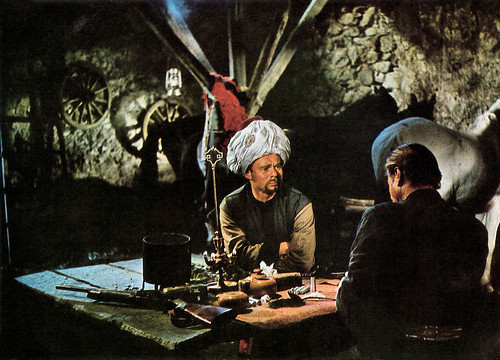
German postcard by Heinerle Karl-May-Postkarten, no. 15. Photo: CCC / Gloria. Lex Barker and Ralf Wolter in Der Schut/The Yellow One (Robert Siodmak, 1964). Caption: Am Abend im Hause Galingré: 'Halef, ich werde dem Mübarek einen Streich spielen. Deshalb musstest du mir Wismut und Quecksilber besorgen. Daraus mache ich Kugeln, die genau aussehen wie Bleikugeln, aber beim Schiessen zerfallen. Nun lade ich das Gewehr immer abwechselnd mit einer Kugel aus Blei und mit einer falschen...'' (In the evening at home Galingré: "Halef, I will play a trick on the Mübarek. Therefore, you had to get me bismuth and mercury. From this I''ll make bullets that look like lead bullets, but disintegrate during firing. Now I'll load the gun alternately with a bullet made of lead and a fake one ...").
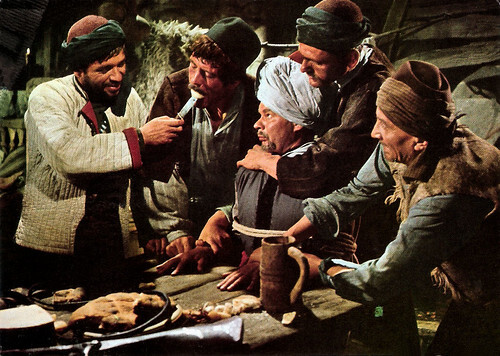
German postcard by Heinerle Karl-May-Postkarten, no. 39. Photo: CCC / Gloria. Ralf Wolter in Der Schut/The Yellow One (Robert Siodmak, 1964). Caption: Man hat Halef in die Schluchthütte gerissen und ihn dort gefesselt. 'Wo halt sich Kara auf? Rede... oder!' - Aber Halef schweigt und widersteht alle Drohungen und Schlägen. (They have pulled Halef into the canyon lodge and tied him up there. 'Where is Kara holding on? Speak... or! '- But Halef remains silent and resists all threats and beatings.)

German postcard by Heinerle Karl-May-Postkarten, no. 48. Photo: CCC / Gloria. Lex Barker and Ralf Wolter in Der Schut/The Yellow One (Robert Siodmak, 1964). Caption: Die Abschiedsstunde schlägt. Kara will in seine Heimat zurückkehren. Traurig sagt Halef seinem beliebten Herrn 'Good-bye'. 'Sihdi, wir werden uns wiedersehen, wenn der Sohn von Rih das Licht der Welt erblickt hat!' (The Farewell Bell Tolls. Kara wants to return to his homeland. Sad Halef says his beloved Lord "Good-bye". "Sidi, we 'll meet again, when the son of Rih has seen the light of day !")
Sources: Stephanie D'heil (Steffi-line.de), Christoph Stätzler (Lex Barker.net), Wikipedia (German), and .

German postcard by Rüdel-Verlag, Hamburg. Photo: Constantin. Publicity still for Heintje - Ein Herz geht auf Reisen/Heintje: A Heart Goes on a Journey (Werner Jacobs, 1969).

German postcard, no. 20. Photo: Rialto / Constantin. Still for Winnetou - 3. Teil/Desperado Trail (Harald Reinl, 1965).
Goofy Butler
Ralf Wolter was born in 1926 in Berlin as the son of a comedian, acrobat, and singer. He studied acting at Der Kreis (Fritz-Kirchhoff-Schule) in his hometown, where he also started his career in several Berlin theatres such as the cabaret Schall und Rauch.
Between 1954 and 1958 he was a member of the cabaret Auchfang. He made his first film appearance in 1951 in the satirical comedy Die Frauen des Herrn S./The Women of Mr. S. (Paul Martin, 1951) with Sonja Ziemann and Paul Hörbiger .
Soon he got more film offers to show his comical talent in countless comedies and musicals. With his inimitable style, he became a darling of the public as the goofy butler, odd fellow, or likeable bandit, such as in Das Wirtshaus im Spessart/The Spessart Inn (Kurt Hoffmann, 1958) with Liselotte Pulver .
He appeared in the complete range of funny and indispensable supporting parts, including the policeman, the jockey or the civil servant in light entertainment films like Die Beine von Dolores/The Legs of Dolores (Géza von Cziffra, 1957), Wenn die Conny mit dem Peter/When Conny and Peter Do It Together (Fritz Umgelter, 1958), and Freddy, die Gitarre und das Meer/Freddy, the Guitar and the Sea (Wolfgang Schleif, 1959).
His funniest part was a bathroom waiter in Wir Wunderkinder/Aren't We Wonderful? (Kurt Hoffmann, 1958) starring Hansjörg Felmy . In 1961 he appeared as a bald soviet agent in the Hollywood comedy One, Two, Three (Billy Wilder, 1961) starring James Cagney and Horst Buchholz .

German postcard, no. E 4. Photo: Constantin. Lex Barker as Old Shatterhand and Ralf Wolter as Sam Hawkens in Winnetou - 1. Teil/Apache Gold (Harald Reinl, 1963). Caption: Old Shatterhand comes from the east as the companion of a trek and brings supplies of weapons and food to the Great Western Railroad.

German postcard, no. E 5. Photo: Constantin. Still from Winnetou I (Harald Reinl, 1963) with Ralf Wolter and Lex Barker as Old Shatterhand.

German postcard, E 22. Photo: Constantin. Still from Winnetou I (Harald Reinl, 1963) with Ralf Wolter. Caption: The conquering Apaches decide in the powwow to kill the white prisoners. The cranky Sam Hawkens just can't understand, why this is the way he has to go to the happy hunting ground.

German postcard, no. 8. Photo: Rialto / Constantin. Still for Winnetou - 3. Teil/Desperado Trail (Harald Reinl, 1965) with Ralf Wolter.
Trapper Sam Hawkens
Unforgettable is his role as trapper Sam Hawkens, the loyal and sympathetic companion of the heroes in the Karl May films of the 1960s. The first time Ralf Wolter appeared as this tattered type was in Der Schatz im Silbersee/Treasure of Silver Lake (Harald Reinl, 1962). It would be his breakthrough.
Soon followed Winnetou I/Apache Gold (Harald Reinl, 1963), Old Shatterhand/Shatterhand (Hugo Fregonese, 1963), Winnetou - 3. Teil/The Desperado Trail (Harald Reinl, 1965), Winnetou und das Halbblut Apanatschi/Half-Breed (Harald Philipp, 1966), and Winnetou und Shatterhand im Tal der Toten/Winnetou and Shatterhand in the Valley of Death (Harald Reinl, 1968).
When producer Artur Brauner needed a Hadschi Halef Omar for his film Der Schut/The Shoot (Robert Siodmak, 1964), it was out of the question who should play the always yapping, a bit simple companion of Kara Ben Nemsi ( Lex Barker ). Wolter continued to yap– and unnerve his master - in the sequels Durchs wilde Kurdistan/Wild Kurdistan (Franz Josef Gottlieb, 1965) and Im Reich des silbernen Löwen/Attack of the Kurds (Franz Josef Gottlieb, 1965).
In the in Mexico situated two-parter Der Schatz der Azteken/The Treasure of the Aztecs (Robert Siodmak, 1965) and Die Pyramide des Sonnengottes/Pyramid of the Sun God (Robert Siodmak, 1965) he played the cuckoo clock seller Andreas Hasenpfeffer next to Lex Barker . In 1966 he appeared again with Barker in the Western Wer kennt Jonny R.?/Who Killed Johnny R.? (José Luis Madrid, 1966).
He continued appearing in films during the 1970s, but without the success that he was used to with his Karl May films. He played parts in the family films with the Dutch child star Heintje Simons including Heintje - Ein Herz geht auf Reisen/Heintje: A Heart Goes on a Journey (Werner Jacobs, 1969). He also could be seen in the soft-sex films such asUrlaubsreport - Worüber Reiseleiter nicht sprechen dürfen/Holidays Report (Ernst Hofbauer, 1971) starring Sybil Danning. Also his five vehicles for Schlager singer Roy Black including Kinderarzt Dr. Fröhlich/Children’s Doctor Fröhlich (Kurt Nachmann, 1972), were banal and sometimes even too painful to watch.
An exception was his leading role in the excellent comedy Was ist denn bloss mit Willi los?/What Is the Matter with Willi? (Werner Jacobs, 1970), in which he and Heinz Erhardt played two tax collectors. But more and more the thoroughbred comedian moved over to television. He appeared in TV series like Ein Fall für Titus Bunge/A Case for Titus Bunge (1967), the Krimis Tatort (1975), and Der Alte/The Old Fox (1977-1978).
He returned as Sam Hawkens in the 14-part TV series Winnetou le mescalero/My Friend Winnetou (Marcel Camus, 1980). In 1991 he appeared for the last time as Sam Hawkens together with Pierre Brice at the Karl-May-Festspiele in Bad Segeberg. Ralf Wolter made his last film appearance as Professor Boris Smirnoff in Kondom des Grauens/Killer Condom (Martin Walz, 1996), based on the comic of Ralf König.
In 2003 the then 75-year-old actor caused a serious car accident, which killed three people, for which he had to go on probation for ten months. Nowadays Wolter mainly works in the theatre. In 2008 he appeared as the old Harry Frommermann (the founder of the singing group Comedian Harmonists) in the play 'Jetzt oder nie – Die Comedian Harmonists/Now or Never – The Comedian Harmonists'.
Then, he appeared in two films again. In 2009 he was one of the title figures in the crime comedy Dinosaurier/Dinosaurs (Leander Haußmann, 2009) with Eva Maria Hagen and Walter Giller , and in the comedy Bis zum Horizont, dann links!/To the horizon, then left! (Bernd Böhlich, 2012) with Robert Stadlober. Wolter died in 2022, at the age of 95.

German postcard by Heinerle Karl-May-Postkarten, no. 7. Photo: CCC / Gloria. Publicity still for Der Schut/The Yellow One (Robert Siodmak, 1964). Caption: Keine Angst, guter Mann. Wir sind Freunde von Dir. Mein Sihdi, der berühmte Kara ben Nemsi und ich werden alles tun, um diesen Schurken, den Schut, zu fangen. (Do not worry, my good man. We are friends of yours. My Sidi, the famous Kara ben Nemsi and I will do everything possible to catch these rogues, the Schut.)

German postcard by Heinerle Karl-May-Postkarten, no. 15. Photo: CCC / Gloria. Lex Barker and Ralf Wolter in Der Schut/The Yellow One (Robert Siodmak, 1964). Caption: Am Abend im Hause Galingré: 'Halef, ich werde dem Mübarek einen Streich spielen. Deshalb musstest du mir Wismut und Quecksilber besorgen. Daraus mache ich Kugeln, die genau aussehen wie Bleikugeln, aber beim Schiessen zerfallen. Nun lade ich das Gewehr immer abwechselnd mit einer Kugel aus Blei und mit einer falschen...'' (In the evening at home Galingré: "Halef, I will play a trick on the Mübarek. Therefore, you had to get me bismuth and mercury. From this I''ll make bullets that look like lead bullets, but disintegrate during firing. Now I'll load the gun alternately with a bullet made of lead and a fake one ...").

German postcard by Heinerle Karl-May-Postkarten, no. 39. Photo: CCC / Gloria. Ralf Wolter in Der Schut/The Yellow One (Robert Siodmak, 1964). Caption: Man hat Halef in die Schluchthütte gerissen und ihn dort gefesselt. 'Wo halt sich Kara auf? Rede... oder!' - Aber Halef schweigt und widersteht alle Drohungen und Schlägen. (They have pulled Halef into the canyon lodge and tied him up there. 'Where is Kara holding on? Speak... or! '- But Halef remains silent and resists all threats and beatings.)

German postcard by Heinerle Karl-May-Postkarten, no. 48. Photo: CCC / Gloria. Lex Barker and Ralf Wolter in Der Schut/The Yellow One (Robert Siodmak, 1964). Caption: Die Abschiedsstunde schlägt. Kara will in seine Heimat zurückkehren. Traurig sagt Halef seinem beliebten Herrn 'Good-bye'. 'Sihdi, wir werden uns wiedersehen, wenn der Sohn von Rih das Licht der Welt erblickt hat!' (The Farewell Bell Tolls. Kara wants to return to his homeland. Sad Halef says his beloved Lord "Good-bye". "Sidi, we 'll meet again, when the son of Rih has seen the light of day !")
Sources: Stephanie D'heil (Steffi-line.de), Christoph Stätzler (Lex Barker.net), Wikipedia (German), and .
Published on October 14, 2022 22:00
October 13, 2022
Steve McQueen
Steve McQueen (1930-1980) was the ultra-cool Hollywood star of the 1960s and is still an icon of our popular culture. In the 1960s, he was the highest-paid actor of his generation, with an average salary of $5 million. With only 27 films, his film career was rather short.
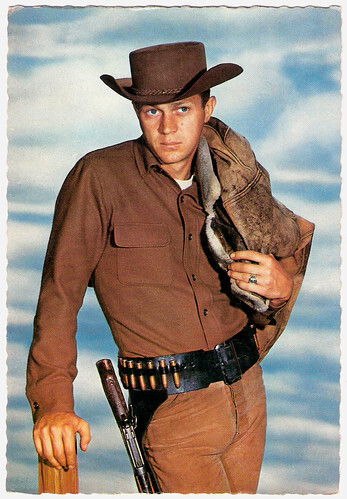
French postcard by Publistar, Marseille, no. 920. Photo: United-Press.
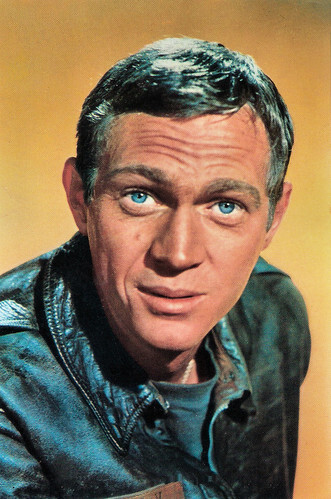
Spanish postcard by Raker, no. 1106, 1964. Steve McQueen in The Great Escape (John Sturges, 1963).
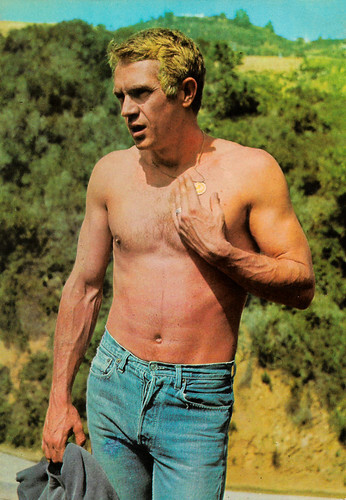
Spanish postcard by Postal Oscarcolor, no. 330.
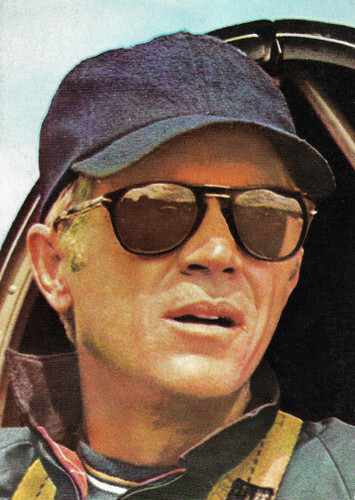
Romanian postcard by Casa Filmului Acin, no. 43080. Steve McQueen in The Thomas Crown Affair (Norman Jewison, 1968).
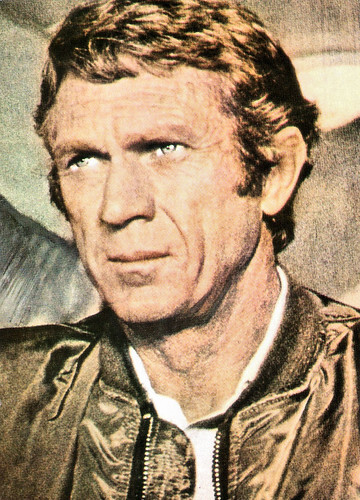
Romanian postcard by Casa Filmului Acin, no. 43079. Steve McQueen in The Hunter (Buzz Kulik, 1980).
Weekend motorcycle races at Long Island City Raceway
Terence Steve McQueen was born in Beech Grove, a suburb of Indianapolis, in 1930. His childhood was spent on his uncle's farm in Missouri, as his father left home when he was only six months old. His mother followed suit shortly afterwards.
As a teenager, he moved to Los Angeles, where he joined a gang. When he was arrested after an attempted robbery, he ended up in a reform school, the Chino Reform School. He spent a year and a half there and was set straight again. Years later, he set up a fund for that school and even left it $200,000.
In 1947, he joined the Navy, where he clashed several times with his superiors. Three years later, however, he was given an honourable discharge for heroic conduct. This was followed by a series of 12 trades and 13 accidents: construction sites, oil fields, a lumberjack in Canada and even a courier in New York.
McQueen enrolled in a few well-known acting schools and his drive earned him a scholarship from the famous Actors Studio. Long enamoured of cars and motorcycles, McQueen began to earn money by competing in weekend motorcycle races at Long Island City Raceway. He purchased the first two of many motorcycles, a Harley-Davidson and a Triumph. He soon became an excellent racer, winning about $100 each weekend (equivalent to $1,000 in 2022).
In 1955, he made his Broadway debut in the play 'A Hatful of Rain', starring Ben Gazzara . In late 1955 at the age of 25, McQueen left New York and headed for Los Angeles. He moved into a house on Vestal Avenue in the Echo Park area and sought acting jobs in Hollywood.
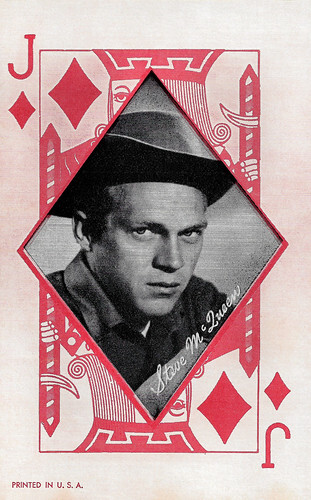
American playing (post)card. Steve McQueen in Wanted: Dead or Alive (1958-1961).
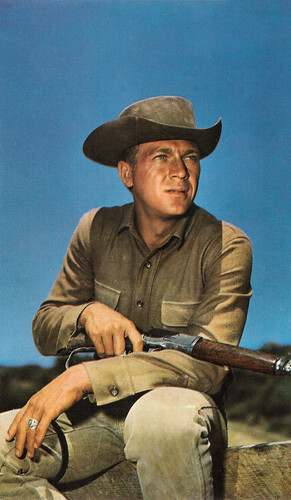
French postcard by PSG, presented by Corvisart, no. 411. Steve McQueen in Wanted: Dead or Alive (1958-1961).
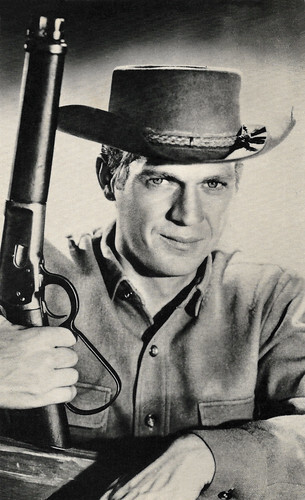
Vintage postcard. Steve McQueen in Wanted: Dead or Alive (1958-1961).
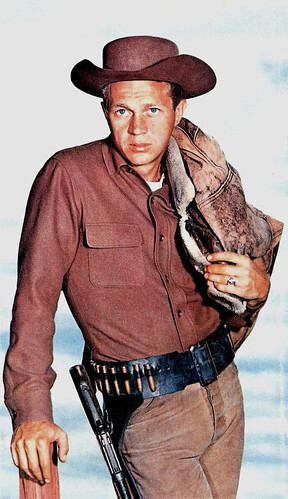
French postcard by E.D.U.G., offered by Corvisart, no. 358. Steve McQueen in Wanted: Dead or Alive (1958-1961).
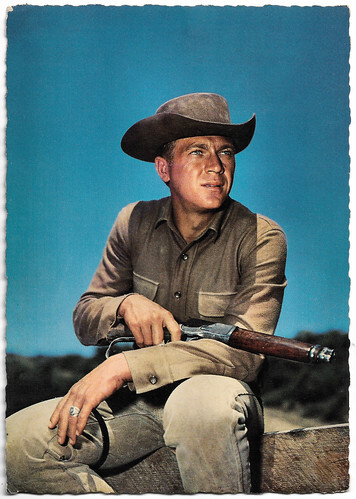
French postcard by E.D.U.G., no. 411. Steve McQueen in Wanted: Dead or Alive (1958-1961).
His breakout role
Steve McQueen's first breakout role came on television. When McQueen appeared in a two-part Westinghouse Studio One television presentation entitled The Defenders, Hollywood manager Hilly Elkins took note of him. McQueen's first film role was a bit part in Somebody Up There Likes Me (Robert Wise, 1956), starring Paul Newman .
He appeared on Dale Robertson's NBC Western series Tales of Wells Fargo as Bill Longley. McQueen next filmed a pilot episode for what became the series titled Wanted: Dead or Alive, which aired on CBS in September 1958. This became his breakout role. He would later cross over into comparable status on the big screen, making him the first TV star to do so.
His first lead role in the cinema was in the low-budget Sci-Fi film The Blob (Irvin S. Yeaworth Jr., 1958), but his breakthrough was as Vin, alongside Yul Brynner , in the Western The Magnificent Seven (John Sturges, 1960). McQueen's focused portrayal of the taciturn second lead catapulted his career and led to his withdrawal from Wanted: Dead or Alive.
Steve McQueen delivered another crowd-pleaser, the war film The Great Escape (John Sturges, 1963) with James Garner. This film established McQueen's box-office clout and secured his status as a superstar. McQueen earned his only Academy Award nomination in 1966 for his role as an engine-room sailor in The Sand Pebbles (Robert Wise, 1966), in which he starred opposite Candice Bergen and Richard Attenborough .
Riding a wave of popularity, he starred in such hits as The Cincinnati Kid (Norman Jewison, 1965) opposite Ann-Margret , the provocative crime drama The Thomas Crown Affair (Norman Jewison, 1968) with Faye Dunaway , and the mega-hit Bullitt (Peter Yates, 1968), which co-starred Jacqueline Bisset , Robert Vaughn , and Don Gordon and won an Oscar for Best Film Editing (Frank P. Keller). Bullitt is famous for its car chase scene through the streets of San Francisco, which is regarded as one of the most influential in film history.
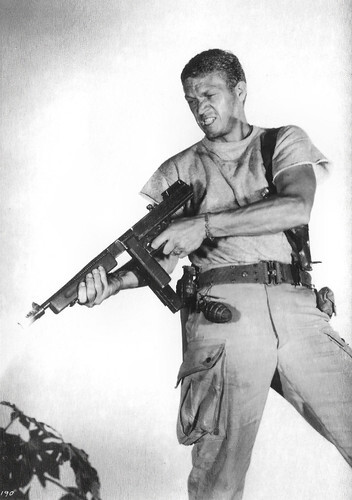
American postcard by Zoetrope Images LTD., Boston, Mass., no. 404. Steve McQueen in Hell is for Heroes (Don Siegel, 1962).
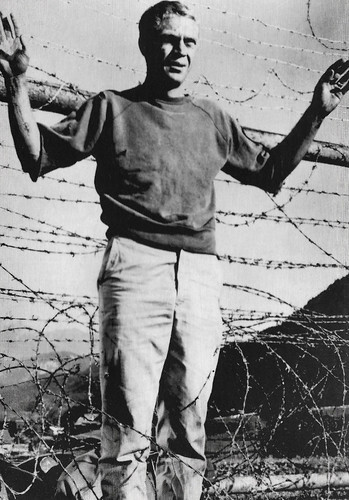
American postcard by Zoetrope Images LTD., Boston, Mass., no. 430. Steve McQueen in The Great Escape (John Sturges, 1963).
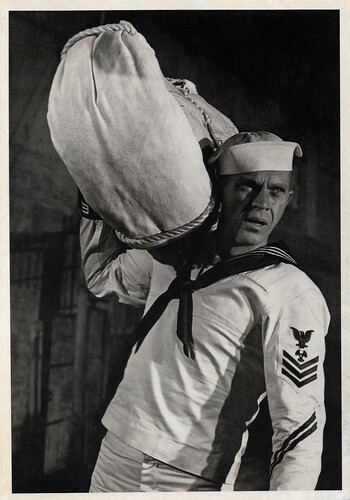
French postcard by Edition A.E.P., Ref. NB14. Steve McQueen in The Sand Pebbles (Robert Wise, 1966).
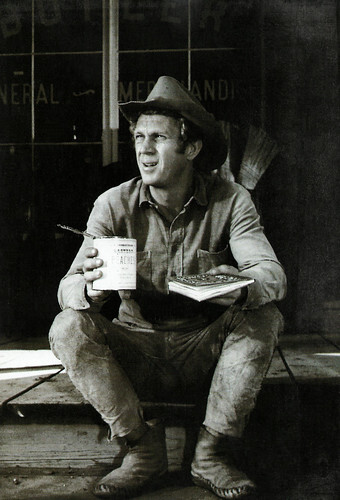
French postcard, no. C 526. Steve McQueen in Nevada Smith (Henry Hathaway, 1966).
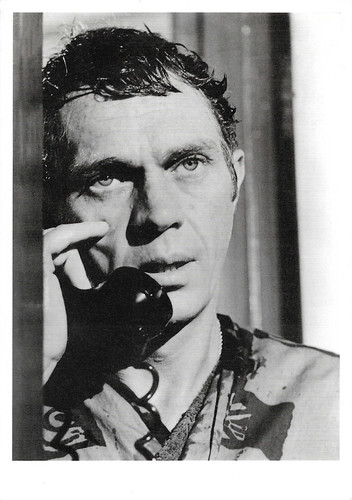
French postcard in the Collection Magie Noire by Editions Hazan, Paris, no. 6343. Steve McQueen in Bullitt (Peter Yates, 1968).
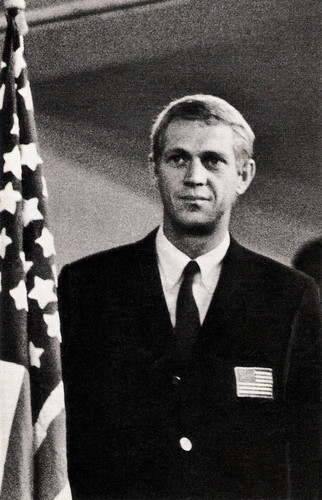
Vintage postcard.
Virile, petulant, slightly paranoid, tormented
Steve McQueen teamed up with maverick Hollywood director Sam Peckinpah for the modern Western Junior Bonner (1972), and The Getaway (1972) with Ali McGraw.
His last great hits were Papillon (Franklin J. Schaffner, 1973) with Dustin Hoffman and the 'disaster' movie The Towering Inferno (John Guillermin, Irwin Allen, 1974) with Faye Dunaway and Paul Newman.
On a personal level, Steve McQueen was as he usually was on the big screen: virile, petulant, slightly paranoid, tormented. He was obsessed with speed and regularly performed very well in national and international motor races. He was also a good marksman and a lover of oriental martial arts. He had a black belt 9th dan in Taekwondo. Together with James Coburn, he was one of the pallbearers of Bruce Lee's coffin.
His last two films were loosely based on true stories: Tom Horn (William Wiard, 1980), a Western about a former Army scout-turned-professional gunman who worked for the big cattle ranchers hunting down rustlers, and was later hanged for murder in the shooting death of a sheepherder, and The Hunter (Buzz Kulik, 1980), an action thriller about a modern-day bounty hunter.
In December 1979, he was diagnosed with lung cancer, caused by asbestos. But he kept this a secret until a month before his death. In January 1980, he suffered a heart attack shortly after marrying his third wife. At the end of 1980, he died of another heart attack in Mexico, less than a day after a successful operation to remove tumours from his right lung. Steve McQueen was only 50 years old. He was married to Neile Adams from 1956 to 1972, with whom he had two children. His second wife was Ali MacGraw from 1973 to 1978 and his last wife was Barbara Minty from 16 January 1980 until his death on 7 November of that year.
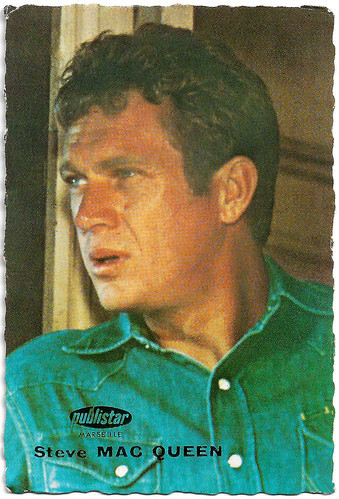
French collectors card by Publistar, Marseille. Steve McQueen in Wanted: Dead or Alive (1958-1961).
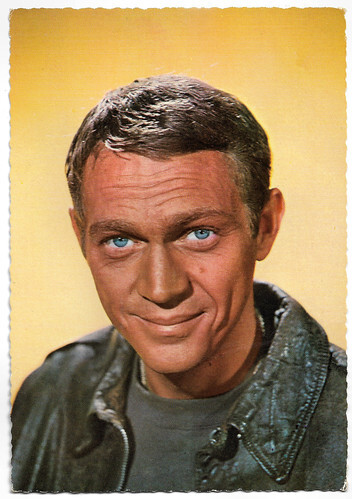
French postcard by Publistar, Marseille, no. 1008. Photo: U.P.I. Steve McQueen in The Great Escape (John Sturges, 1963).
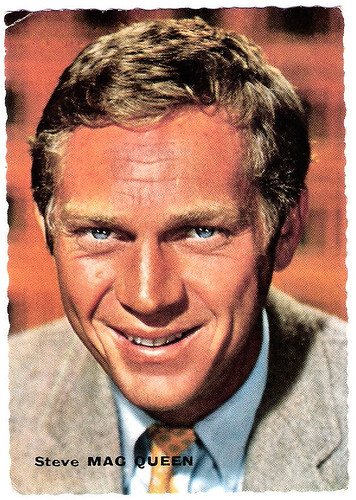
French collectors card by Scarpa, no. 407.
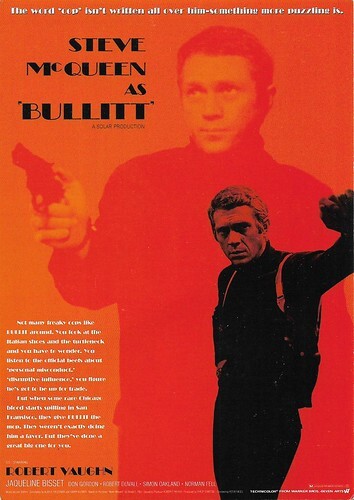
British postcard by Pyramid, no. PC 2091. Reproduction of the film poster for Bullitt (Peter Yates, 1968), starring Steve McQueen.
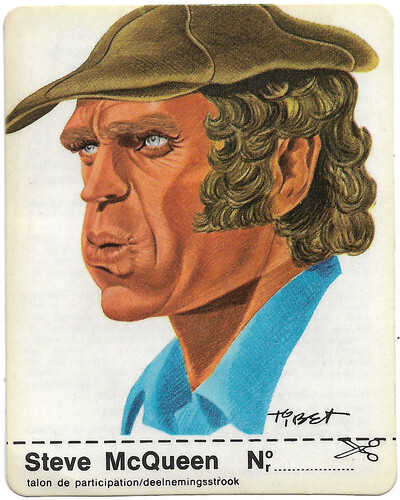
Belgian collectors card by CLARK Tendermint. Illustration: Tibet.
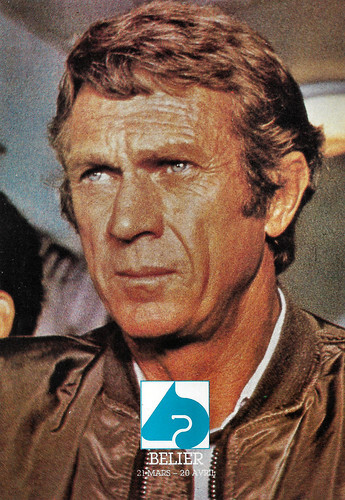
French postcard by Editions F. Nugeron in the 'Signes du zodiaque' series, no. 4, Steve McQueen, Aries (21 March - 20 April). Photo: Steve McQueen in The Hunter (Buzz Kulik, 1980).
Sources Wikipedia (Dutch and English) and .

French postcard by Publistar, Marseille, no. 920. Photo: United-Press.

Spanish postcard by Raker, no. 1106, 1964. Steve McQueen in The Great Escape (John Sturges, 1963).

Spanish postcard by Postal Oscarcolor, no. 330.

Romanian postcard by Casa Filmului Acin, no. 43080. Steve McQueen in The Thomas Crown Affair (Norman Jewison, 1968).

Romanian postcard by Casa Filmului Acin, no. 43079. Steve McQueen in The Hunter (Buzz Kulik, 1980).
Weekend motorcycle races at Long Island City Raceway
Terence Steve McQueen was born in Beech Grove, a suburb of Indianapolis, in 1930. His childhood was spent on his uncle's farm in Missouri, as his father left home when he was only six months old. His mother followed suit shortly afterwards.
As a teenager, he moved to Los Angeles, where he joined a gang. When he was arrested after an attempted robbery, he ended up in a reform school, the Chino Reform School. He spent a year and a half there and was set straight again. Years later, he set up a fund for that school and even left it $200,000.
In 1947, he joined the Navy, where he clashed several times with his superiors. Three years later, however, he was given an honourable discharge for heroic conduct. This was followed by a series of 12 trades and 13 accidents: construction sites, oil fields, a lumberjack in Canada and even a courier in New York.
McQueen enrolled in a few well-known acting schools and his drive earned him a scholarship from the famous Actors Studio. Long enamoured of cars and motorcycles, McQueen began to earn money by competing in weekend motorcycle races at Long Island City Raceway. He purchased the first two of many motorcycles, a Harley-Davidson and a Triumph. He soon became an excellent racer, winning about $100 each weekend (equivalent to $1,000 in 2022).
In 1955, he made his Broadway debut in the play 'A Hatful of Rain', starring Ben Gazzara . In late 1955 at the age of 25, McQueen left New York and headed for Los Angeles. He moved into a house on Vestal Avenue in the Echo Park area and sought acting jobs in Hollywood.

American playing (post)card. Steve McQueen in Wanted: Dead or Alive (1958-1961).

French postcard by PSG, presented by Corvisart, no. 411. Steve McQueen in Wanted: Dead or Alive (1958-1961).

Vintage postcard. Steve McQueen in Wanted: Dead or Alive (1958-1961).

French postcard by E.D.U.G., offered by Corvisart, no. 358. Steve McQueen in Wanted: Dead or Alive (1958-1961).

French postcard by E.D.U.G., no. 411. Steve McQueen in Wanted: Dead or Alive (1958-1961).
His breakout role
Steve McQueen's first breakout role came on television. When McQueen appeared in a two-part Westinghouse Studio One television presentation entitled The Defenders, Hollywood manager Hilly Elkins took note of him. McQueen's first film role was a bit part in Somebody Up There Likes Me (Robert Wise, 1956), starring Paul Newman .
He appeared on Dale Robertson's NBC Western series Tales of Wells Fargo as Bill Longley. McQueen next filmed a pilot episode for what became the series titled Wanted: Dead or Alive, which aired on CBS in September 1958. This became his breakout role. He would later cross over into comparable status on the big screen, making him the first TV star to do so.
His first lead role in the cinema was in the low-budget Sci-Fi film The Blob (Irvin S. Yeaworth Jr., 1958), but his breakthrough was as Vin, alongside Yul Brynner , in the Western The Magnificent Seven (John Sturges, 1960). McQueen's focused portrayal of the taciturn second lead catapulted his career and led to his withdrawal from Wanted: Dead or Alive.
Steve McQueen delivered another crowd-pleaser, the war film The Great Escape (John Sturges, 1963) with James Garner. This film established McQueen's box-office clout and secured his status as a superstar. McQueen earned his only Academy Award nomination in 1966 for his role as an engine-room sailor in The Sand Pebbles (Robert Wise, 1966), in which he starred opposite Candice Bergen and Richard Attenborough .
Riding a wave of popularity, he starred in such hits as The Cincinnati Kid (Norman Jewison, 1965) opposite Ann-Margret , the provocative crime drama The Thomas Crown Affair (Norman Jewison, 1968) with Faye Dunaway , and the mega-hit Bullitt (Peter Yates, 1968), which co-starred Jacqueline Bisset , Robert Vaughn , and Don Gordon and won an Oscar for Best Film Editing (Frank P. Keller). Bullitt is famous for its car chase scene through the streets of San Francisco, which is regarded as one of the most influential in film history.

American postcard by Zoetrope Images LTD., Boston, Mass., no. 404. Steve McQueen in Hell is for Heroes (Don Siegel, 1962).

American postcard by Zoetrope Images LTD., Boston, Mass., no. 430. Steve McQueen in The Great Escape (John Sturges, 1963).

French postcard by Edition A.E.P., Ref. NB14. Steve McQueen in The Sand Pebbles (Robert Wise, 1966).

French postcard, no. C 526. Steve McQueen in Nevada Smith (Henry Hathaway, 1966).

French postcard in the Collection Magie Noire by Editions Hazan, Paris, no. 6343. Steve McQueen in Bullitt (Peter Yates, 1968).

Vintage postcard.
Virile, petulant, slightly paranoid, tormented
Steve McQueen teamed up with maverick Hollywood director Sam Peckinpah for the modern Western Junior Bonner (1972), and The Getaway (1972) with Ali McGraw.
His last great hits were Papillon (Franklin J. Schaffner, 1973) with Dustin Hoffman and the 'disaster' movie The Towering Inferno (John Guillermin, Irwin Allen, 1974) with Faye Dunaway and Paul Newman.
On a personal level, Steve McQueen was as he usually was on the big screen: virile, petulant, slightly paranoid, tormented. He was obsessed with speed and regularly performed very well in national and international motor races. He was also a good marksman and a lover of oriental martial arts. He had a black belt 9th dan in Taekwondo. Together with James Coburn, he was one of the pallbearers of Bruce Lee's coffin.
His last two films were loosely based on true stories: Tom Horn (William Wiard, 1980), a Western about a former Army scout-turned-professional gunman who worked for the big cattle ranchers hunting down rustlers, and was later hanged for murder in the shooting death of a sheepherder, and The Hunter (Buzz Kulik, 1980), an action thriller about a modern-day bounty hunter.
In December 1979, he was diagnosed with lung cancer, caused by asbestos. But he kept this a secret until a month before his death. In January 1980, he suffered a heart attack shortly after marrying his third wife. At the end of 1980, he died of another heart attack in Mexico, less than a day after a successful operation to remove tumours from his right lung. Steve McQueen was only 50 years old. He was married to Neile Adams from 1956 to 1972, with whom he had two children. His second wife was Ali MacGraw from 1973 to 1978 and his last wife was Barbara Minty from 16 January 1980 until his death on 7 November of that year.

French collectors card by Publistar, Marseille. Steve McQueen in Wanted: Dead or Alive (1958-1961).

French postcard by Publistar, Marseille, no. 1008. Photo: U.P.I. Steve McQueen in The Great Escape (John Sturges, 1963).

French collectors card by Scarpa, no. 407.

British postcard by Pyramid, no. PC 2091. Reproduction of the film poster for Bullitt (Peter Yates, 1968), starring Steve McQueen.

Belgian collectors card by CLARK Tendermint. Illustration: Tibet.

French postcard by Editions F. Nugeron in the 'Signes du zodiaque' series, no. 4, Steve McQueen, Aries (21 March - 20 April). Photo: Steve McQueen in The Hunter (Buzz Kulik, 1980).
Sources Wikipedia (Dutch and English) and .
Published on October 13, 2022 22:00
October 12, 2022
Angela Lansbury (1925-2022)
On 11 October 2022, British-born character actress and TV star Angela Lansbury (1925) passed away in Los Angeles. The strawberry blonde and blue-eyed worked in the United States since the Second World War began. She began her career as a teenager in the films Gaslight (1944) and The Picture of Dorian Gray (1945). She was later known for her mother roles in films like The Manchurian Candidate (1962). In the 1980s, she obtained her greatest fame on TV as Jessica Fletcher in the mystery series Murder, She Wrote (1984-1996). Angela Lansbury was 96.
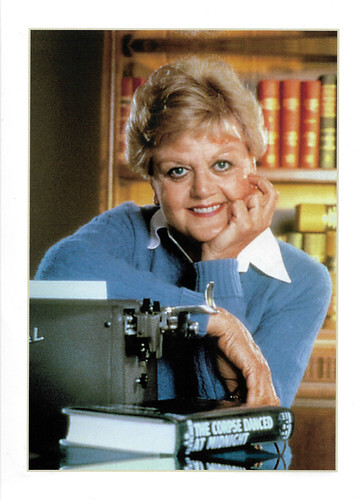
French double postcard by Polygram for the 2007 DVD release of Murder, She Wrote (1984-1985). Photo: Polygram / Universal. The French title of the series is Arabesque.
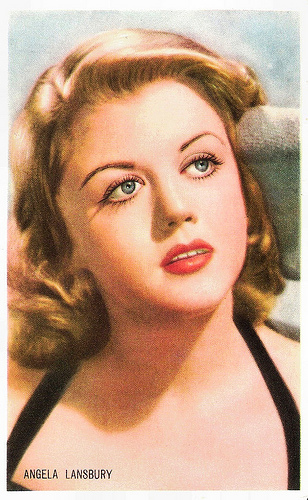
Belgian collectors card by Kwatta, Bois - D'Haine, no. C 301. Photo: Metro-Goldwyn-Mayer. Publicity still for The Three Musketeers (George Sidney, 1948).
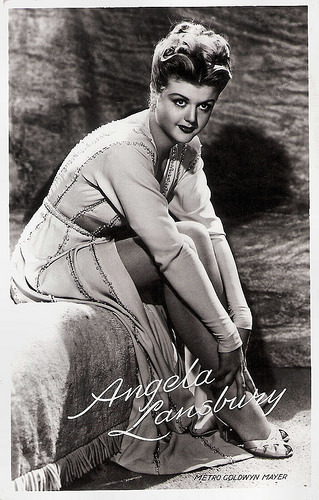
Dutch postcard by Takken, no. 166. Photo: Metro-Goldwyn-Mayer.
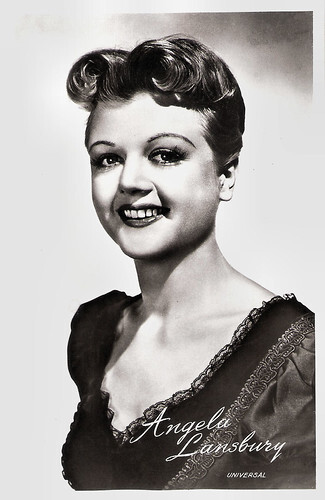
Dutch postcard by Uitg. Takken, Utrecht, no. 1741. Photo: Universal.
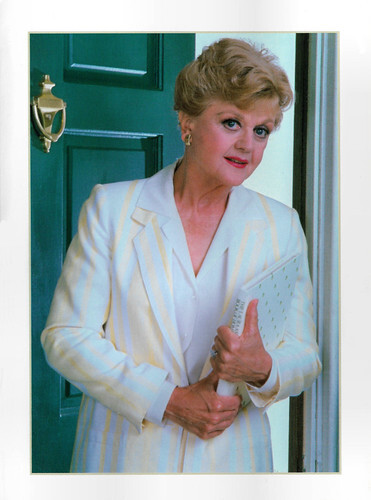
French double postcard by Polygram for the 2007 DVD release of Murder, She Wrote (1984-1985). Photo: Polygram / Universal. The French title of the series is Arabesque.
The other woman
Angela Brigid Lansbury was born in Regent Park, London in 1925. She was the daughter of actress Moyna MacGill, and timber merchant and politician Edward Lansbury, who died when she was only 9 years old.
Her grandfather, George Lansbury, was the British Labour Party leader in the 1930s. Her younger twin brothers were the art director and producer Edgar Lansbury and TV producer Bruce Lansbury, and her older half-sister was Isolde Denham.
Lansbury studied acting from her youth. With her mother and brothers, she departed for the United States in 1940, as the Second World War began. In New York City, Lansbury received a scholarship to study drama at the Lucy Fagan school. She was contracted by MGM while still a teenager.
Lansbury was nominated for an Academy Award for her first film, Gaslight (George Cukor, 1944). Opposite Ingrid Bergman and Charles Boyer , she played the housemaid Nancy. Two pictures later, she was again nominated for Best Supporting Actress, this time for playing dance hall lady Sibyl Vane in The Picture of Dorian Gray (Albert Lewin, 1945), based on Oscar Wilde’s story of a man who makes a supernatural pact to remain young at a high cost. She did win a Golden Globe for her supporting role in this film.
Lansbury landed other major roles, including that of Elizabeth Taylor ’s older sister in National Velvet (Clarence Brown, 1944) and opposite Judy Garland in the musical The Harvey Girls (George Sidney, 1946). Now established as a supporting player of quality, she began a long career, often as 'the other woman' in major productions and as the leading lady in lesser films.
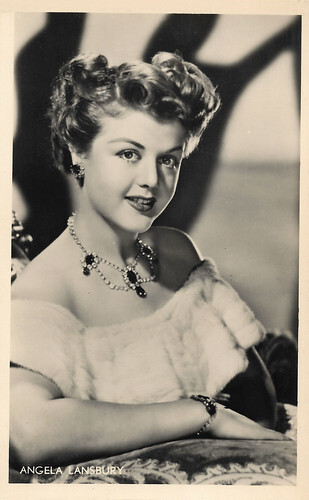
Dutch postcard by P.F. Cladder, Amsterdam, no. 49-42 kk. Photo: M.G.M.
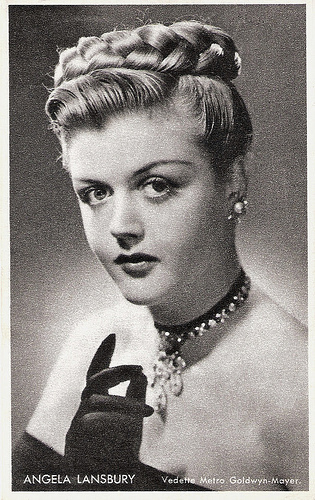
Belgian collectors card by Kwatta, Bois - D'Haine, no. C 8. Photo: Metro-Goldwyn-Mayer.
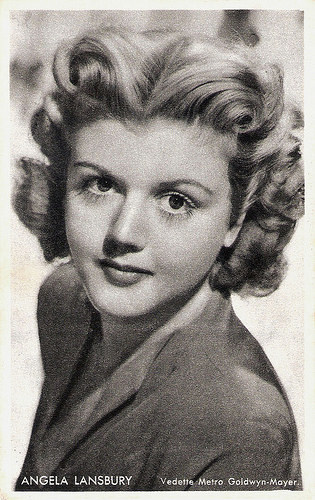
Belgian collectors card by Kwatta, Bois - D'Haine. Photo: Metro-Goldwyn-Mayer.
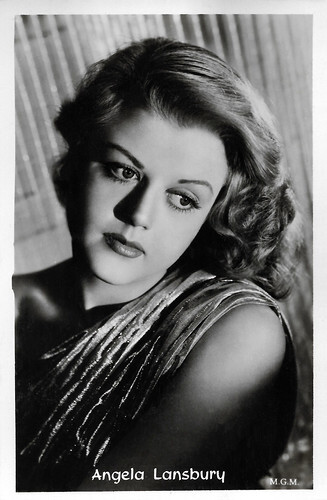
Belgian postcard by Nieuwe Merksemsche Chocolaterie, Merksem (Anvers). Photo: M.G.M.
The manipulating mother
Angela Lansbury became an American citizen in 1951. She appeared as Princess Gwendolyn opposite Danny Kaye in the comedy film The Court Jester (Melvin Frank, 1956), as Minnie Littlejohn in The Long Hot Summer (Martin Ritt, 1958), and as Mabel Claremont in The Reluctant Debutante (Vincente Minelli, 1958).
Her features, while not at all old-appearing, gave her an air of maturity that allowed her to pass as much older than she actually was. She began playing mother roles, often to players of her own age, while yet in her thirties. Lansbury played Elvis Presley 's mother in Blue Hawaii (Norman Taurog, 1961), despite only being 10 years older than him.
She was also the manipulating mother of Laurence Harvey in the Cold War thriller The Manchurian Candidate (John Frankenheimer, 1962), while in real life being scarcely three years Harvey's senior. The latter brought her a third Academy Award nomination for supporting actress.
Other film roles included The Amorous Adventures of Moll Flanders (Terence Young, 1965) starring Kim Novak , and the biblical epic The Greatest Story Ever Told (George Stevens, 1965), featuring Max von Sydow as Jesus. In the partially-animated Disney musical Bedknobs and Broomsticks (Robert Stevenson, 1971), she played the witch, Miss Price.
However, she concentrated more and more on stage work. She made her Broadway debut in 1957 with the play Hotel Paradiso, a French burlesque set in Paris, directed by Peter Glenville. A role in the drama A Taste of Honey (1961) and the Stephen Sondheim musical Anyone Can Whistle (1964) followed.
She achieved notable success in a number of Broadway musicals. She has been the co-recipient of 4 Grammy Awards for her leading roles in the musicals Mame (1966), Dear World (1969), Gypsy (1975) and Sweeney Todd (1979).
In 2007, she returned to Broadway after more than two decades, performing in the show Deuce. Lansbury played a former tennis pro who reunites with her doubles partner for an honours ceremony at the U.S. Open. Two years later, she won the Tony for Best Featured Actress in a Play for Blithe Spirit, the revival of a Noel Coward play about a man who is haunted by the ghost of his ex-wife. Lansbury continued her stage work, playing Madame Armfeldt in the 2009 revival of Stephen Sondheim's A Little Night Music, opposite Catherine Zeta-Jones , and in 2012 taking on a lead role in the Gore Vidal satire The Best Man.
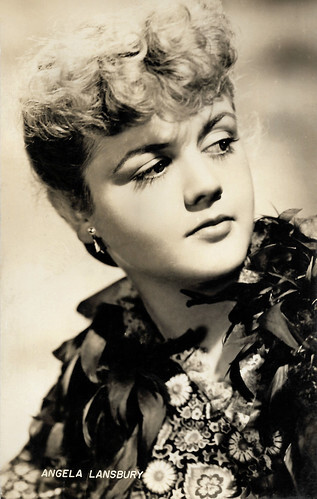
Vintage card.
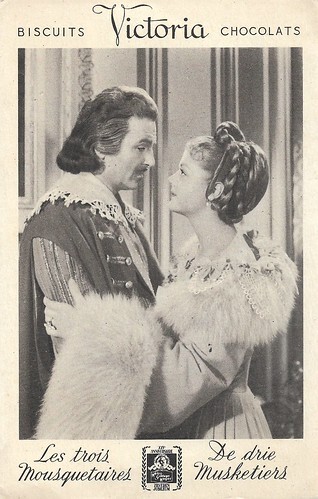
Belgian postcard by Victoria Biscuits Chocolats, no. 9. Photo: M.G.M. John Sutton as The Duke of Buckingham and Angela Lansbury as Queen Anne in The Three Musketeers (George Sidney, 1948), based on the novel by Alexandre Dumas.
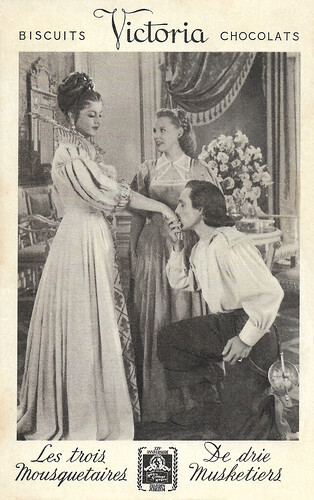
Belgian postcard by Victoria Biscuits Chocolats, no. 12. Photo: M.G.M. Angela Lansbury, June Allyson and Gene Kelly in The Three Musketeers (George Sidney, 1948), based on the novel by Alexandre Dumas.
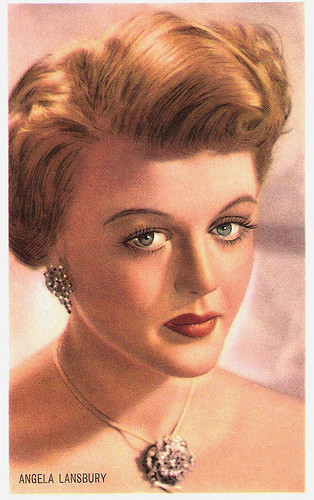
Belgian collectors card by Kwatta, Bois - D'Haine, no. C 238. Photo: Metro-Goldwyn-Mayer. Publicity still for The Red Danube (George Sidney, 1949).
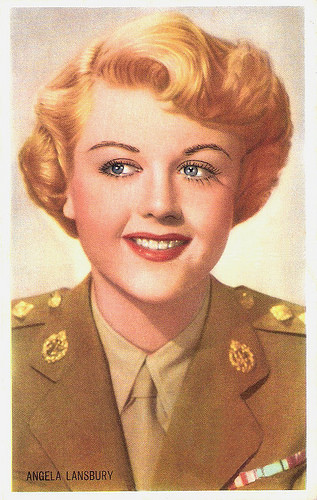
Belgian collectors card by Kwatta, Bois - D'Haine, no. C 280. Photo: Metro-Goldwyn-Mayer. Publicity still for The Red Danube (George Sidney, 1949).
Her greatest success
Angela Lansbury alternated between film, television and the stage for years. In the cinema, Lansbury appeared in 1979 as Miss Froy in The Lady Vanishes (Anthony Page, 1979), a remake of Alfred Hitchcock 's famous 1938 film. The following year she appeared in The Mirror Crack'd (Guy Hamilton, 1980), another film based on an Agatha Christie novel, this time as Miss Marple, a sleuth in 1950s Kent. She also played the grandmother in the Gothic fantasy film The Company of Wolves (Neil Jordan, 1984).
That same year, she obtained her greatest success as Jessica Fletcher in the light mystery TV show Murder, She Wrote (1984). For her 12-year stint as the diplomatic, clever and kind fictional writer and sleuth, she became known and loved. From 1985 to 1996, she yearly got Emmy Award nominations for the role without ever winning it. Eventually, she took over production duties for the show as well.
In 2005, she made a notable appearance on Law & Order: Special Victims Unit, which earned her an Emmy Award nomination for Outstanding Guest Actress in a Drama Series. She also voiced several animated characters for films like Beauty and the Beast (Gary Trousdale, Kirk Wise, 1991), in which she voiced Mrs. Potts.
Jim Beaver at IMDb : “An institution in American theatre and television, she is also an inspiration for the graciousness of her personality, which is often exploited and always admired.”
Lansbury was married twice. Her first marriage was to American actor Richard Cromwell. It ended after a year in divorce. A recent authorised biography, 'Balancing Act', states that Cromwell was gay, a fact she didn't know until after their separation. Her second husband was British actor Peter Shaw, from 1949 till his death in 2003. Shaw became her manager and launched a production company that would be heavily involved in Murder, She Wrote. The couple had two children, Anthony Pullen Shaw (1952) and Deirdre Angela Shaw (1953).
Angela Lansbury was awarded the CBE (Commander of the Order of the British Empire) in 1994 and the DBE (Dame Commander of the Order of the British Empire) in 2014. A year later, she triumphantly returned to London's West End stage after a forty-year absence. She starred in her Tony-winning role as Madam Arcati in Blithe Spirit. For this role, she won her only Laurence Olivier award for Best Supporting Actress in 2015.
Angela Lansbury died in her sleep at her home in Los Angeles, California, on the morning of 11 October 2022, at the age of 96, five days before her 97th birthday.
Trailer for Gaslight (George Cukor, 1945). Source: Warner Bros. (YouTube).
Trailer for Something for Everyone (Harold Prince, 1970). Source: Dukece (YouTube).
Trailer The Mirror Crack'd (Guy Hamilton, 1980). Source: Mr80sMovies (YouTube).
Trailer The Company Of Wolves Trailer (Neil Jordan, 1985). Source: Video Detective (YouTube).
Sources: (IMDb), Biography.com, Wikipedia and .

French double postcard by Polygram for the 2007 DVD release of Murder, She Wrote (1984-1985). Photo: Polygram / Universal. The French title of the series is Arabesque.

Belgian collectors card by Kwatta, Bois - D'Haine, no. C 301. Photo: Metro-Goldwyn-Mayer. Publicity still for The Three Musketeers (George Sidney, 1948).

Dutch postcard by Takken, no. 166. Photo: Metro-Goldwyn-Mayer.

Dutch postcard by Uitg. Takken, Utrecht, no. 1741. Photo: Universal.

French double postcard by Polygram for the 2007 DVD release of Murder, She Wrote (1984-1985). Photo: Polygram / Universal. The French title of the series is Arabesque.
The other woman
Angela Brigid Lansbury was born in Regent Park, London in 1925. She was the daughter of actress Moyna MacGill, and timber merchant and politician Edward Lansbury, who died when she was only 9 years old.
Her grandfather, George Lansbury, was the British Labour Party leader in the 1930s. Her younger twin brothers were the art director and producer Edgar Lansbury and TV producer Bruce Lansbury, and her older half-sister was Isolde Denham.
Lansbury studied acting from her youth. With her mother and brothers, she departed for the United States in 1940, as the Second World War began. In New York City, Lansbury received a scholarship to study drama at the Lucy Fagan school. She was contracted by MGM while still a teenager.
Lansbury was nominated for an Academy Award for her first film, Gaslight (George Cukor, 1944). Opposite Ingrid Bergman and Charles Boyer , she played the housemaid Nancy. Two pictures later, she was again nominated for Best Supporting Actress, this time for playing dance hall lady Sibyl Vane in The Picture of Dorian Gray (Albert Lewin, 1945), based on Oscar Wilde’s story of a man who makes a supernatural pact to remain young at a high cost. She did win a Golden Globe for her supporting role in this film.
Lansbury landed other major roles, including that of Elizabeth Taylor ’s older sister in National Velvet (Clarence Brown, 1944) and opposite Judy Garland in the musical The Harvey Girls (George Sidney, 1946). Now established as a supporting player of quality, she began a long career, often as 'the other woman' in major productions and as the leading lady in lesser films.

Dutch postcard by P.F. Cladder, Amsterdam, no. 49-42 kk. Photo: M.G.M.

Belgian collectors card by Kwatta, Bois - D'Haine, no. C 8. Photo: Metro-Goldwyn-Mayer.

Belgian collectors card by Kwatta, Bois - D'Haine. Photo: Metro-Goldwyn-Mayer.

Belgian postcard by Nieuwe Merksemsche Chocolaterie, Merksem (Anvers). Photo: M.G.M.
The manipulating mother
Angela Lansbury became an American citizen in 1951. She appeared as Princess Gwendolyn opposite Danny Kaye in the comedy film The Court Jester (Melvin Frank, 1956), as Minnie Littlejohn in The Long Hot Summer (Martin Ritt, 1958), and as Mabel Claremont in The Reluctant Debutante (Vincente Minelli, 1958).
Her features, while not at all old-appearing, gave her an air of maturity that allowed her to pass as much older than she actually was. She began playing mother roles, often to players of her own age, while yet in her thirties. Lansbury played Elvis Presley 's mother in Blue Hawaii (Norman Taurog, 1961), despite only being 10 years older than him.
She was also the manipulating mother of Laurence Harvey in the Cold War thriller The Manchurian Candidate (John Frankenheimer, 1962), while in real life being scarcely three years Harvey's senior. The latter brought her a third Academy Award nomination for supporting actress.
Other film roles included The Amorous Adventures of Moll Flanders (Terence Young, 1965) starring Kim Novak , and the biblical epic The Greatest Story Ever Told (George Stevens, 1965), featuring Max von Sydow as Jesus. In the partially-animated Disney musical Bedknobs and Broomsticks (Robert Stevenson, 1971), she played the witch, Miss Price.
However, she concentrated more and more on stage work. She made her Broadway debut in 1957 with the play Hotel Paradiso, a French burlesque set in Paris, directed by Peter Glenville. A role in the drama A Taste of Honey (1961) and the Stephen Sondheim musical Anyone Can Whistle (1964) followed.
She achieved notable success in a number of Broadway musicals. She has been the co-recipient of 4 Grammy Awards for her leading roles in the musicals Mame (1966), Dear World (1969), Gypsy (1975) and Sweeney Todd (1979).
In 2007, she returned to Broadway after more than two decades, performing in the show Deuce. Lansbury played a former tennis pro who reunites with her doubles partner for an honours ceremony at the U.S. Open. Two years later, she won the Tony for Best Featured Actress in a Play for Blithe Spirit, the revival of a Noel Coward play about a man who is haunted by the ghost of his ex-wife. Lansbury continued her stage work, playing Madame Armfeldt in the 2009 revival of Stephen Sondheim's A Little Night Music, opposite Catherine Zeta-Jones , and in 2012 taking on a lead role in the Gore Vidal satire The Best Man.

Vintage card.

Belgian postcard by Victoria Biscuits Chocolats, no. 9. Photo: M.G.M. John Sutton as The Duke of Buckingham and Angela Lansbury as Queen Anne in The Three Musketeers (George Sidney, 1948), based on the novel by Alexandre Dumas.

Belgian postcard by Victoria Biscuits Chocolats, no. 12. Photo: M.G.M. Angela Lansbury, June Allyson and Gene Kelly in The Three Musketeers (George Sidney, 1948), based on the novel by Alexandre Dumas.

Belgian collectors card by Kwatta, Bois - D'Haine, no. C 238. Photo: Metro-Goldwyn-Mayer. Publicity still for The Red Danube (George Sidney, 1949).

Belgian collectors card by Kwatta, Bois - D'Haine, no. C 280. Photo: Metro-Goldwyn-Mayer. Publicity still for The Red Danube (George Sidney, 1949).
Her greatest success
Angela Lansbury alternated between film, television and the stage for years. In the cinema, Lansbury appeared in 1979 as Miss Froy in The Lady Vanishes (Anthony Page, 1979), a remake of Alfred Hitchcock 's famous 1938 film. The following year she appeared in The Mirror Crack'd (Guy Hamilton, 1980), another film based on an Agatha Christie novel, this time as Miss Marple, a sleuth in 1950s Kent. She also played the grandmother in the Gothic fantasy film The Company of Wolves (Neil Jordan, 1984).
That same year, she obtained her greatest success as Jessica Fletcher in the light mystery TV show Murder, She Wrote (1984). For her 12-year stint as the diplomatic, clever and kind fictional writer and sleuth, she became known and loved. From 1985 to 1996, she yearly got Emmy Award nominations for the role without ever winning it. Eventually, she took over production duties for the show as well.
In 2005, she made a notable appearance on Law & Order: Special Victims Unit, which earned her an Emmy Award nomination for Outstanding Guest Actress in a Drama Series. She also voiced several animated characters for films like Beauty and the Beast (Gary Trousdale, Kirk Wise, 1991), in which she voiced Mrs. Potts.
Jim Beaver at IMDb : “An institution in American theatre and television, she is also an inspiration for the graciousness of her personality, which is often exploited and always admired.”
Lansbury was married twice. Her first marriage was to American actor Richard Cromwell. It ended after a year in divorce. A recent authorised biography, 'Balancing Act', states that Cromwell was gay, a fact she didn't know until after their separation. Her second husband was British actor Peter Shaw, from 1949 till his death in 2003. Shaw became her manager and launched a production company that would be heavily involved in Murder, She Wrote. The couple had two children, Anthony Pullen Shaw (1952) and Deirdre Angela Shaw (1953).
Angela Lansbury was awarded the CBE (Commander of the Order of the British Empire) in 1994 and the DBE (Dame Commander of the Order of the British Empire) in 2014. A year later, she triumphantly returned to London's West End stage after a forty-year absence. She starred in her Tony-winning role as Madam Arcati in Blithe Spirit. For this role, she won her only Laurence Olivier award for Best Supporting Actress in 2015.
Angela Lansbury died in her sleep at her home in Los Angeles, California, on the morning of 11 October 2022, at the age of 96, five days before her 97th birthday.
Trailer for Gaslight (George Cukor, 1945). Source: Warner Bros. (YouTube).
Trailer for Something for Everyone (Harold Prince, 1970). Source: Dukece (YouTube).
Trailer The Mirror Crack'd (Guy Hamilton, 1980). Source: Mr80sMovies (YouTube).
Trailer The Company Of Wolves Trailer (Neil Jordan, 1985). Source: Video Detective (YouTube).
Sources: (IMDb), Biography.com, Wikipedia and .
Published on October 12, 2022 22:00
Paul van Yperen's Blog
- Paul van Yperen's profile
- 13 followers
Paul van Yperen isn't a Goodreads Author
(yet),
but they
do have a blog,
so here are some recent posts imported from
their feed.



